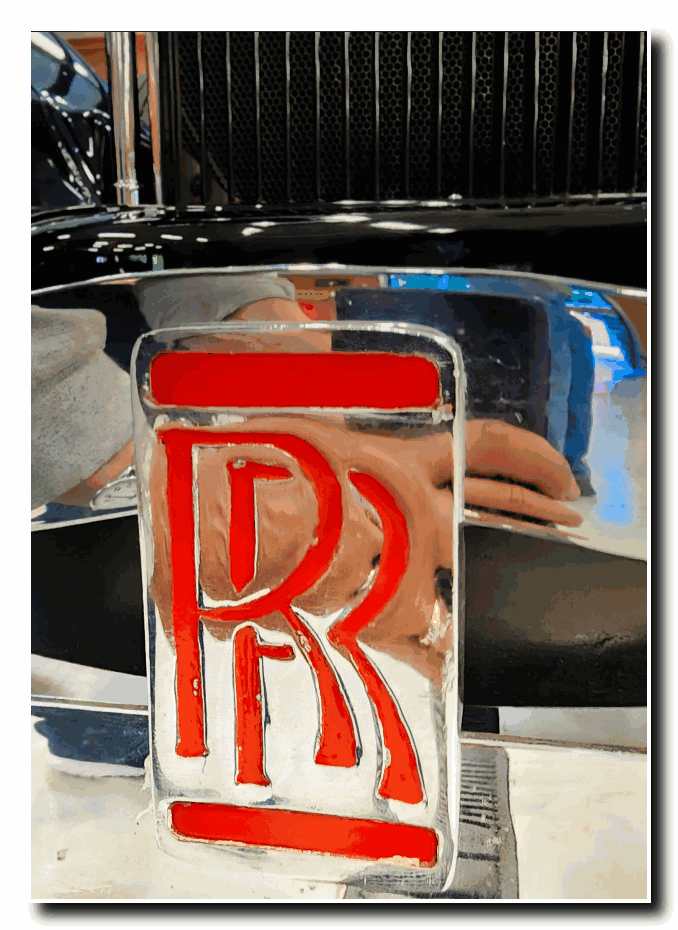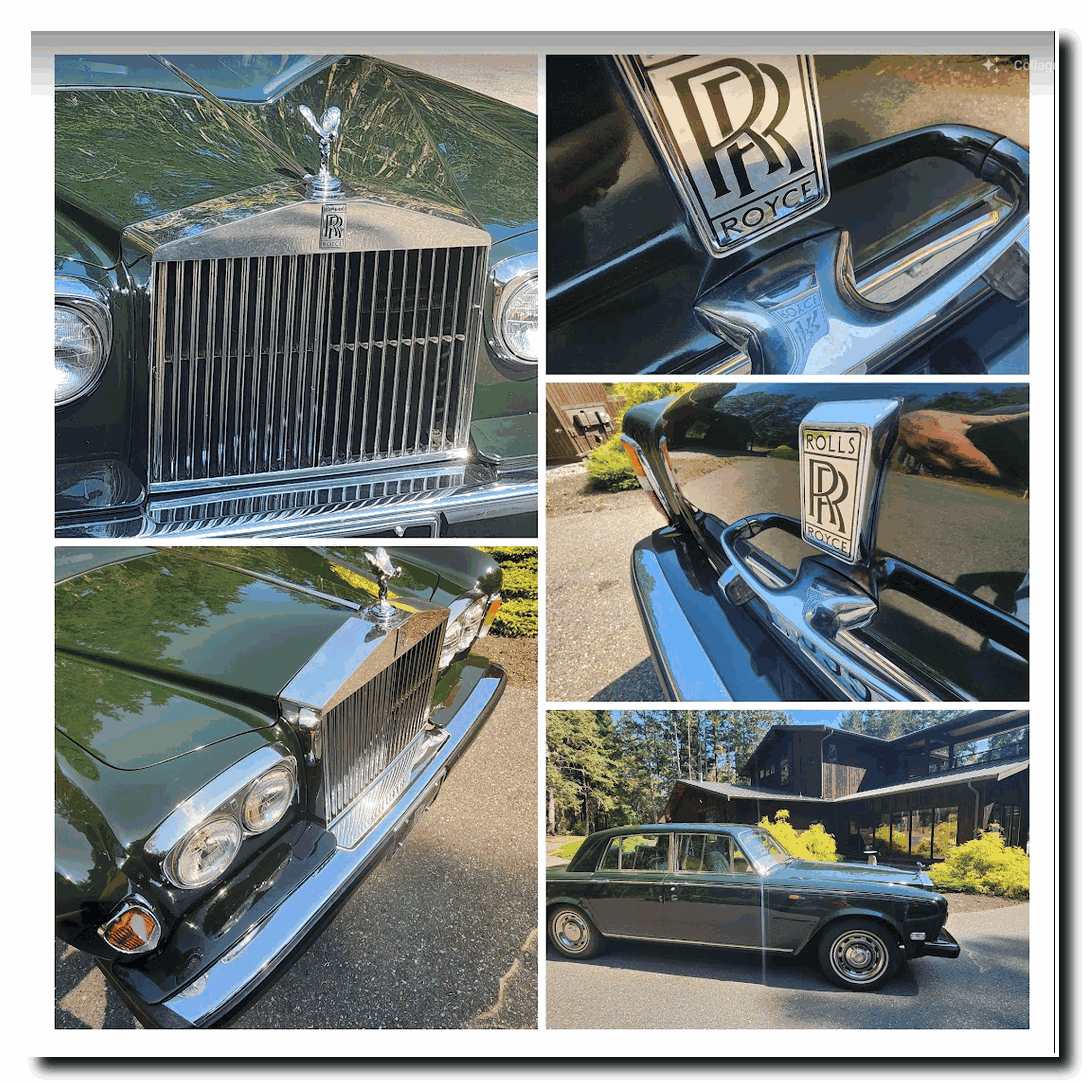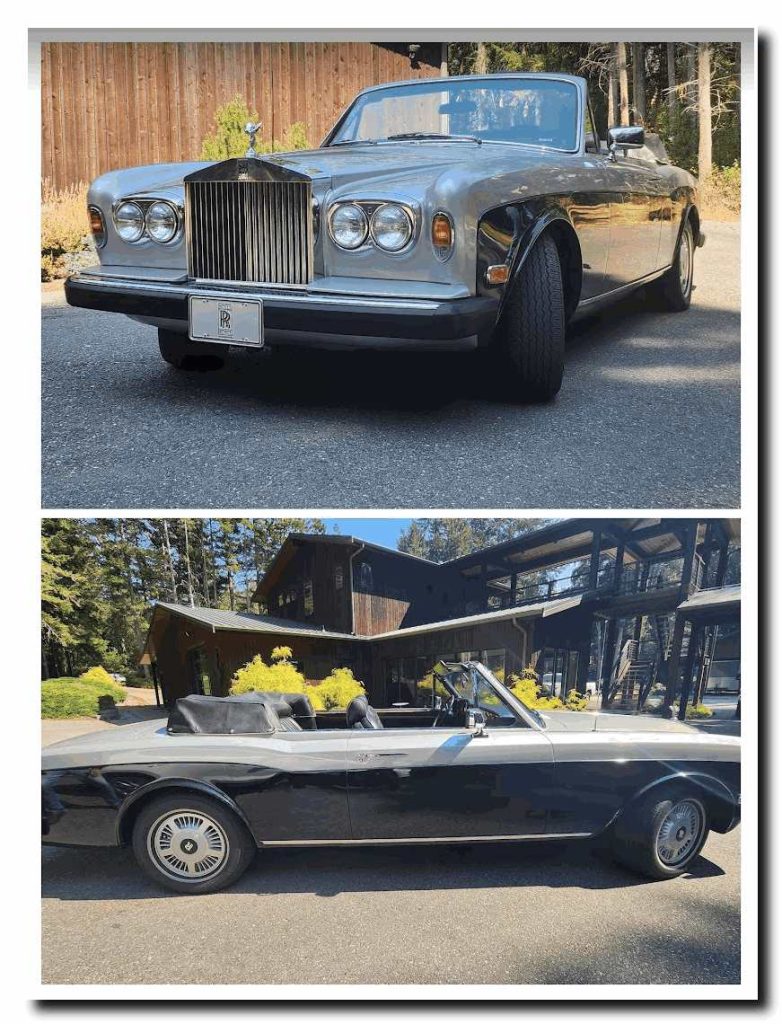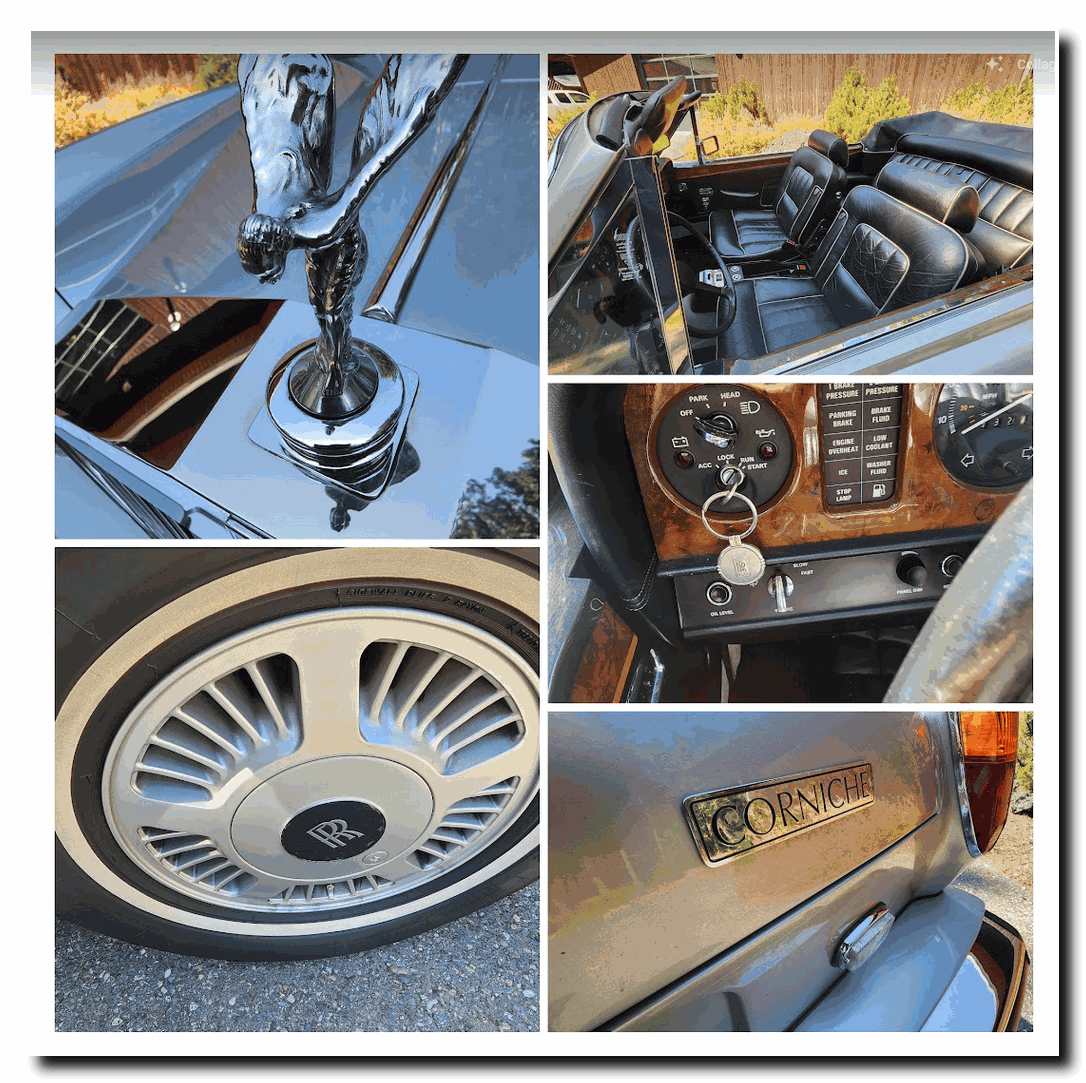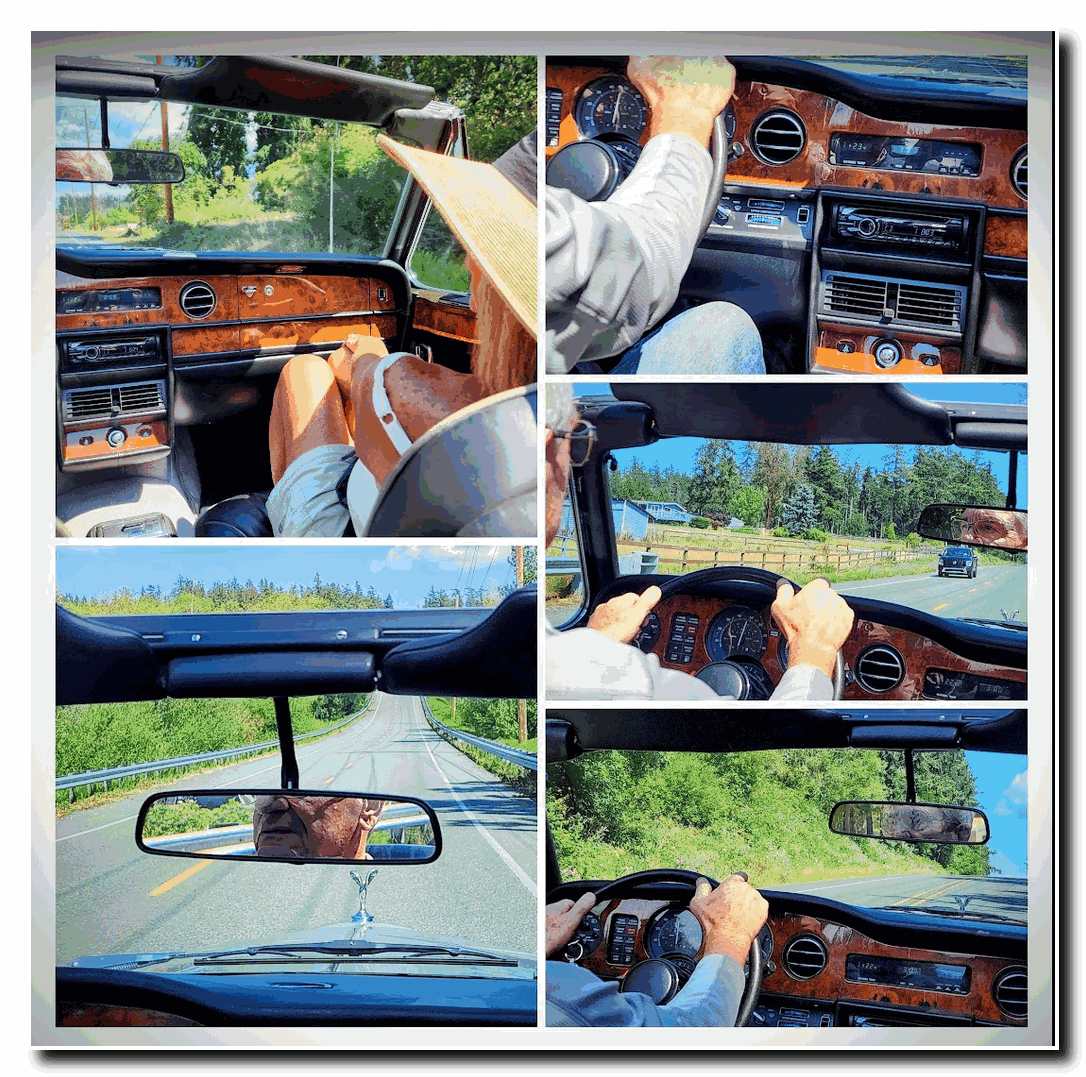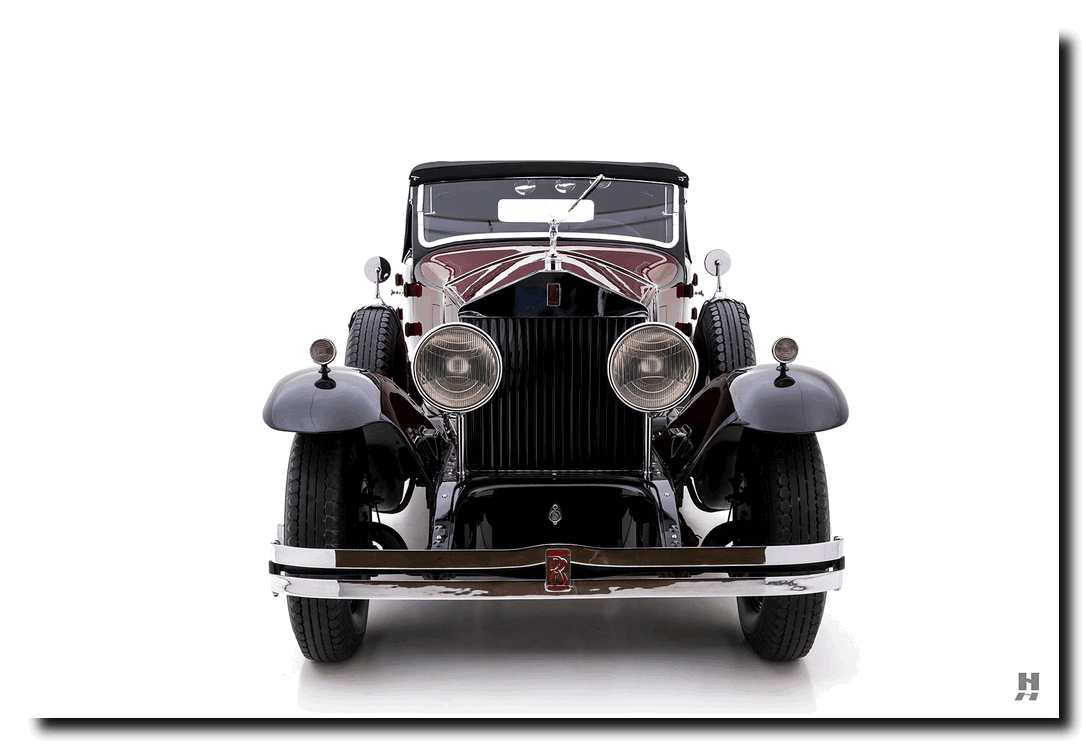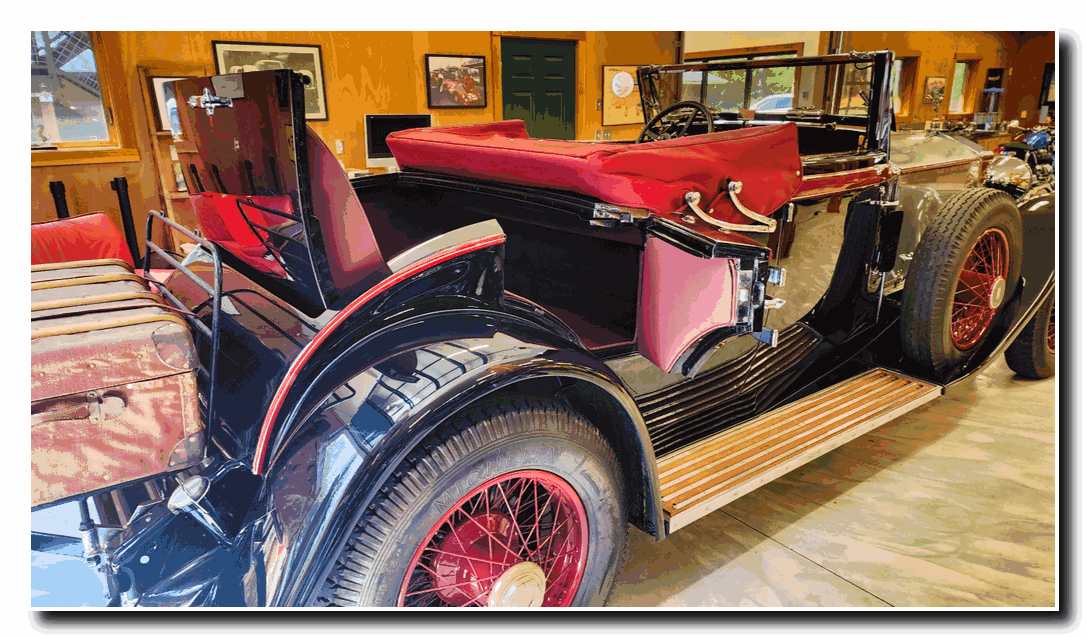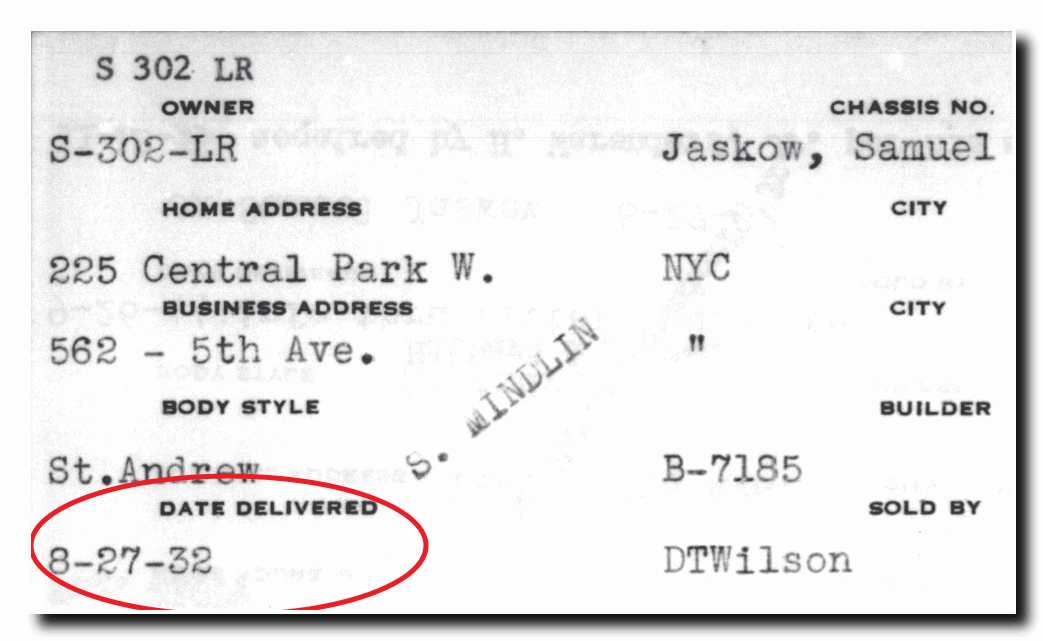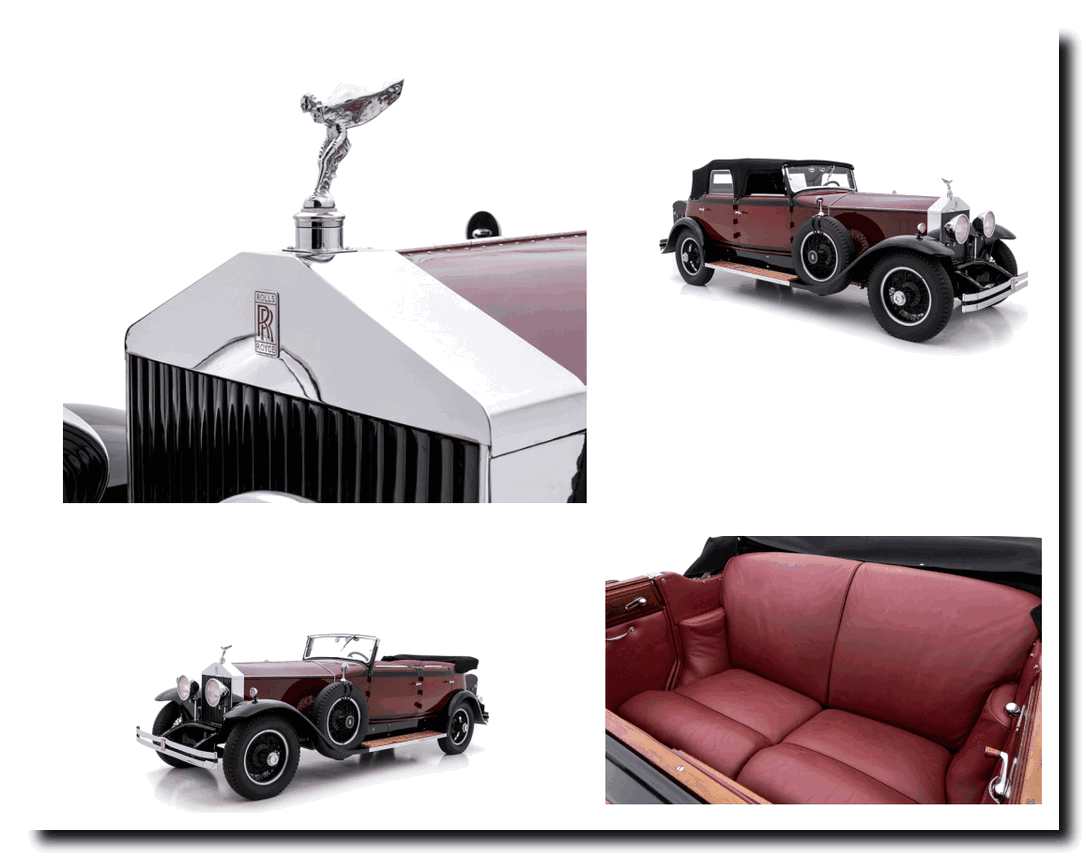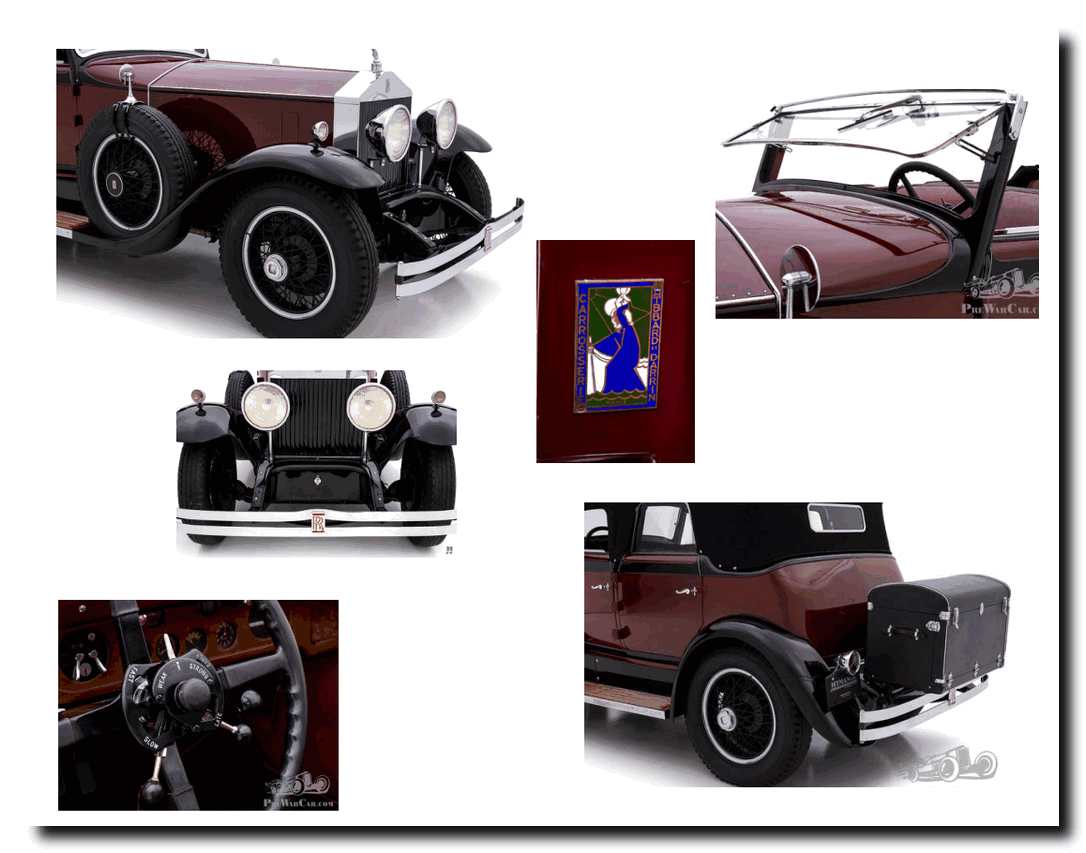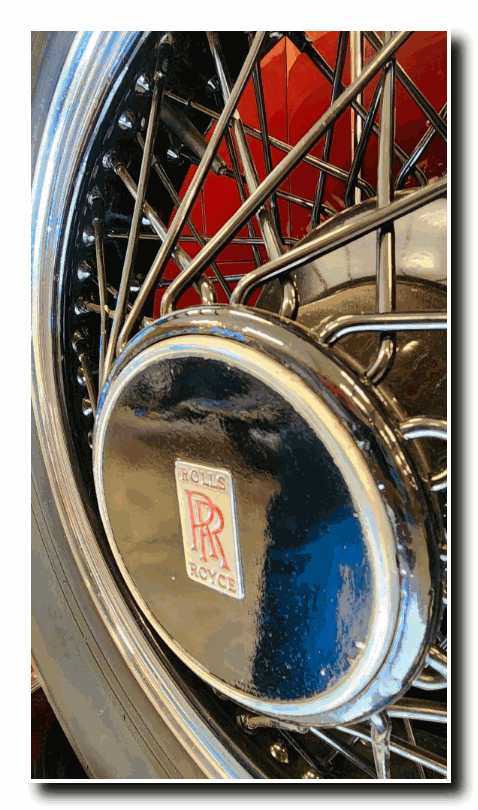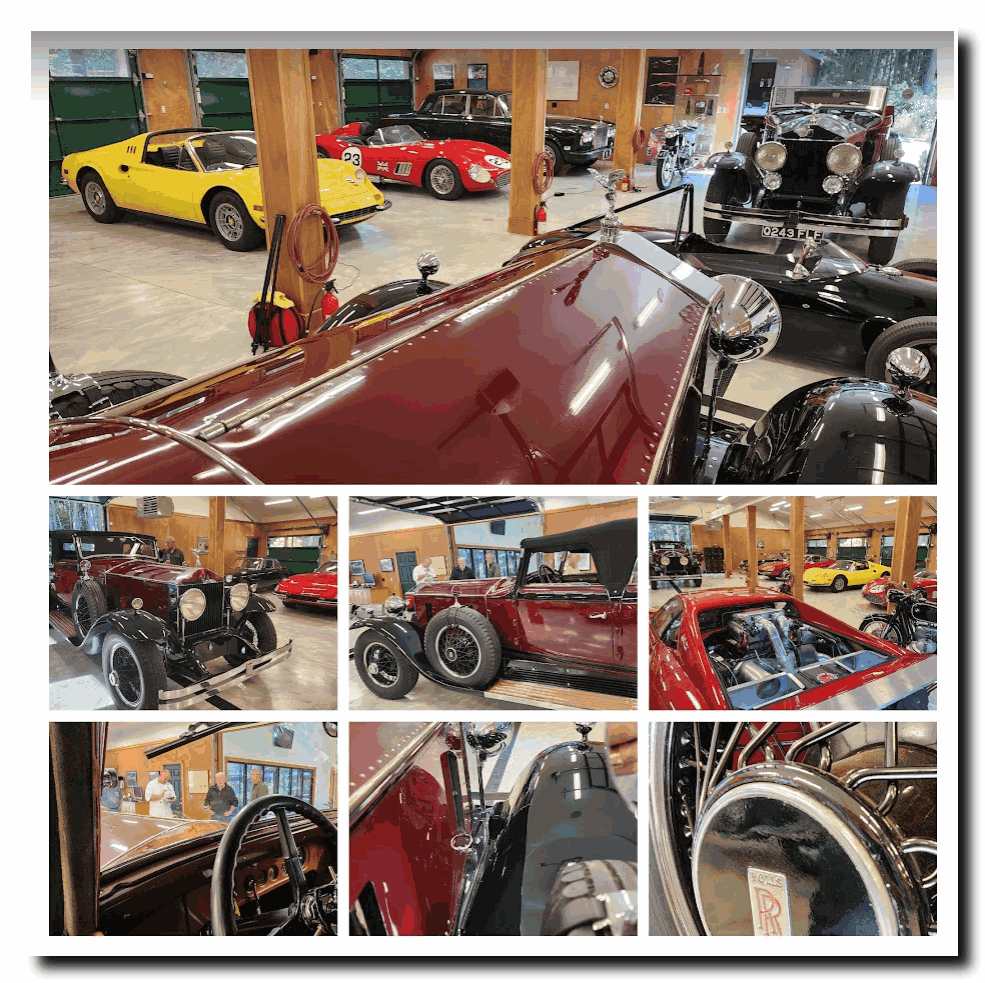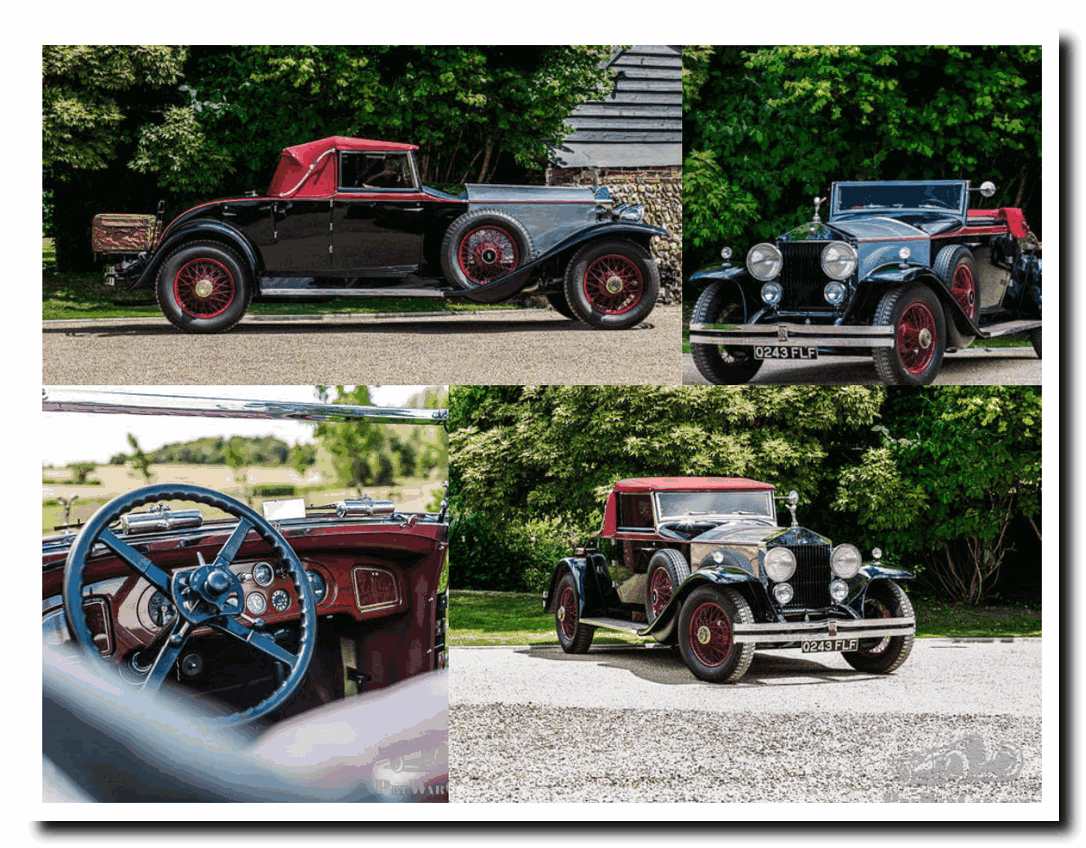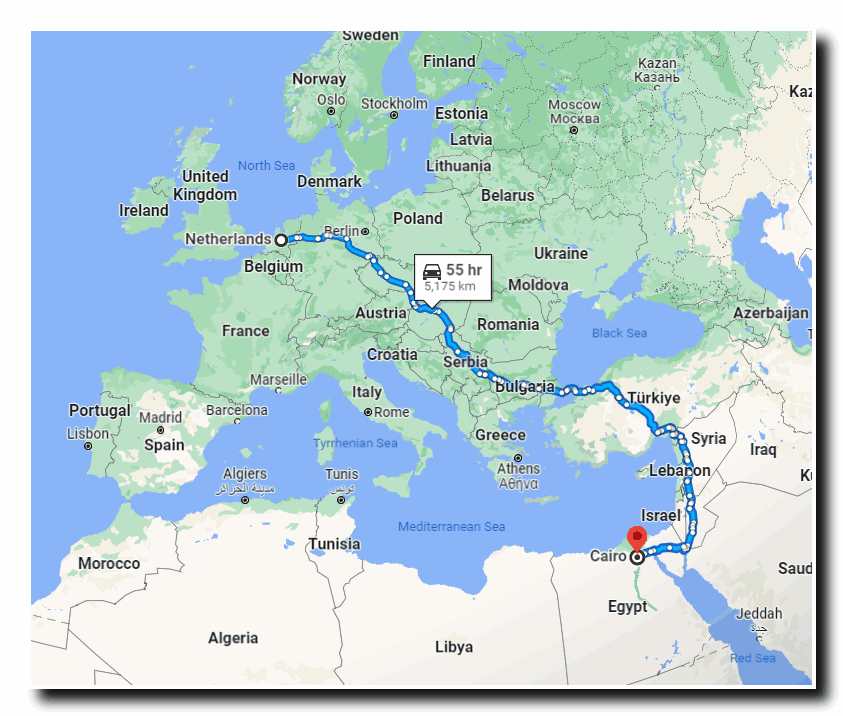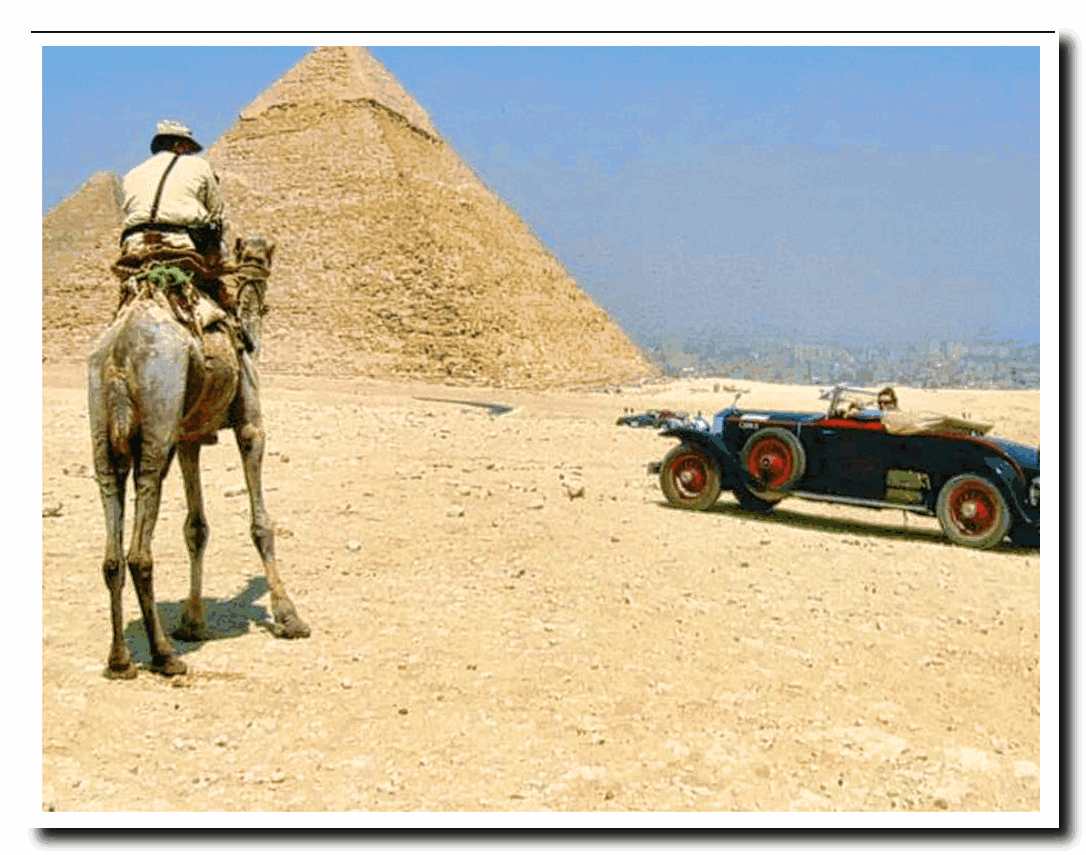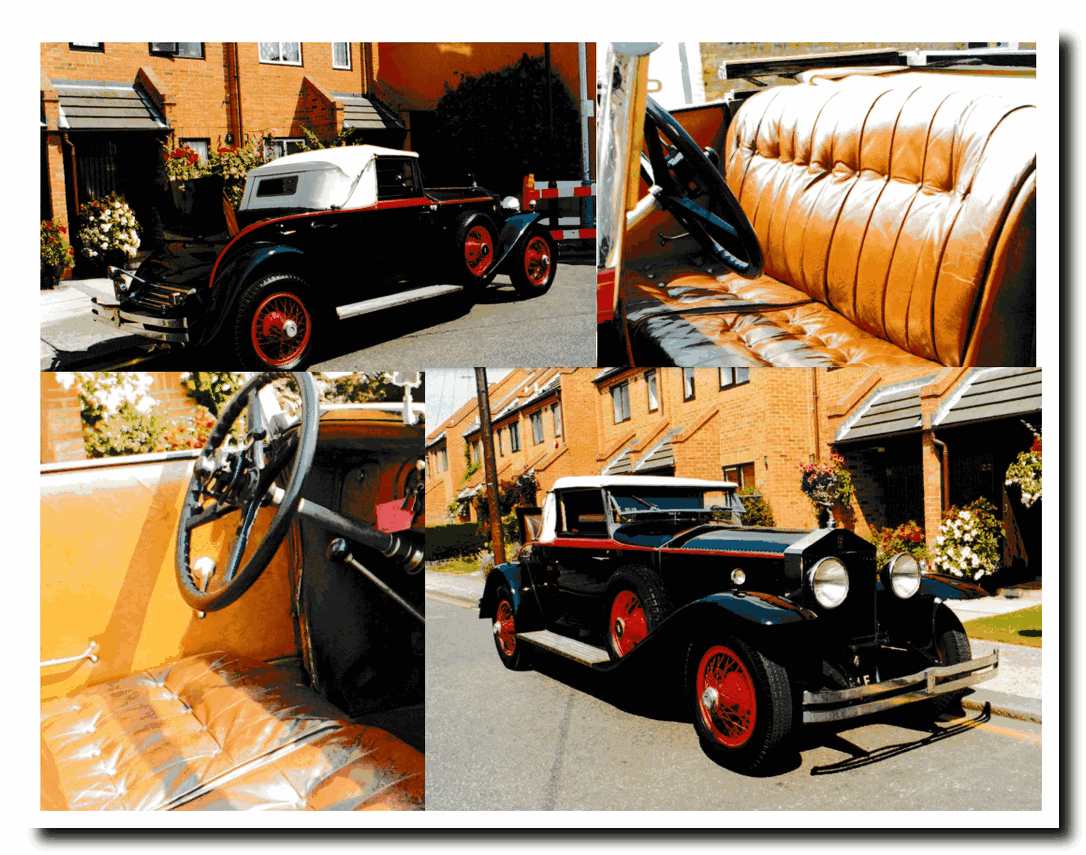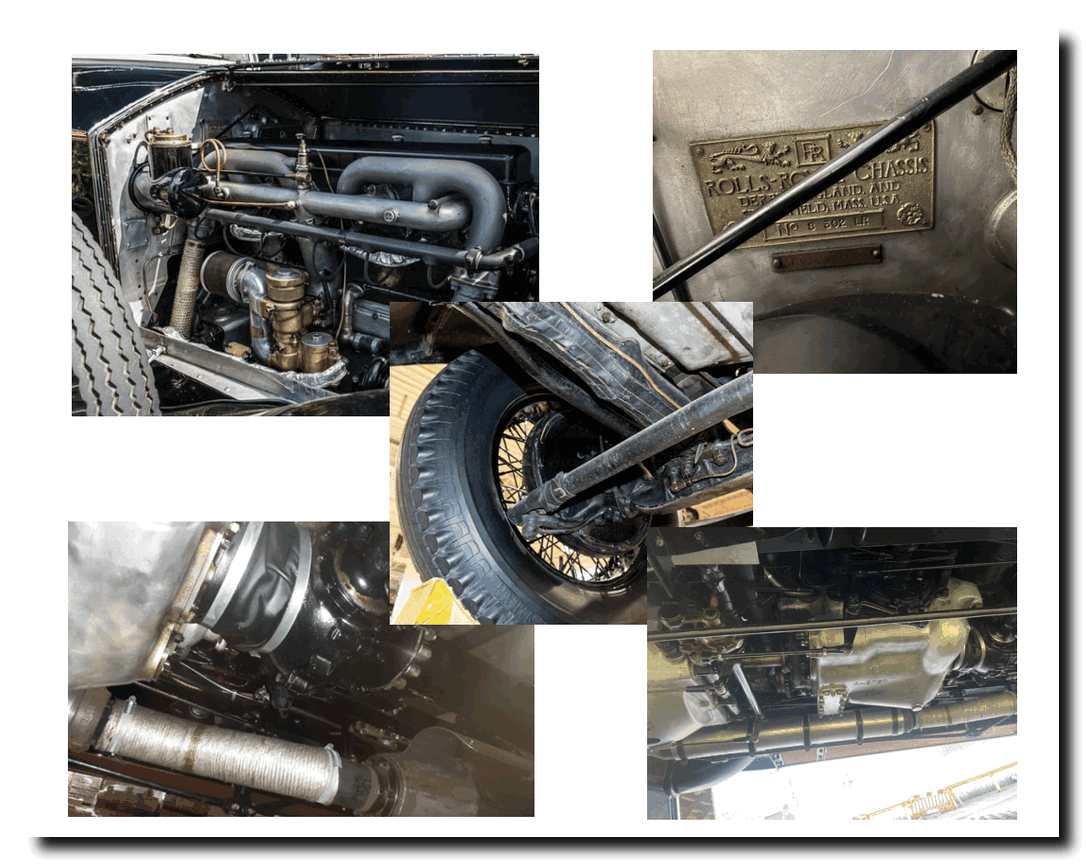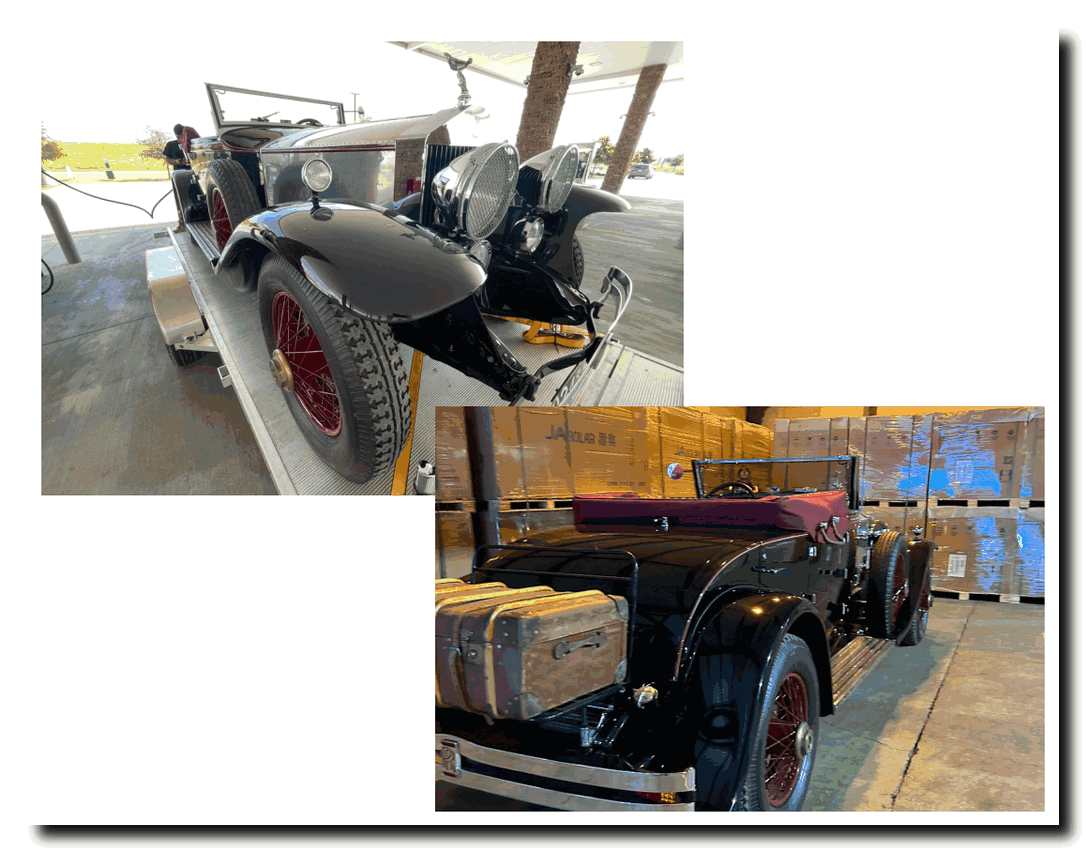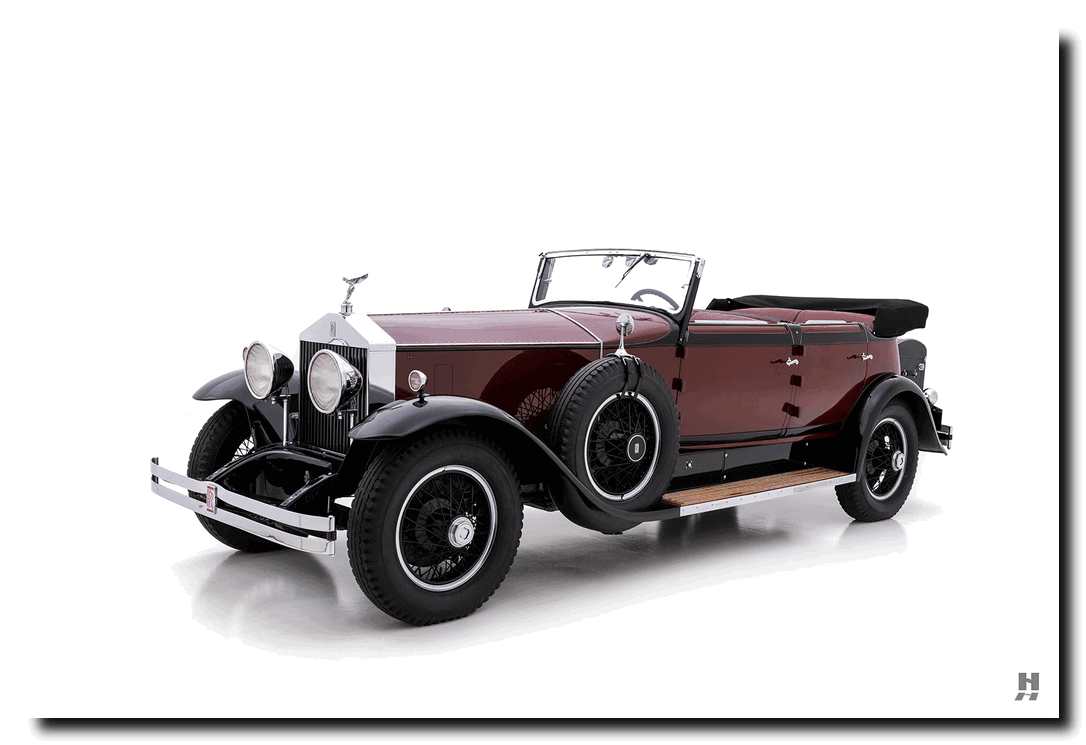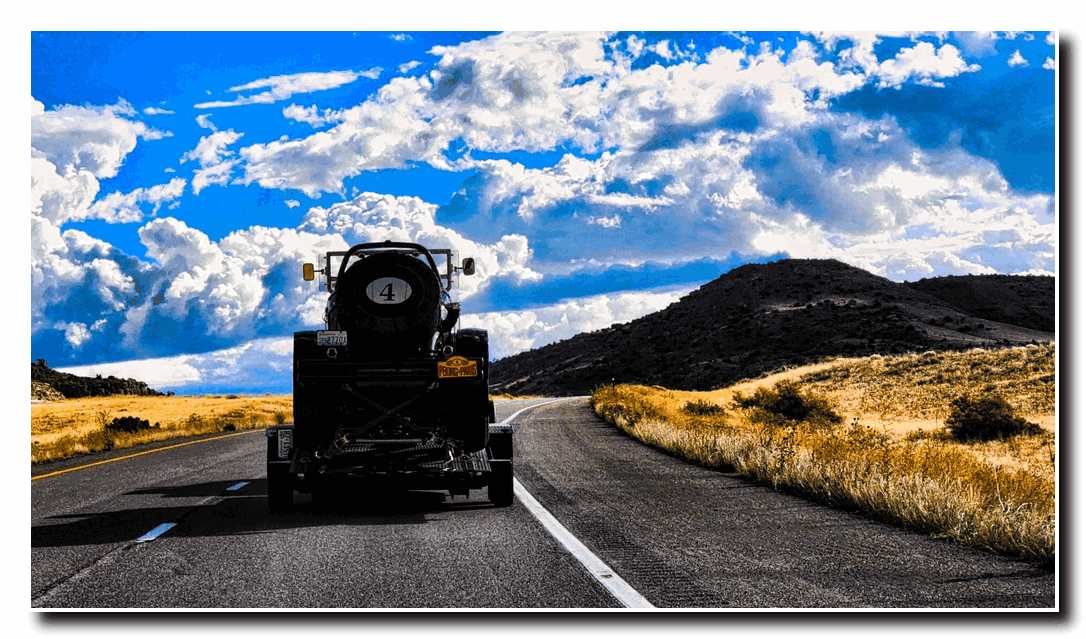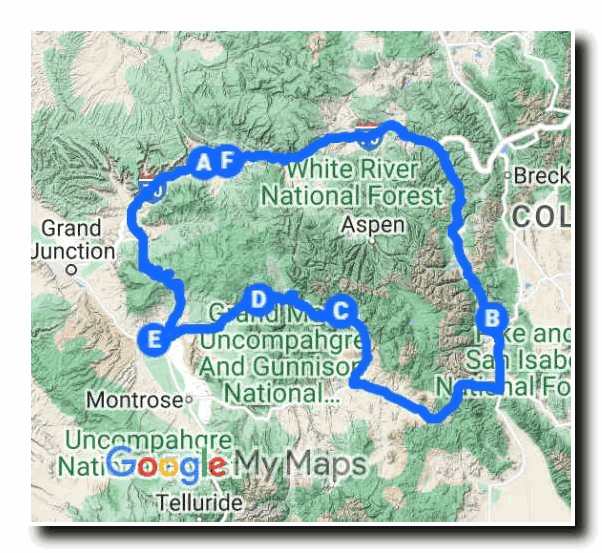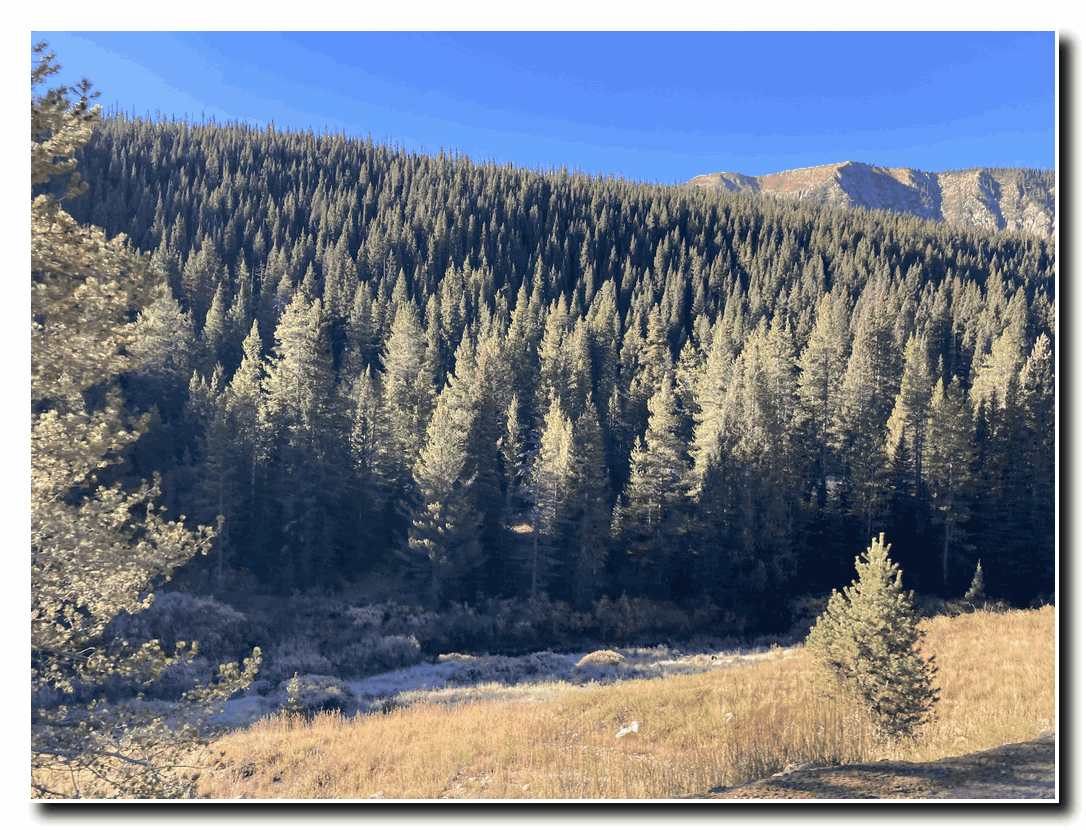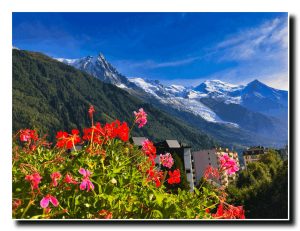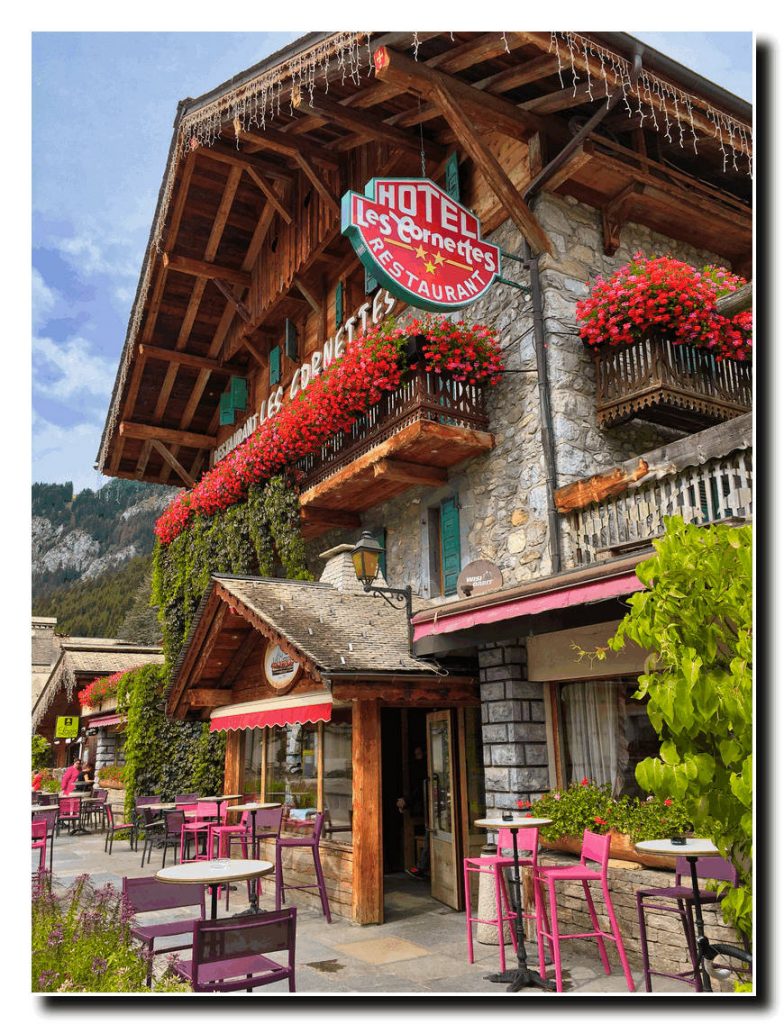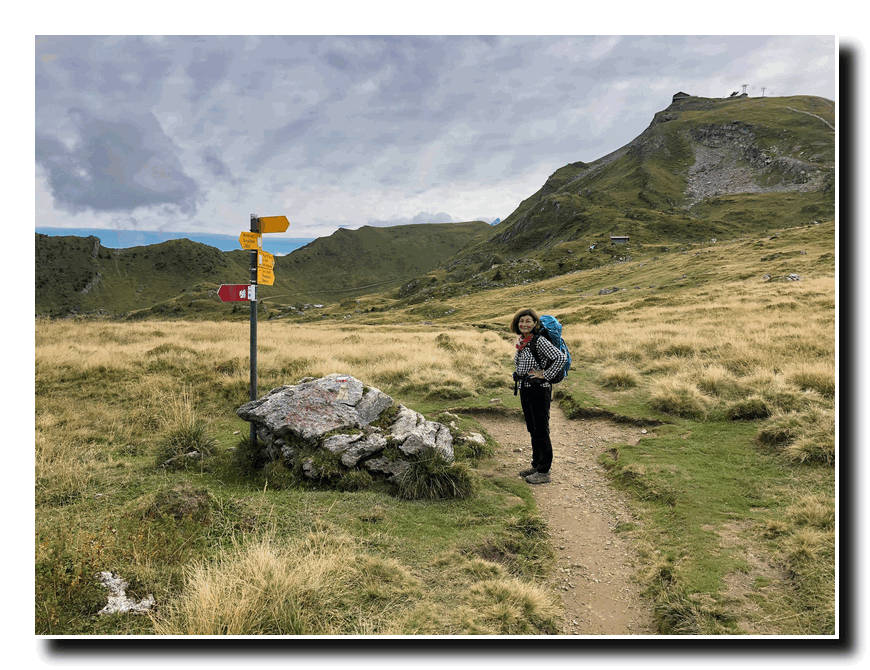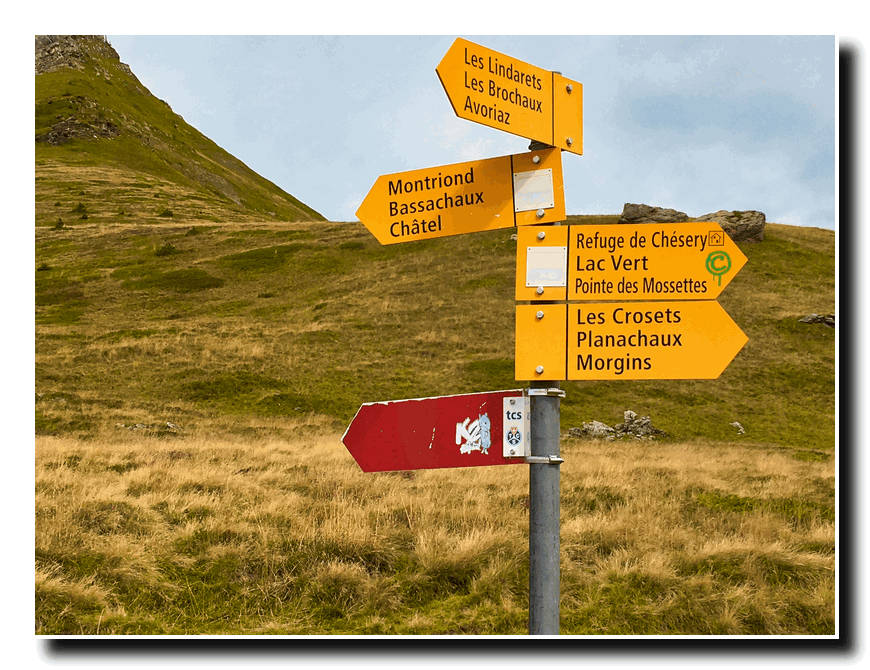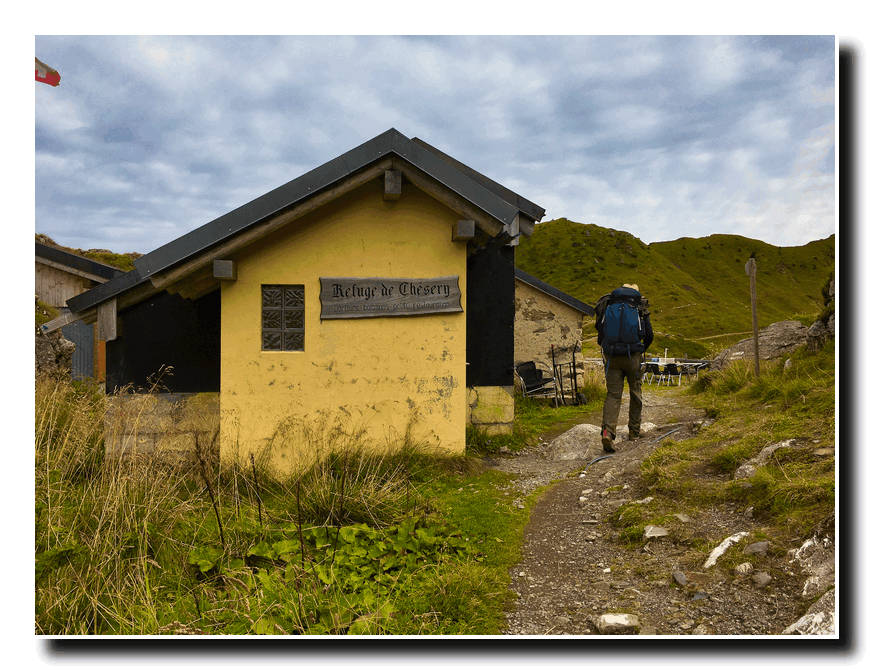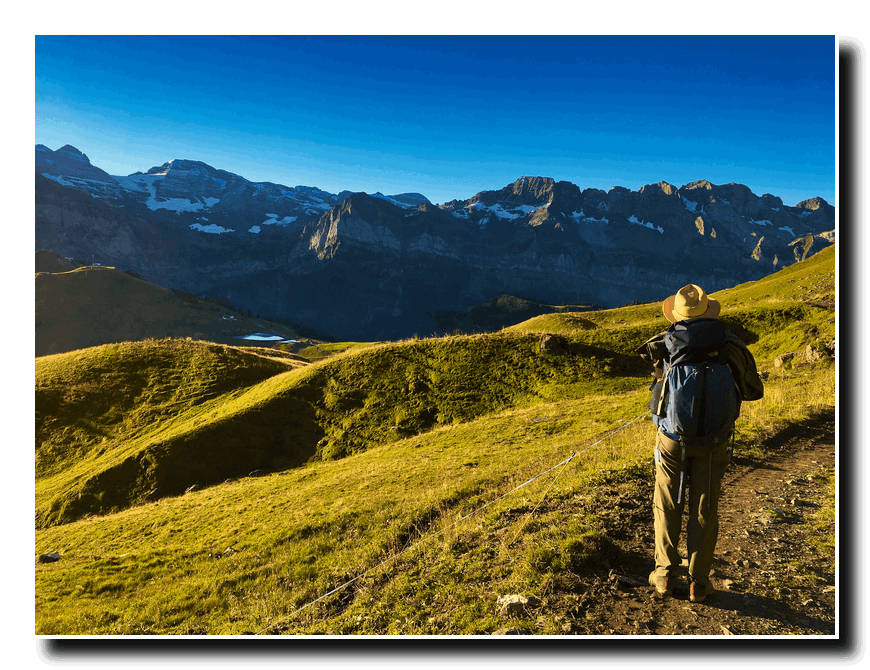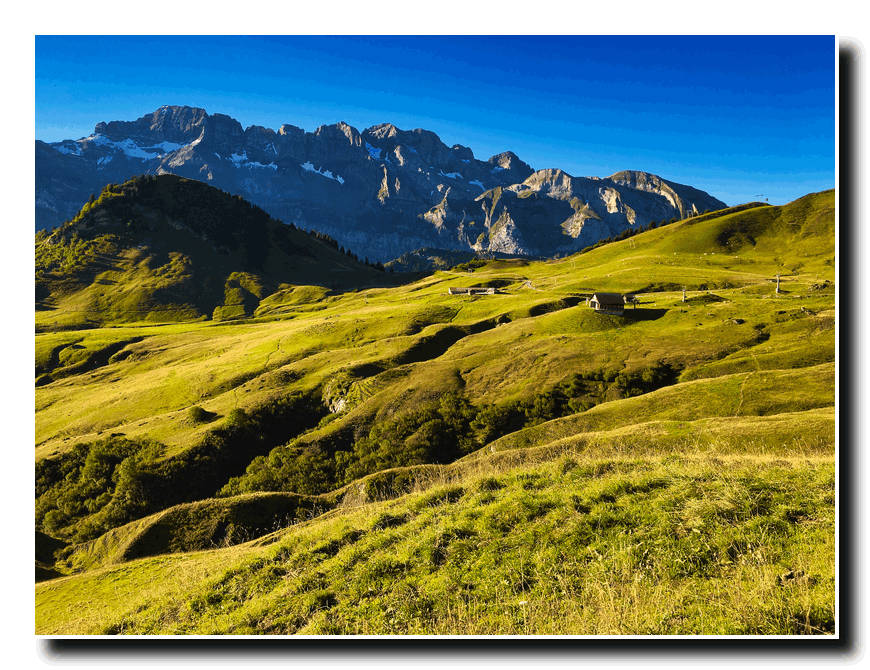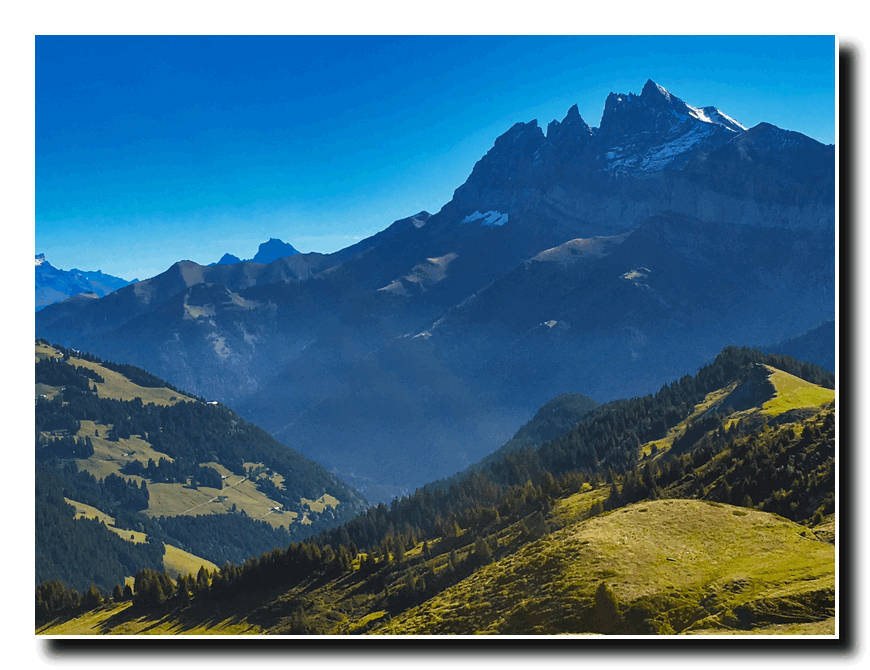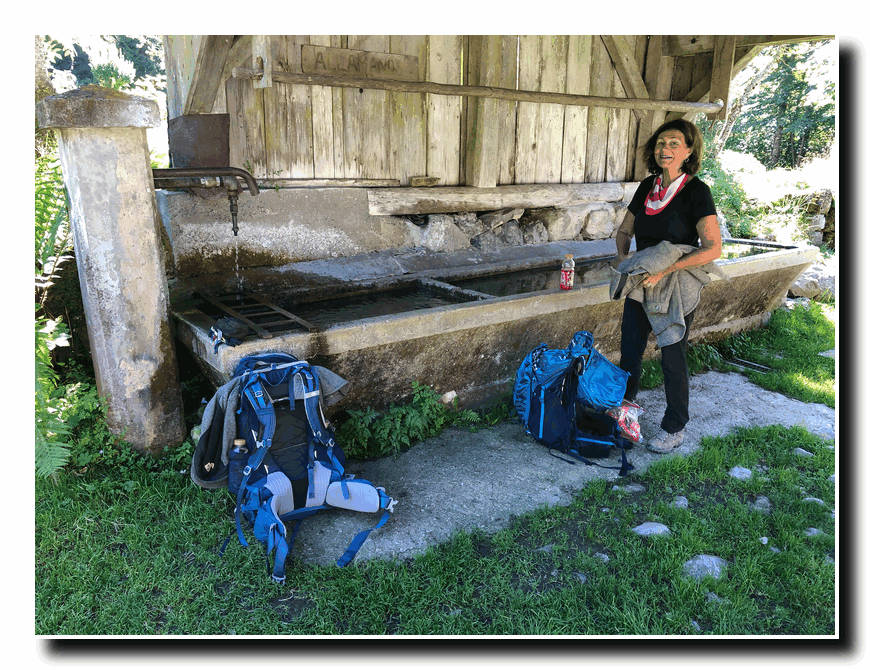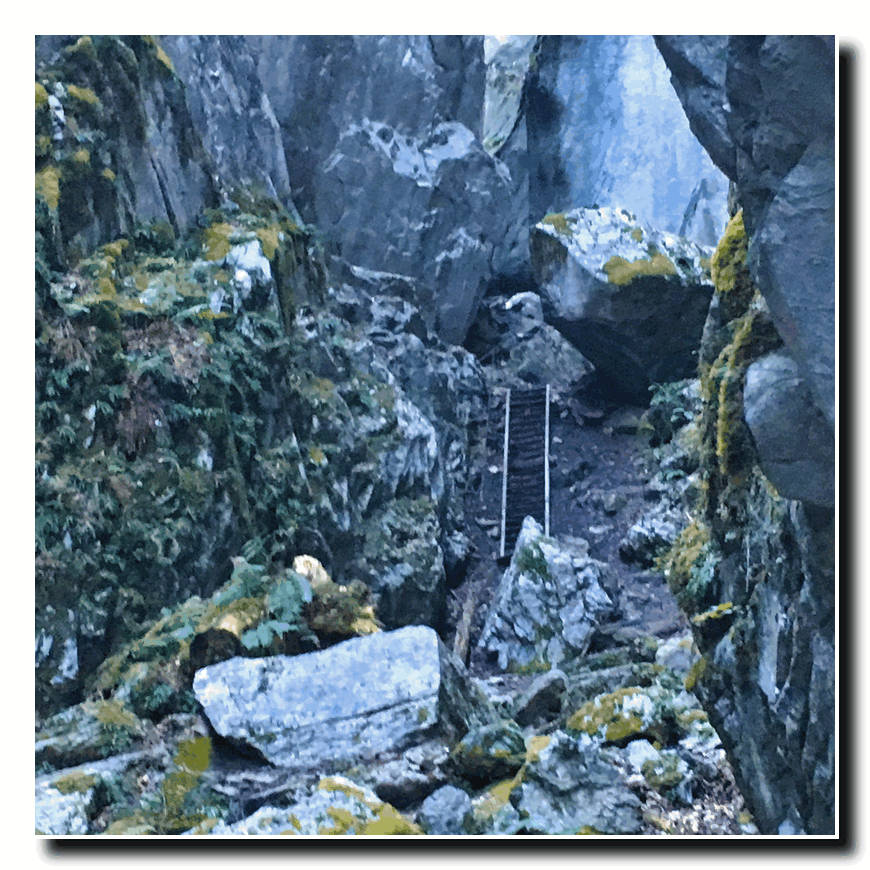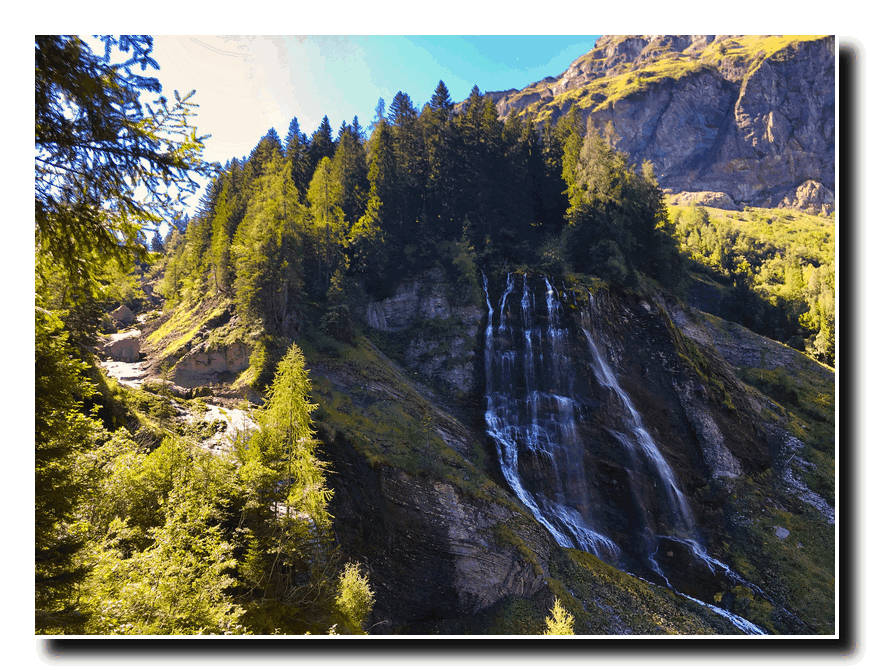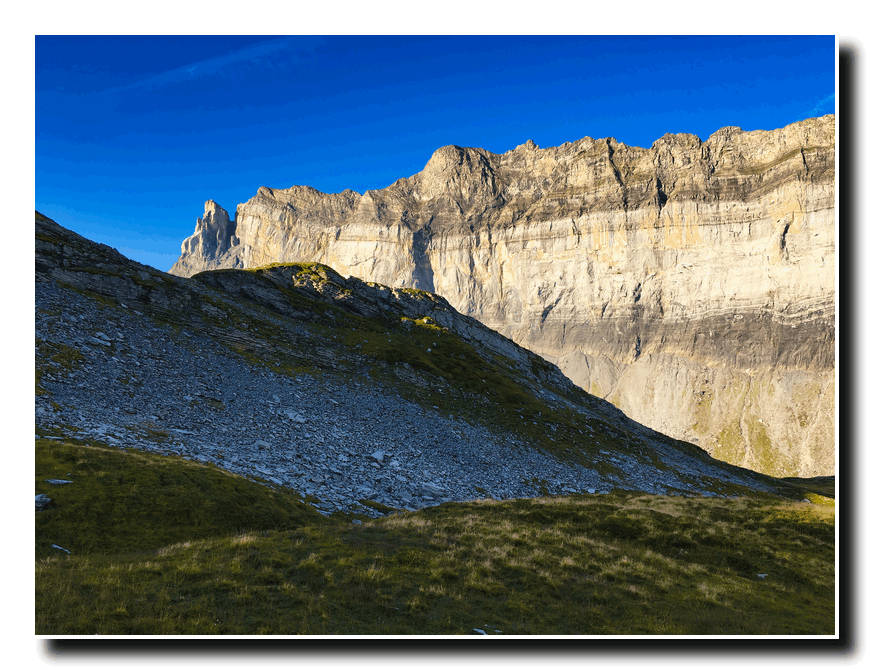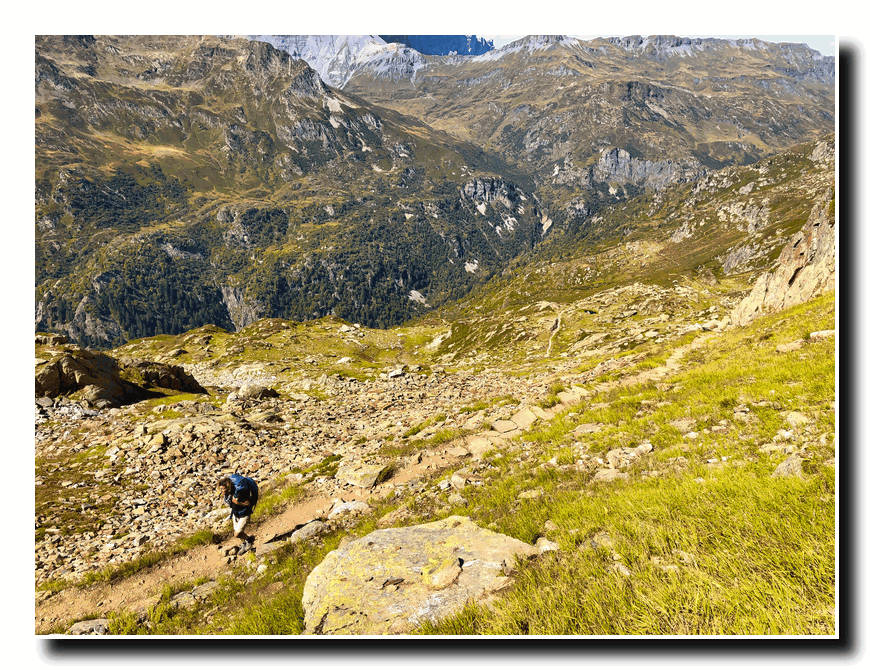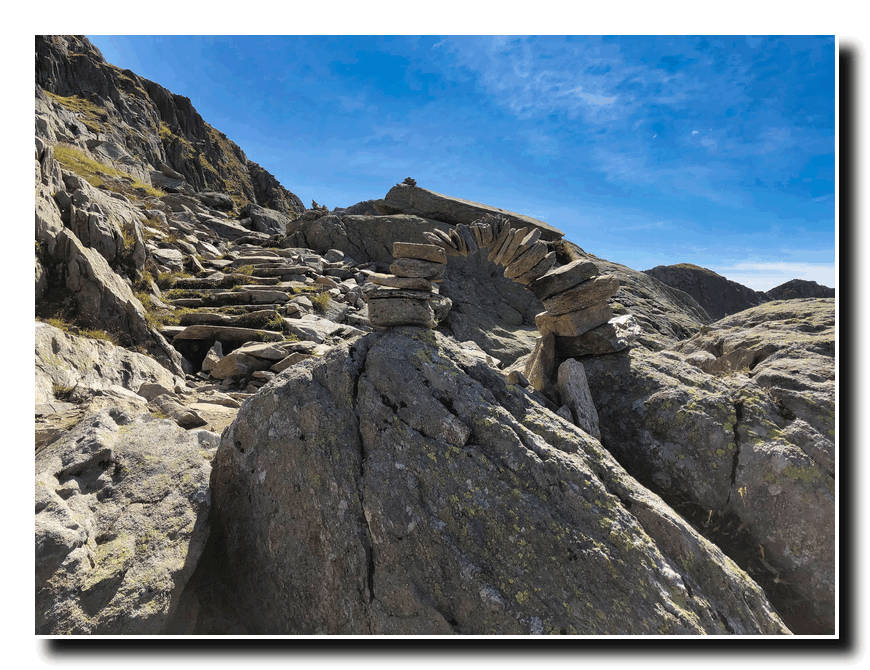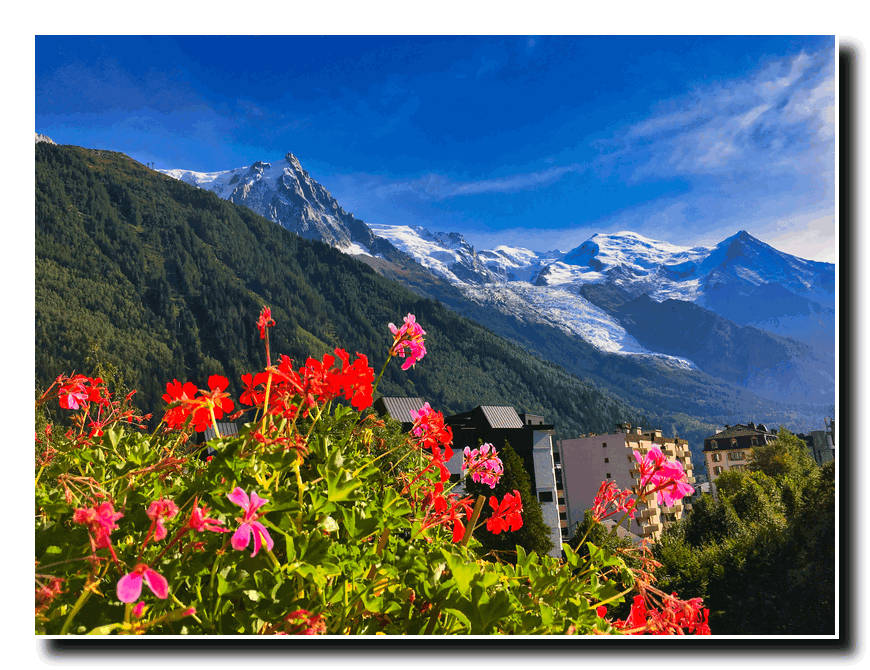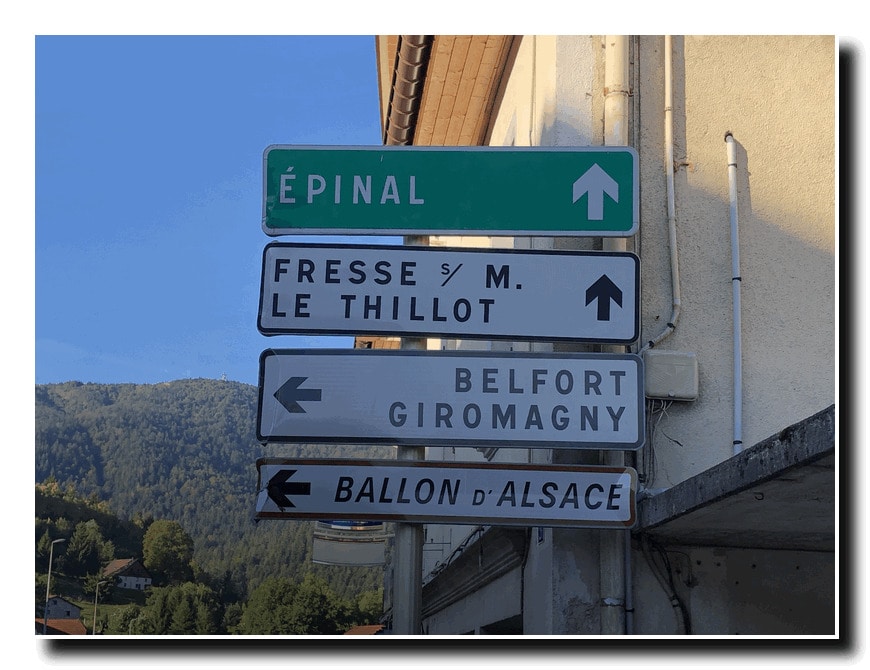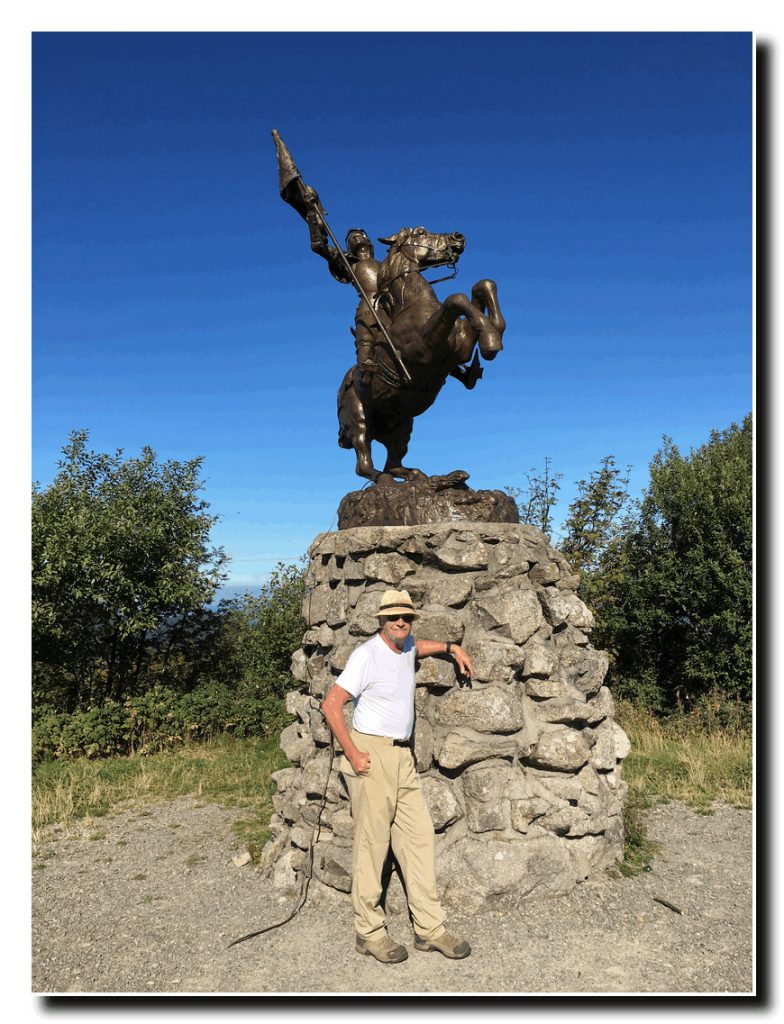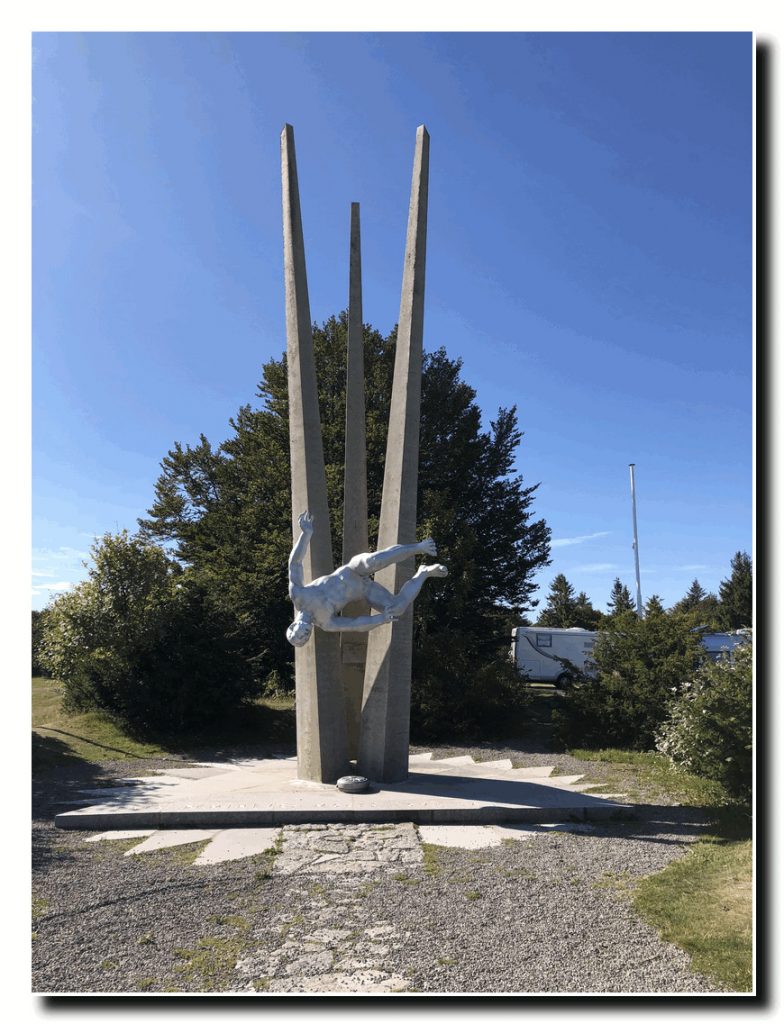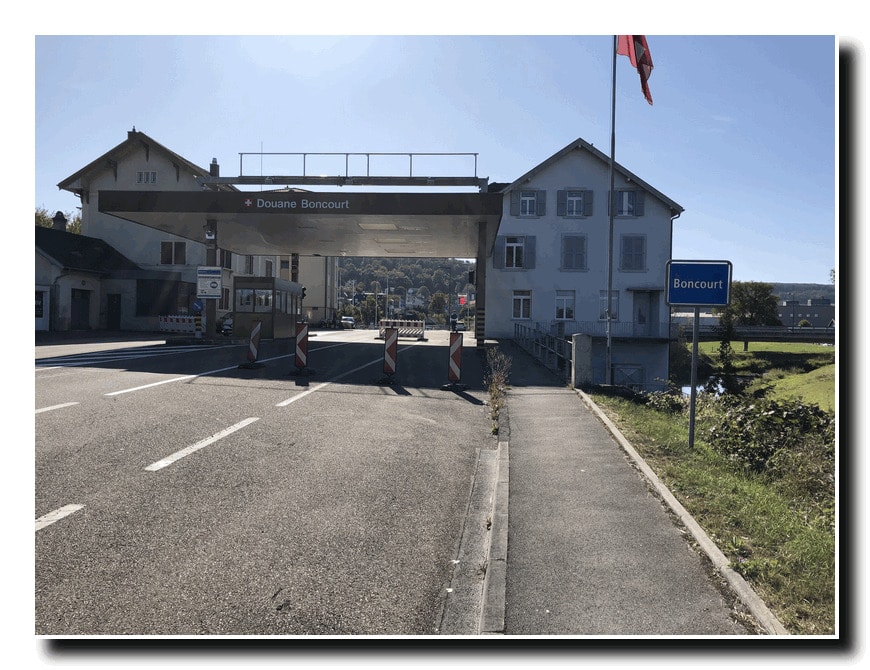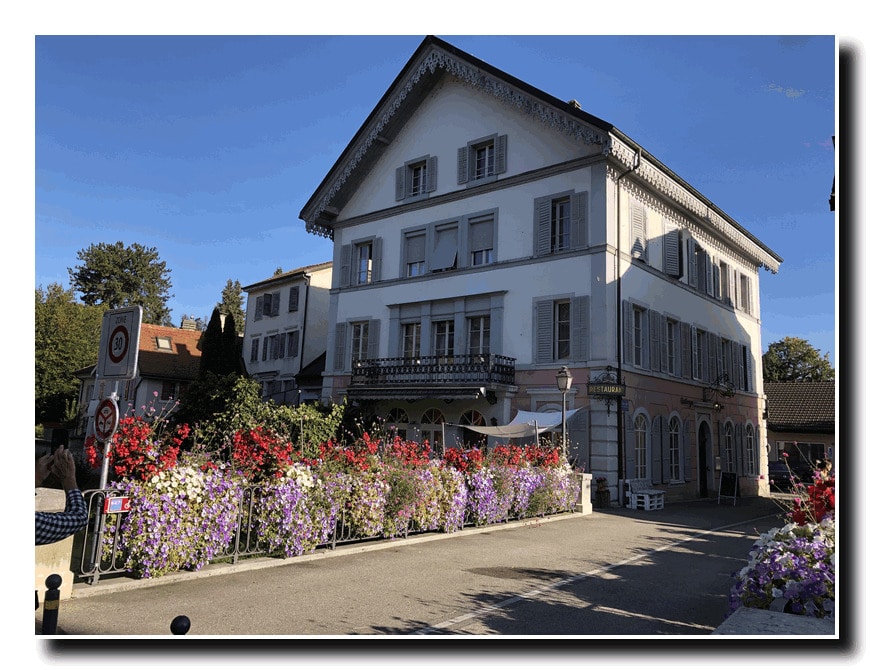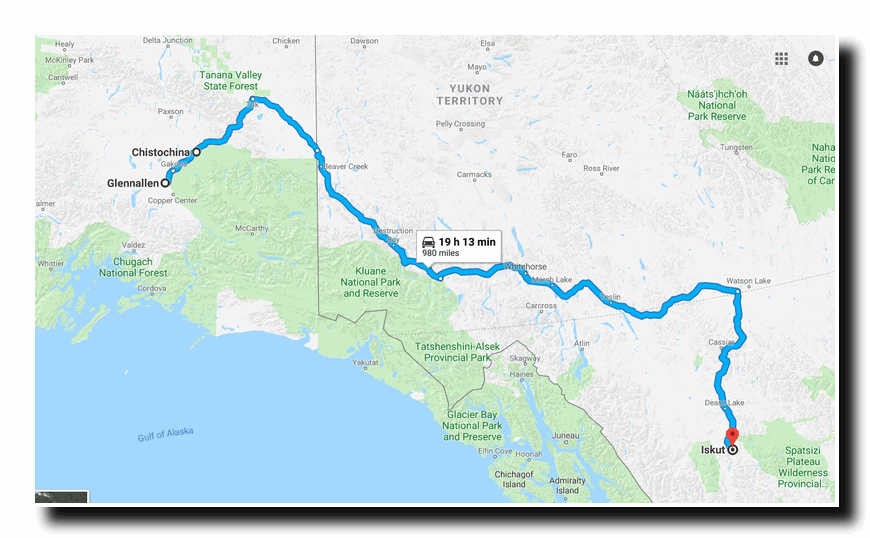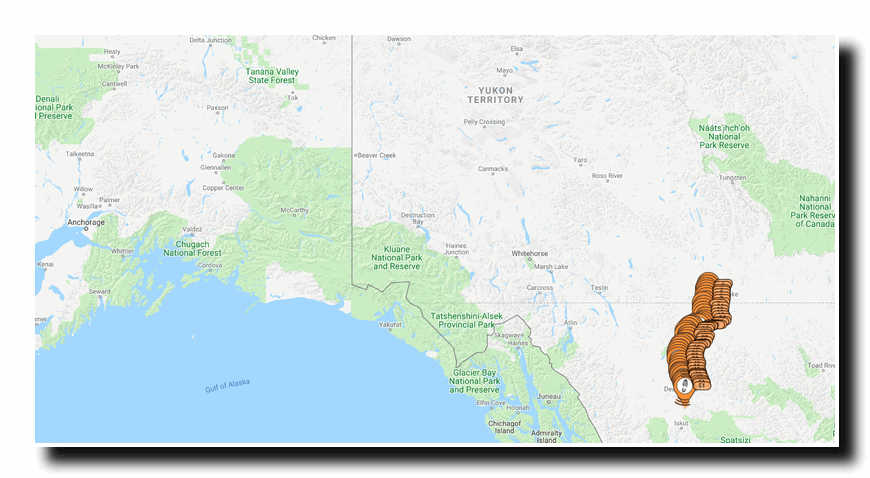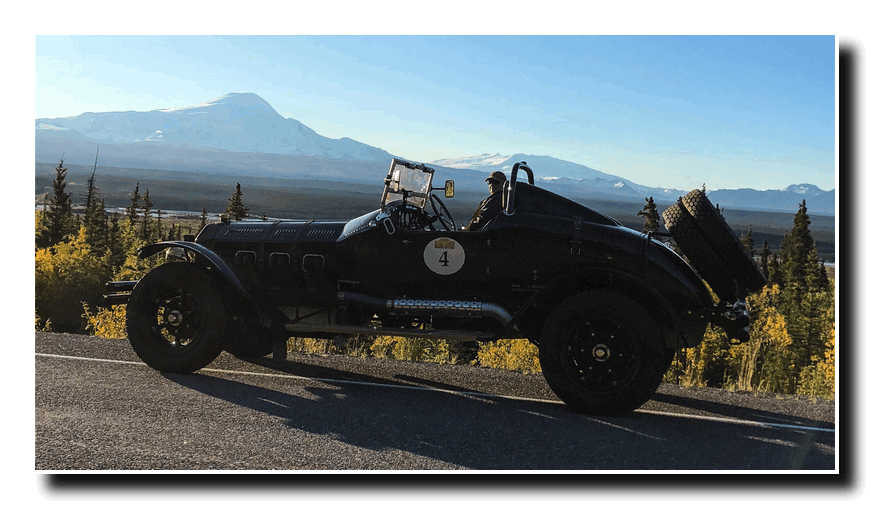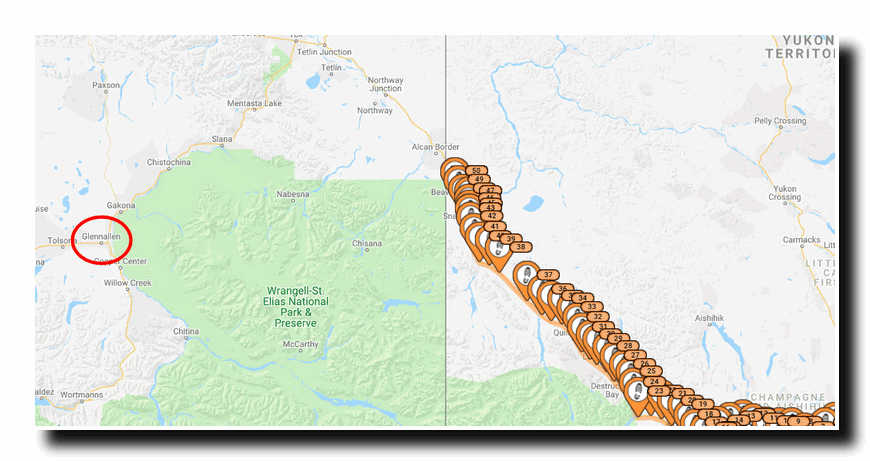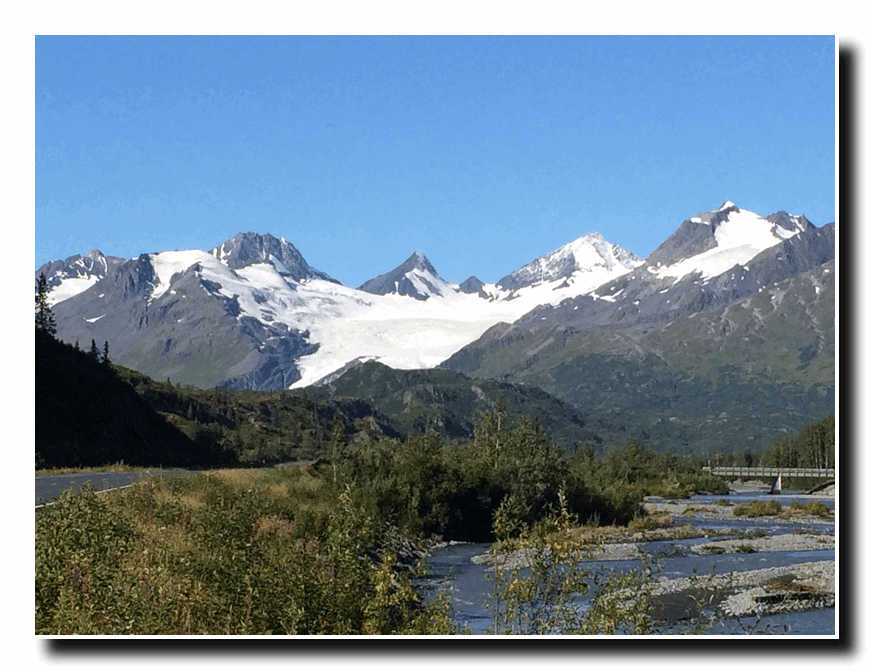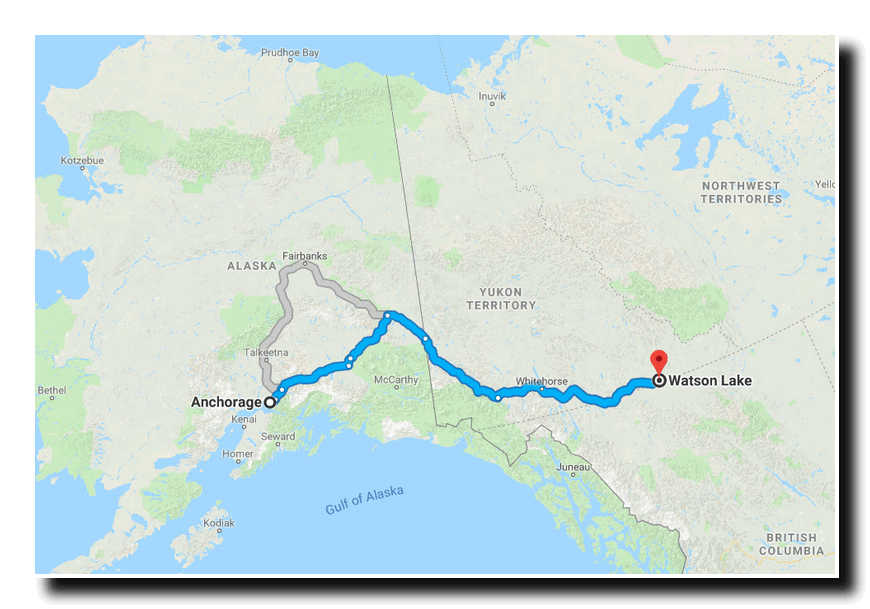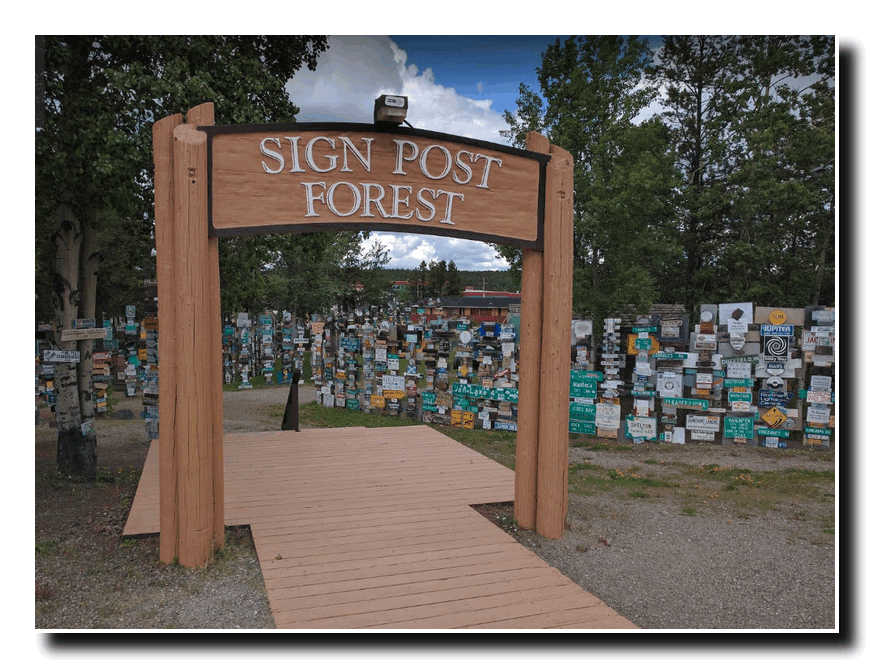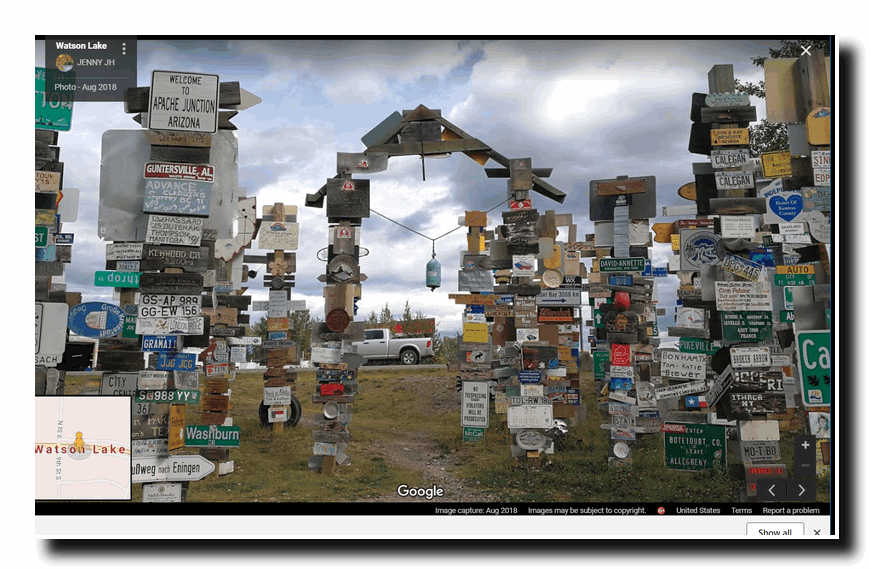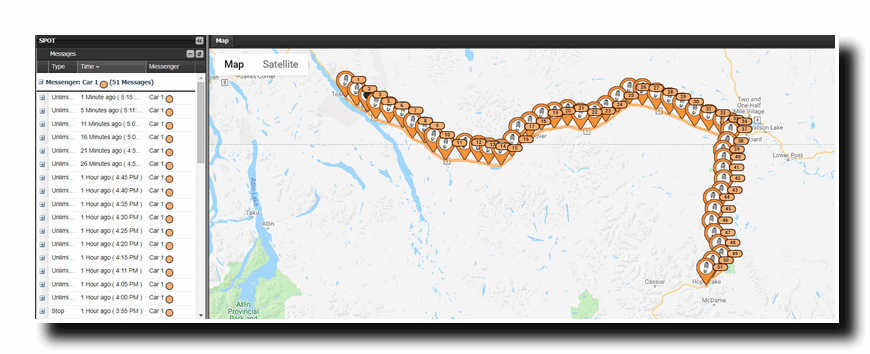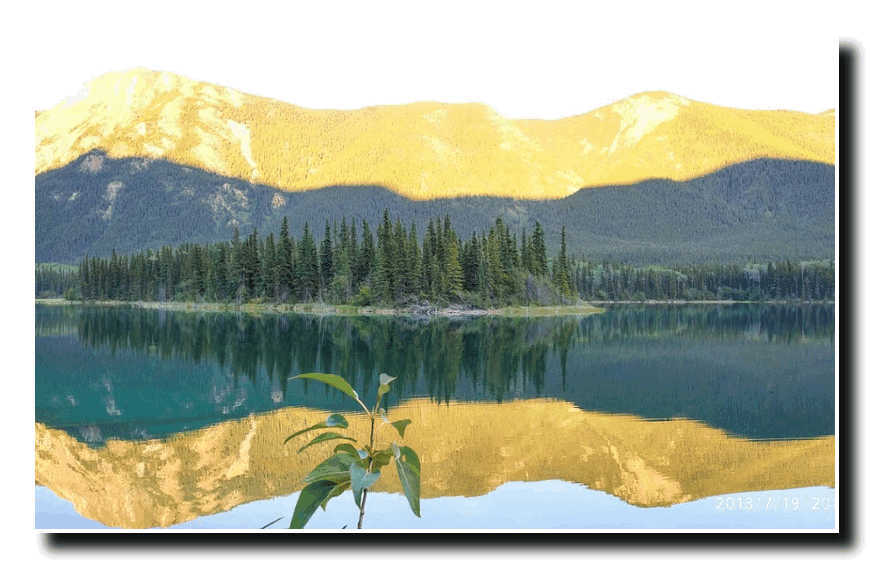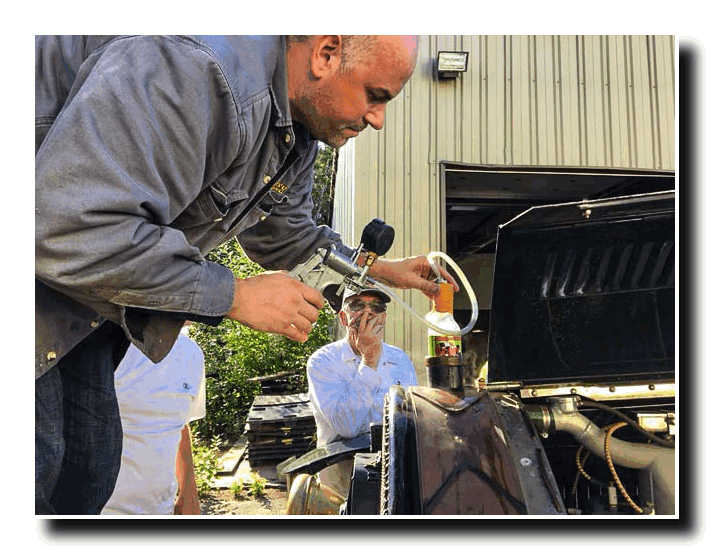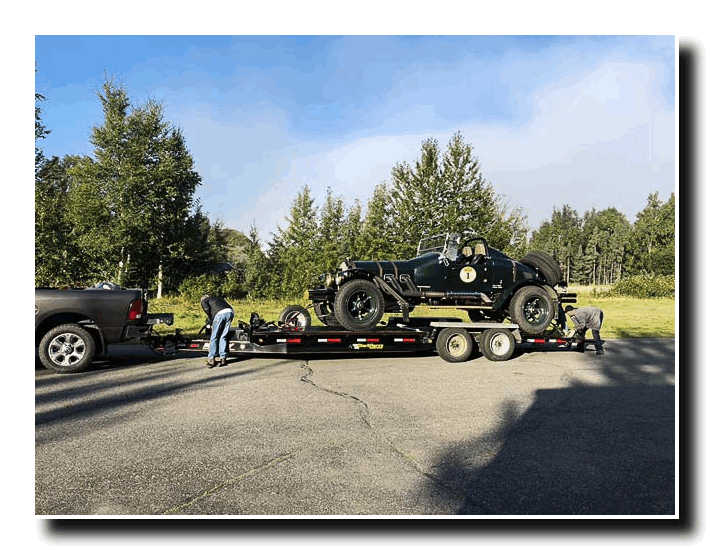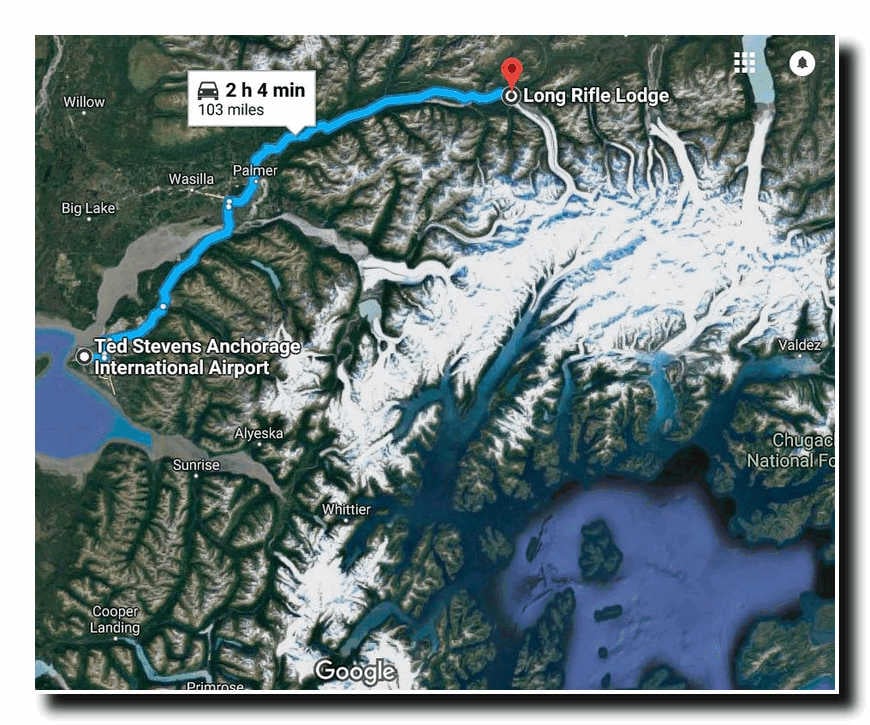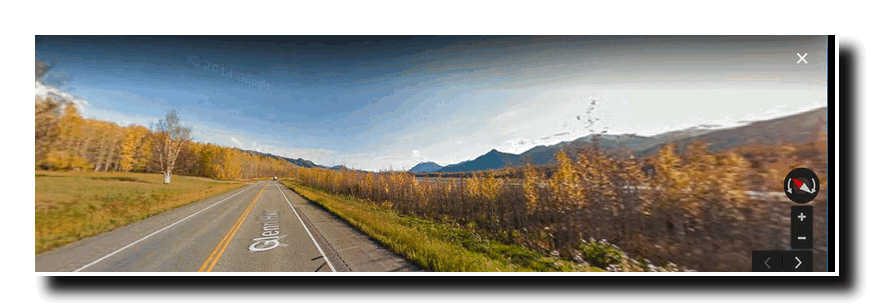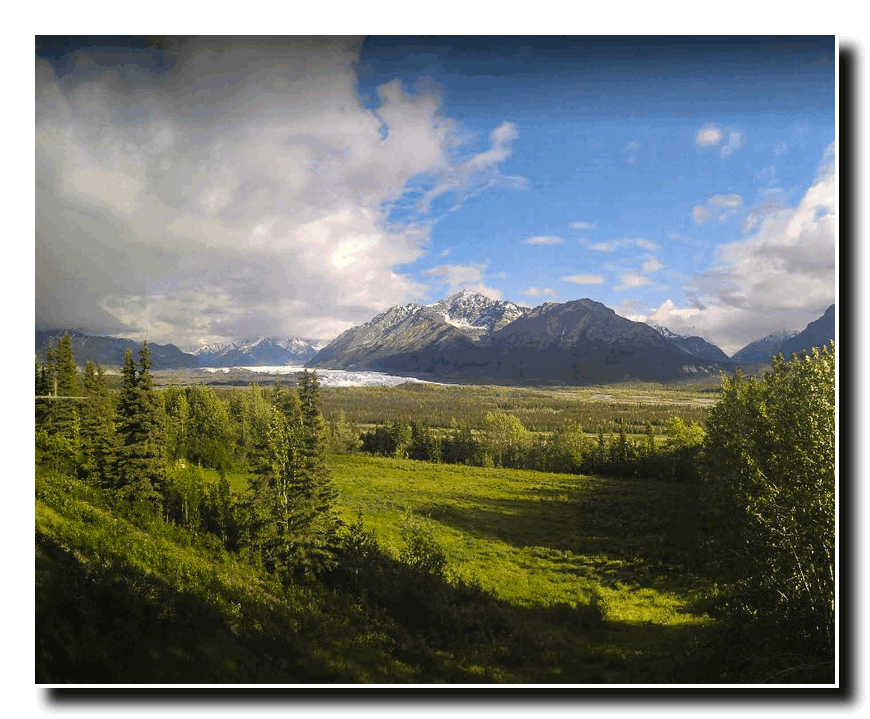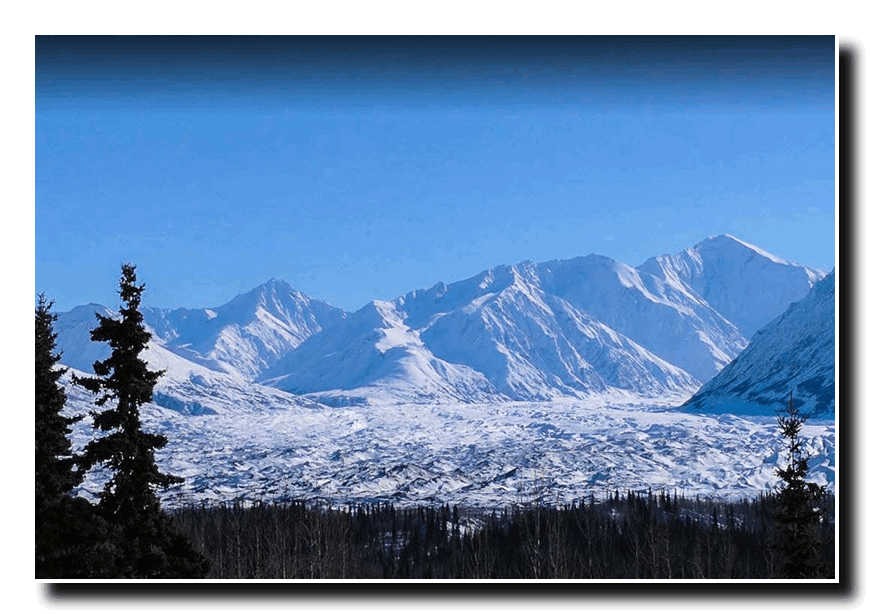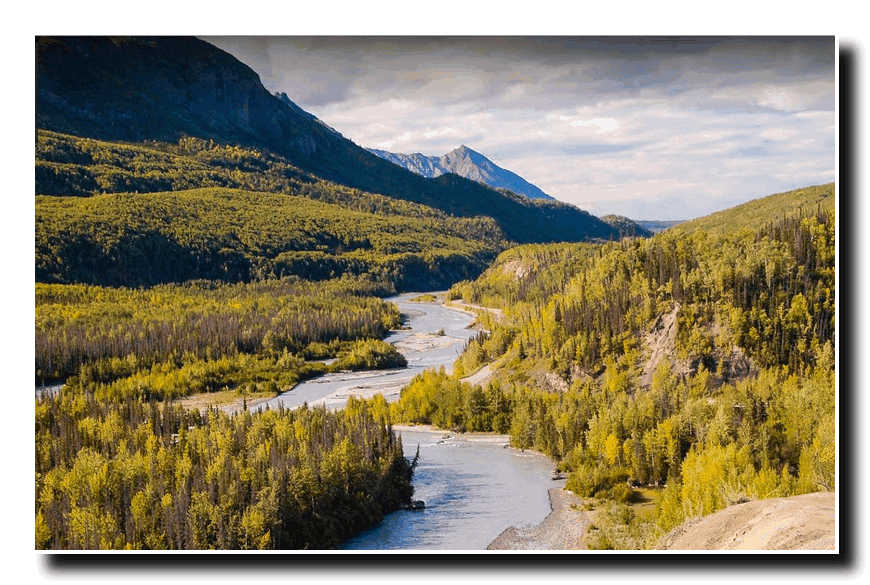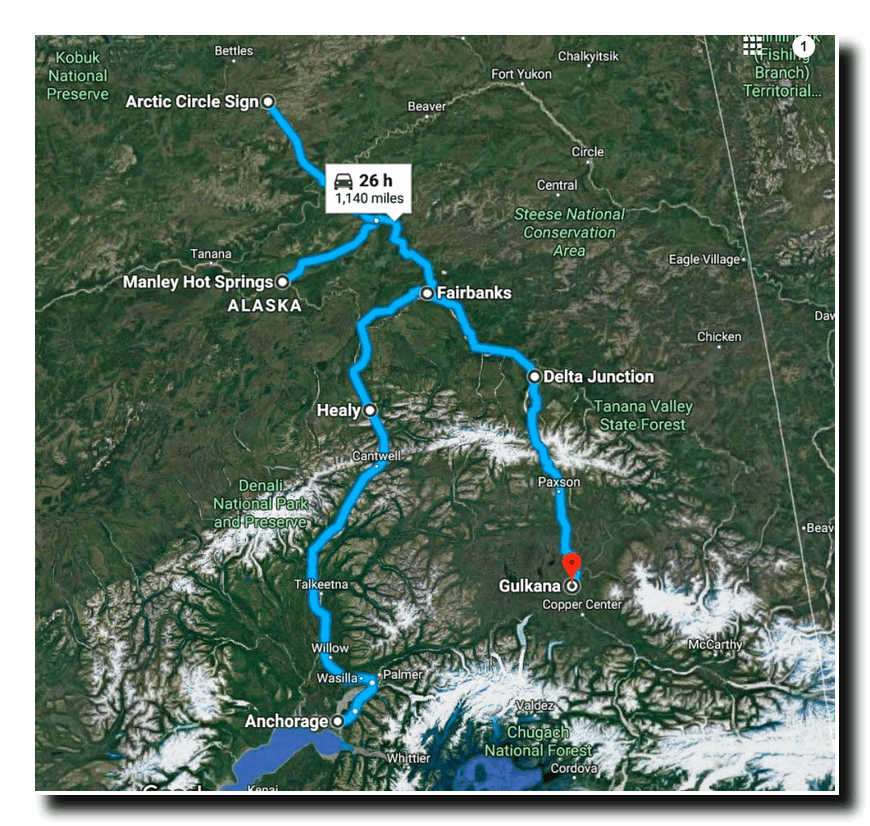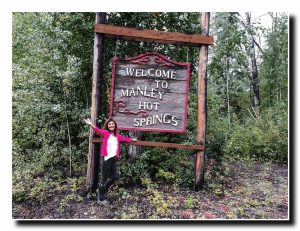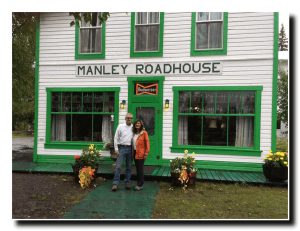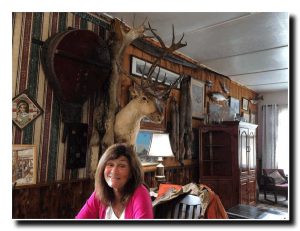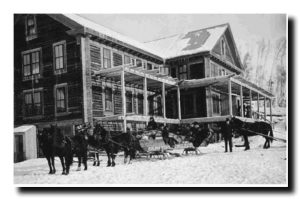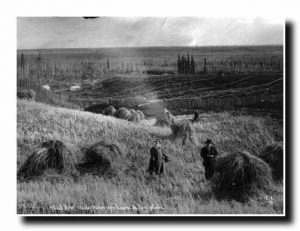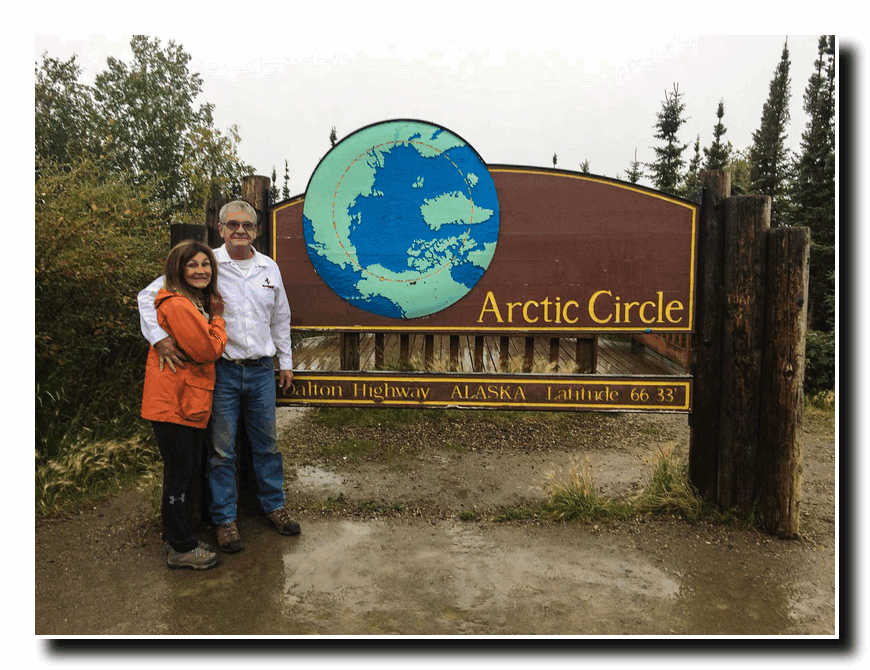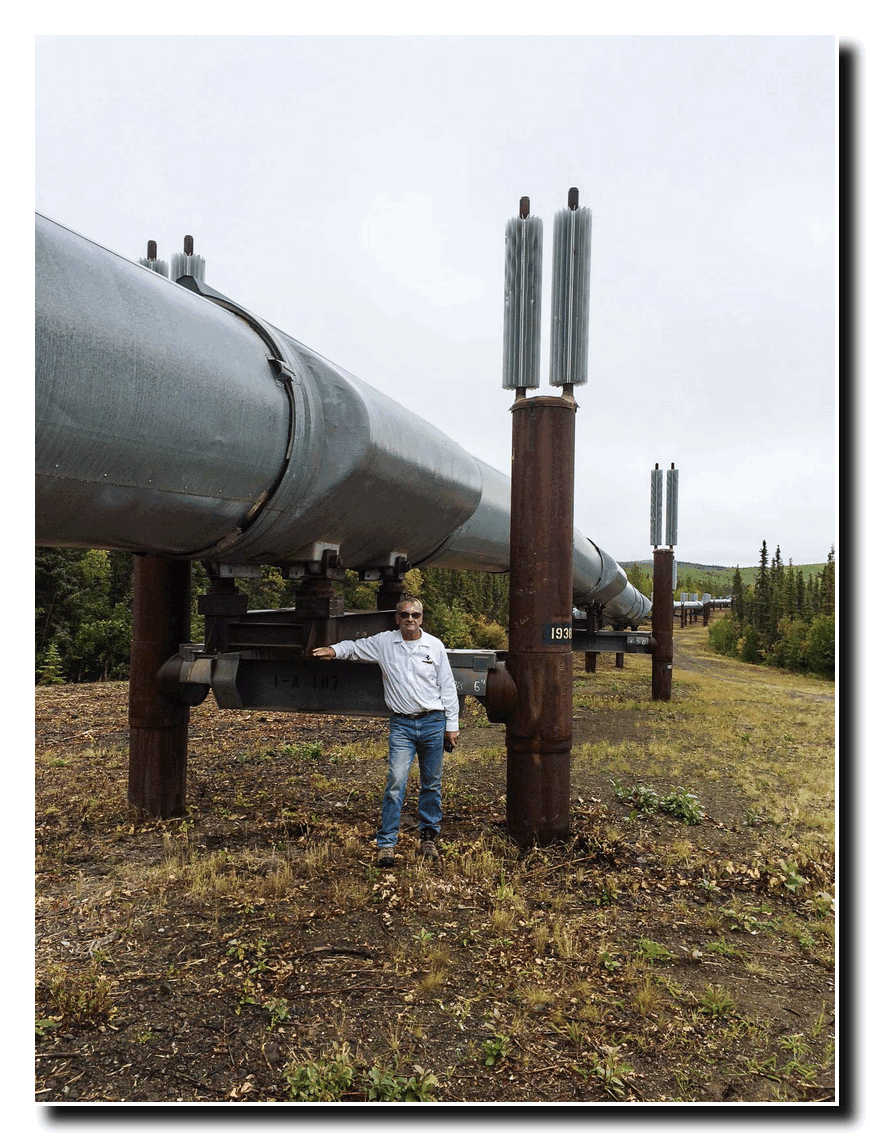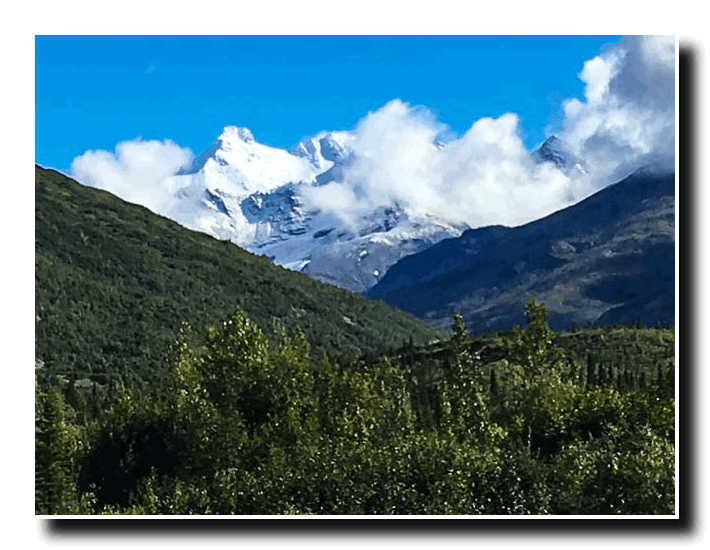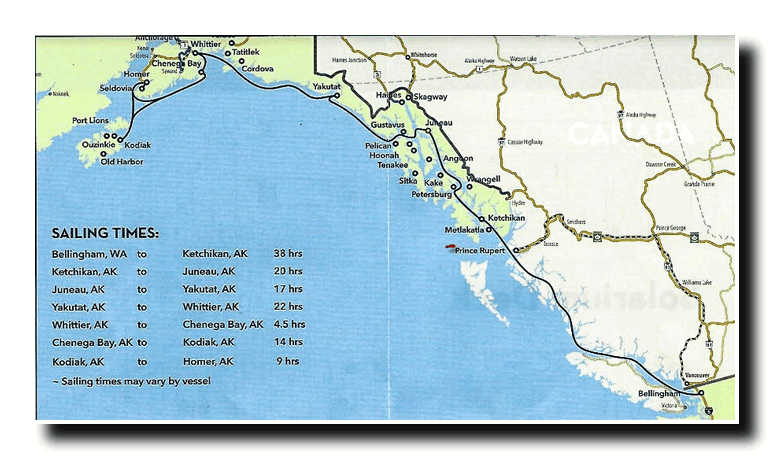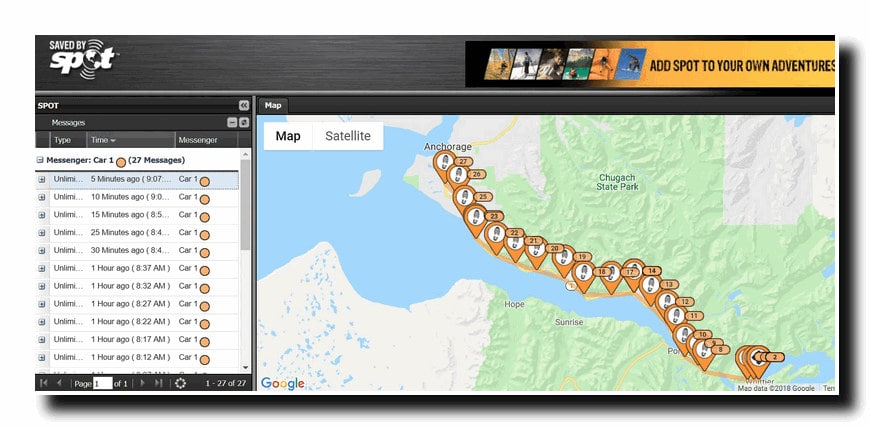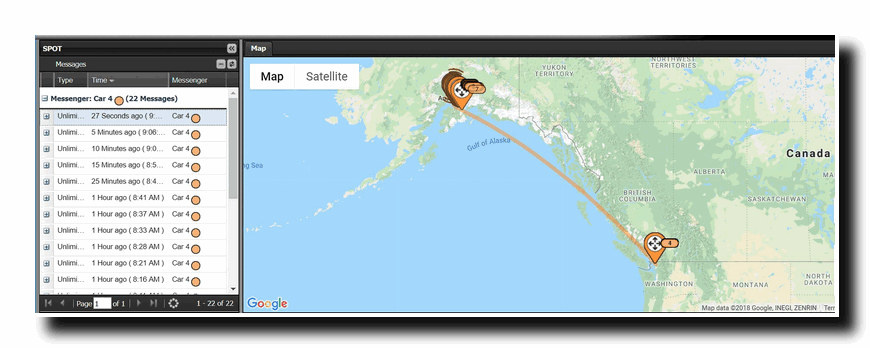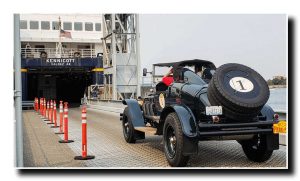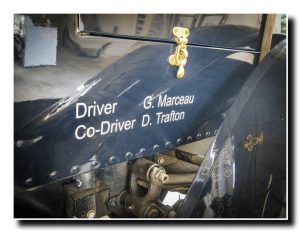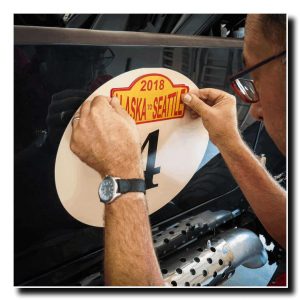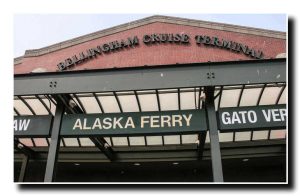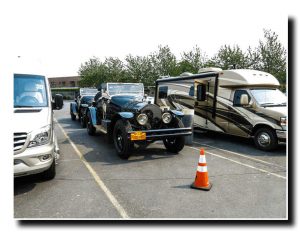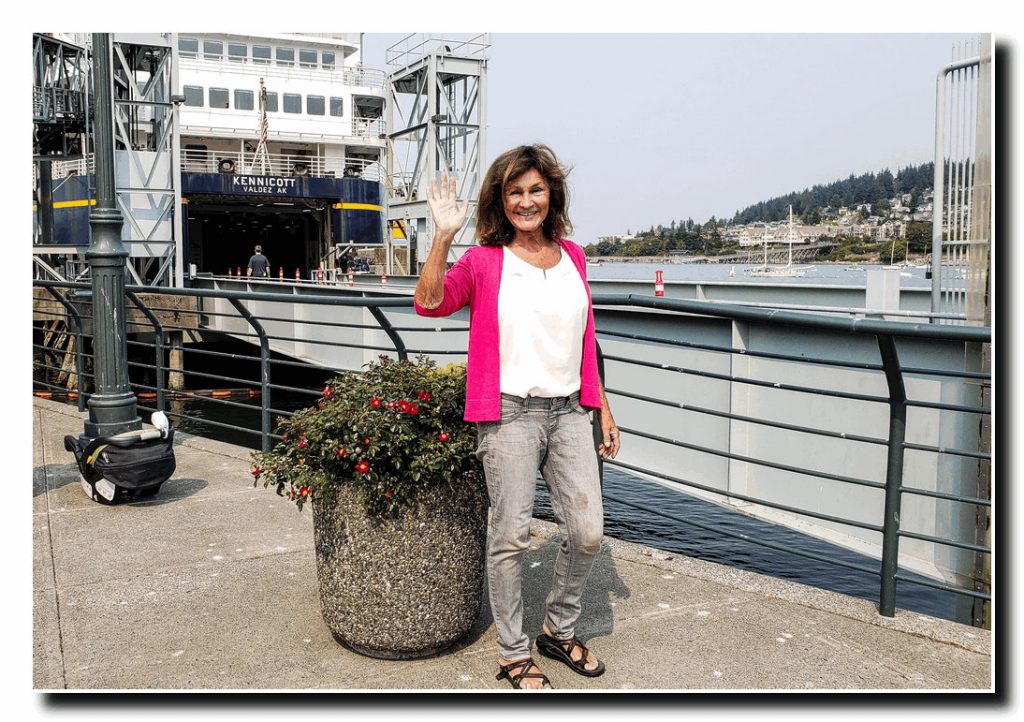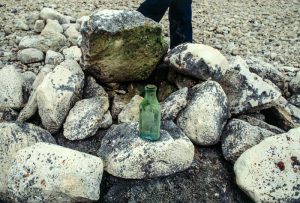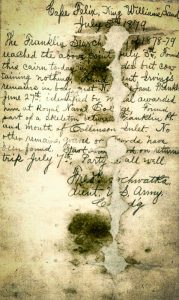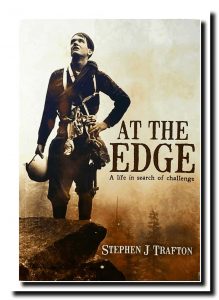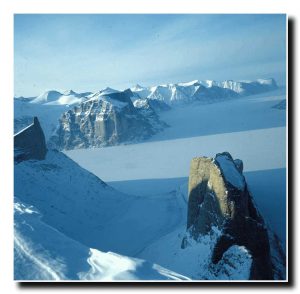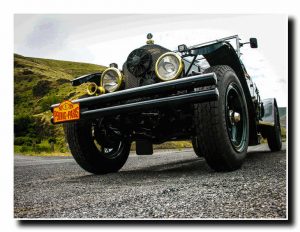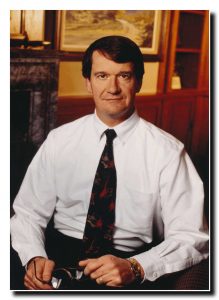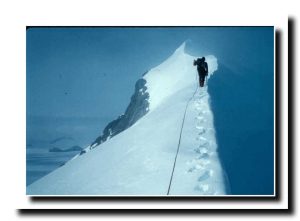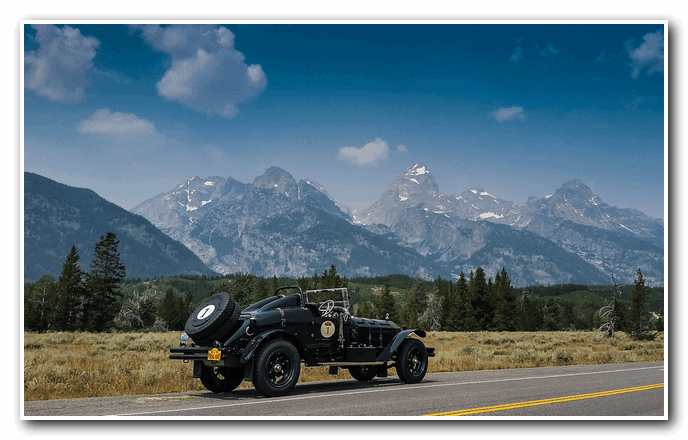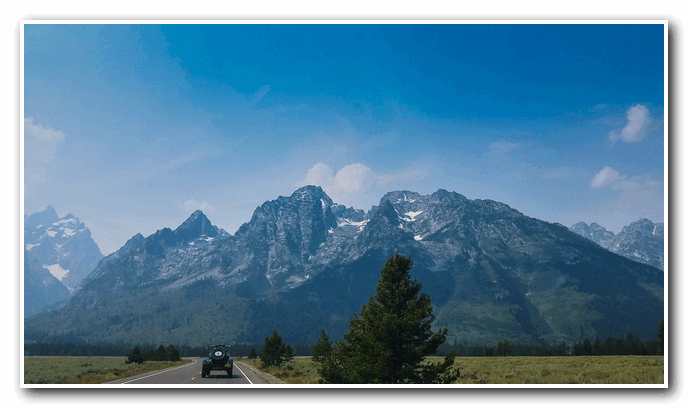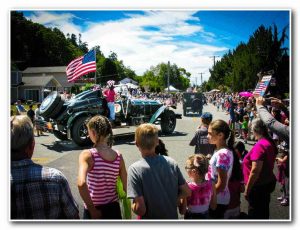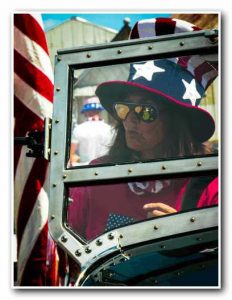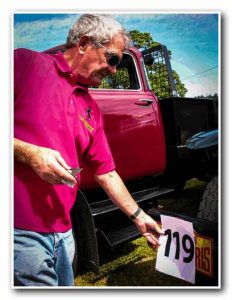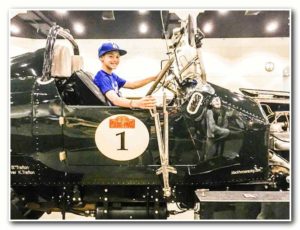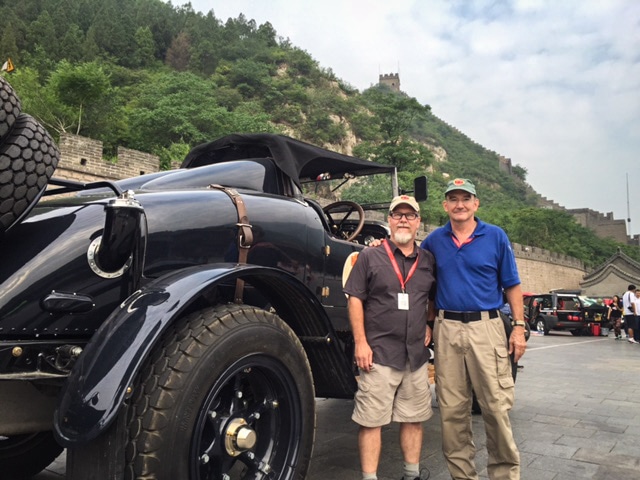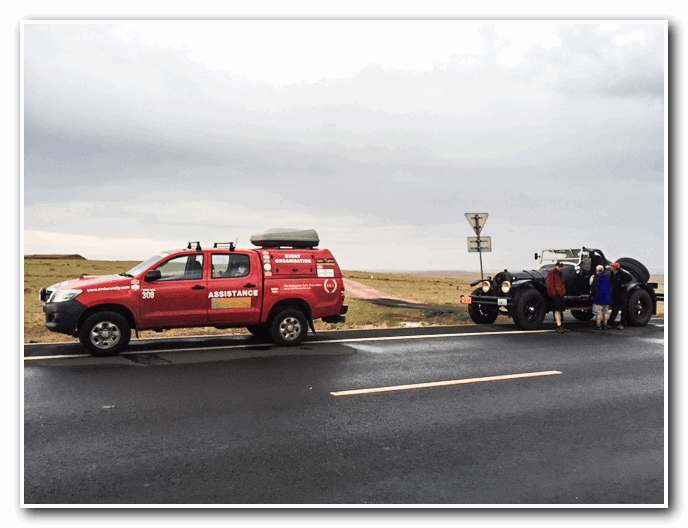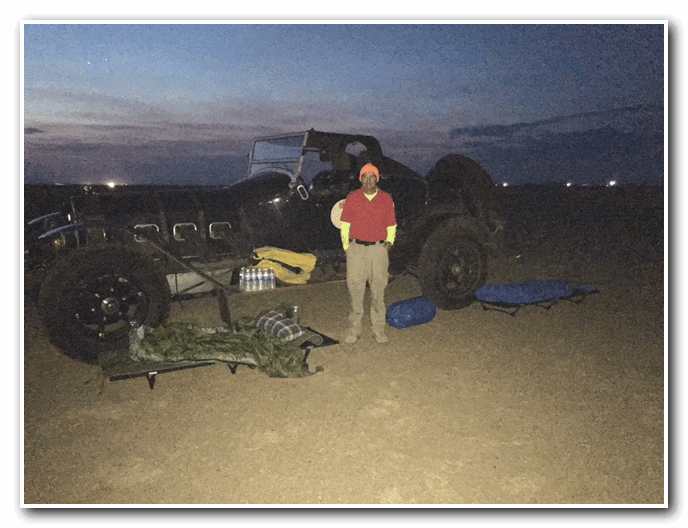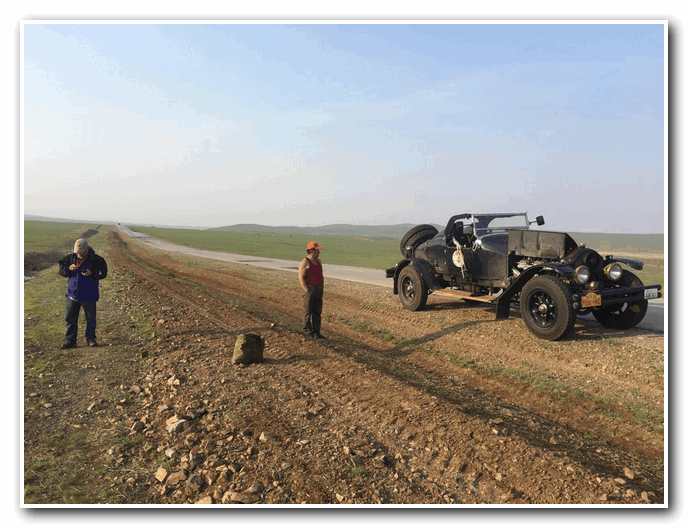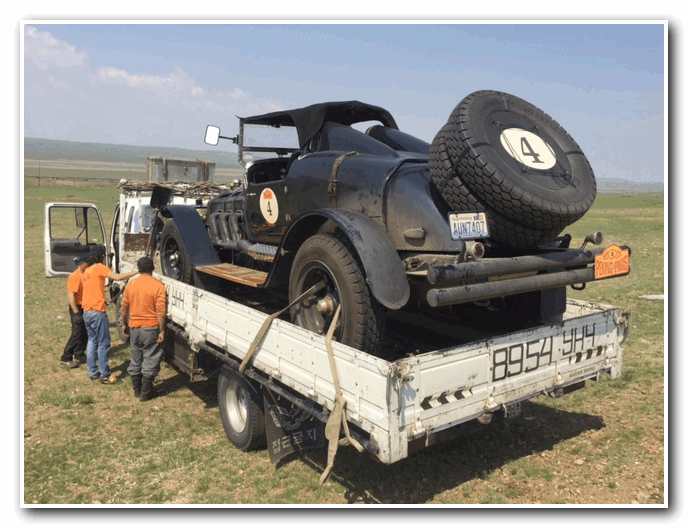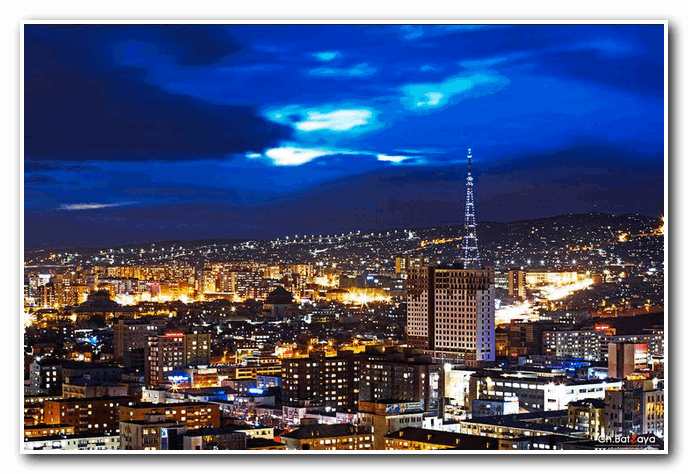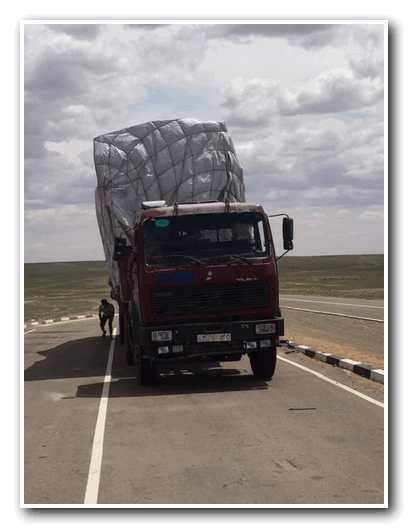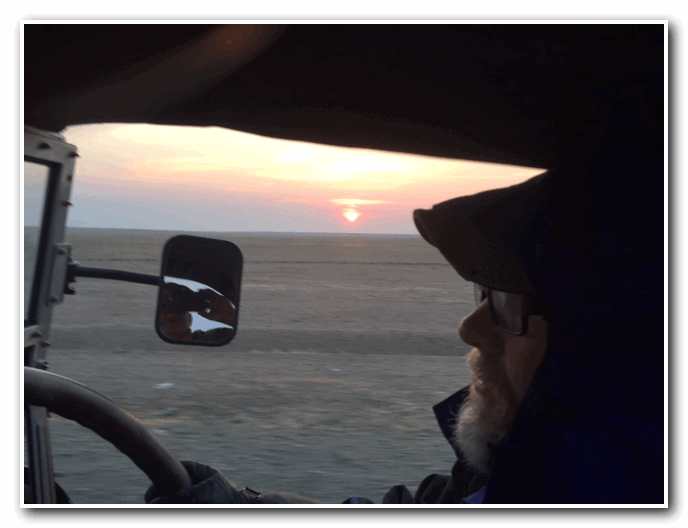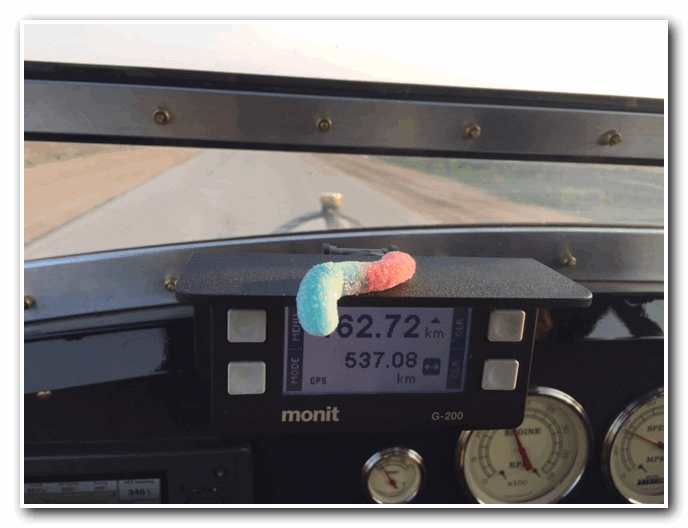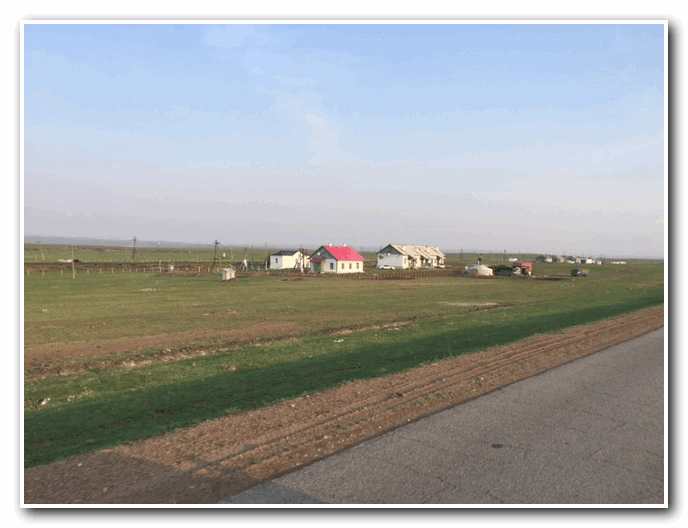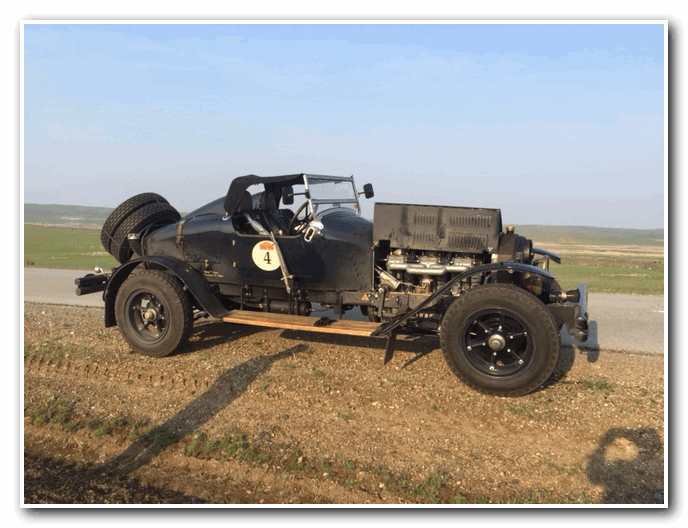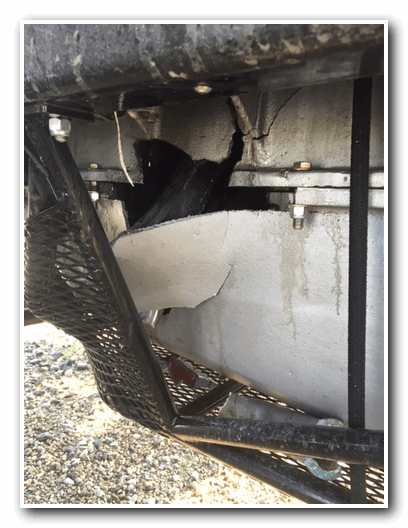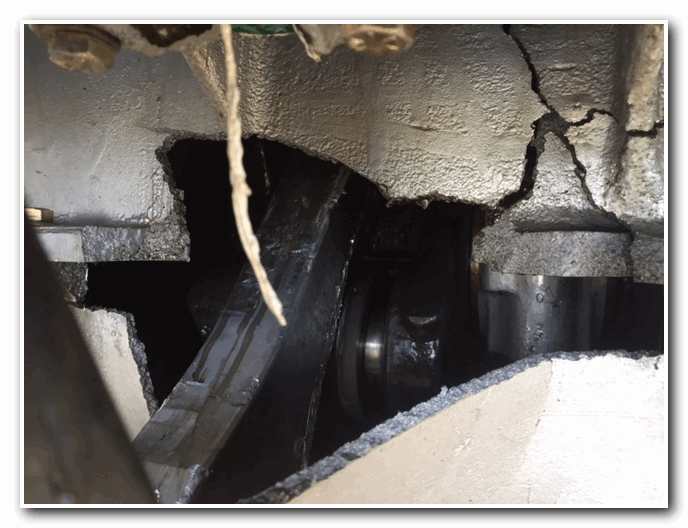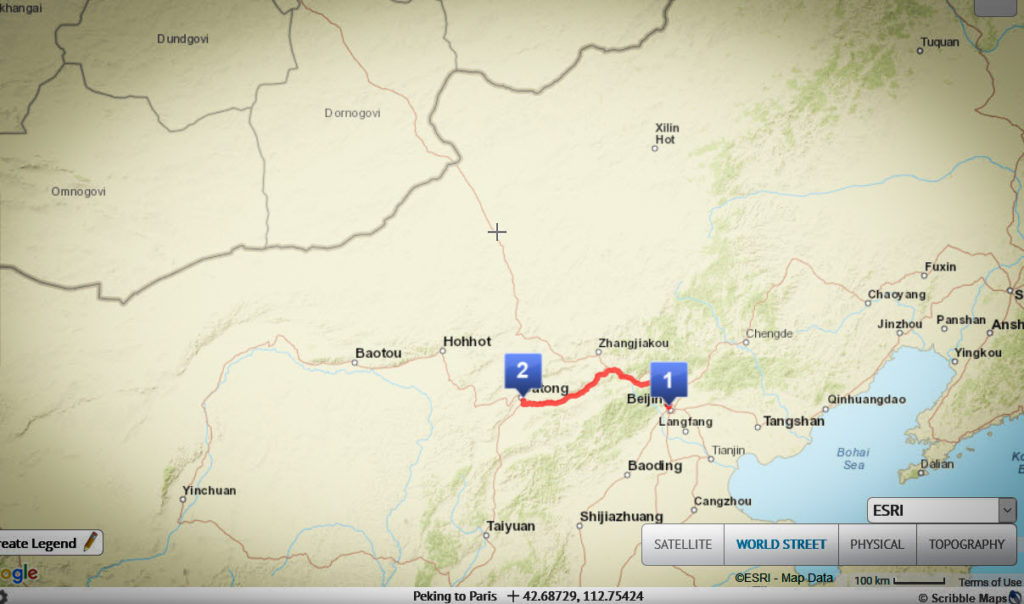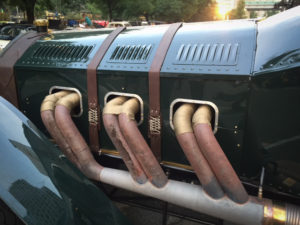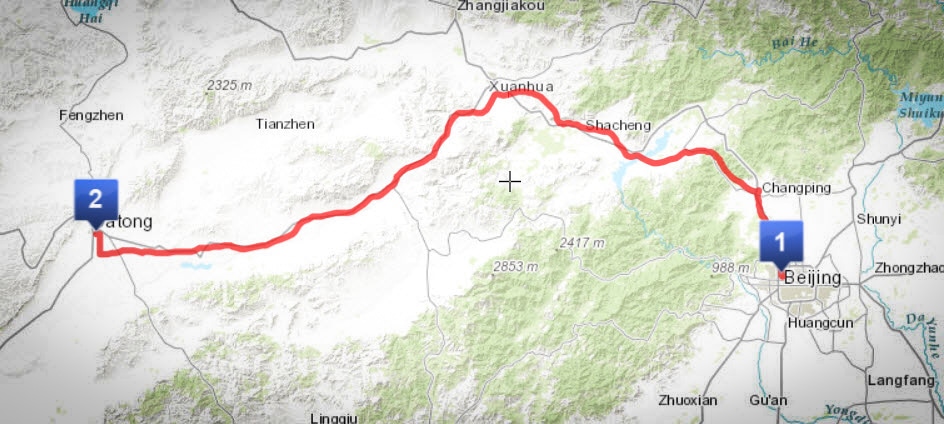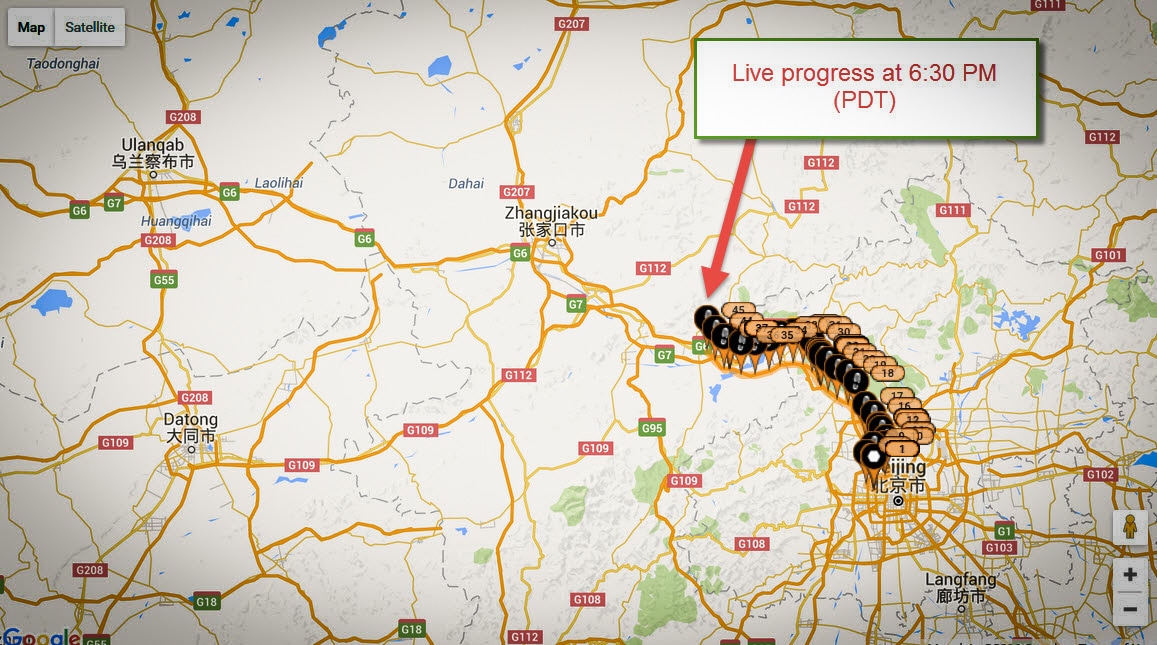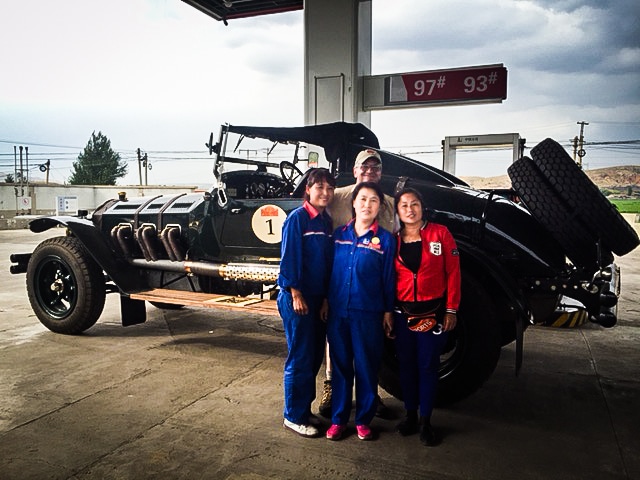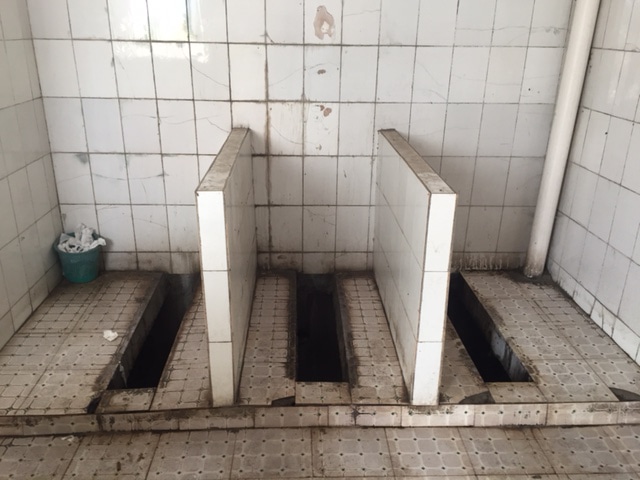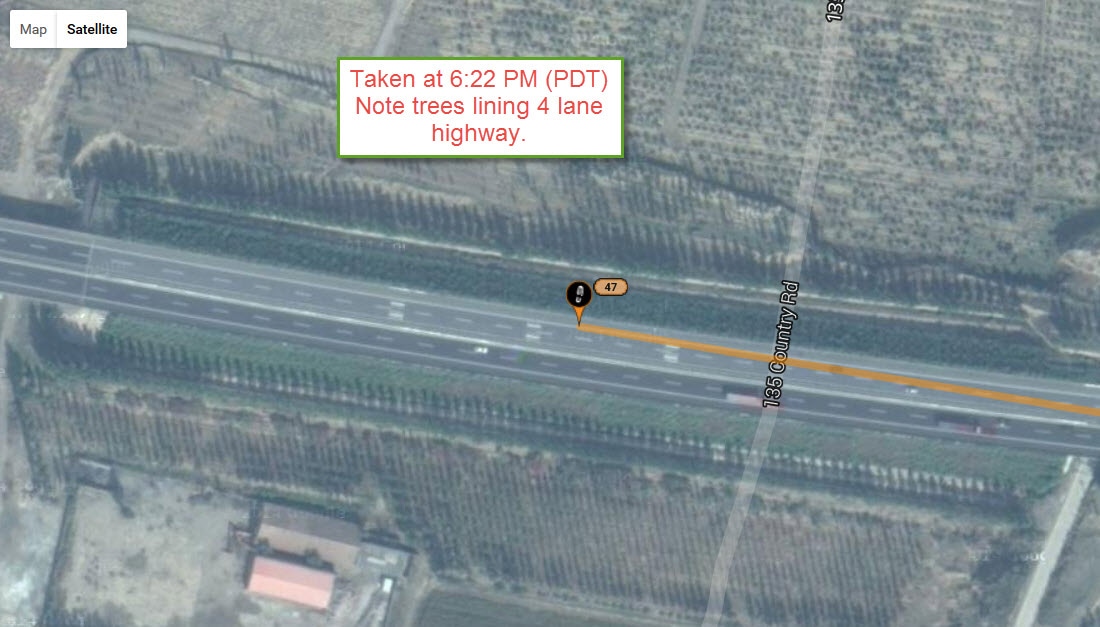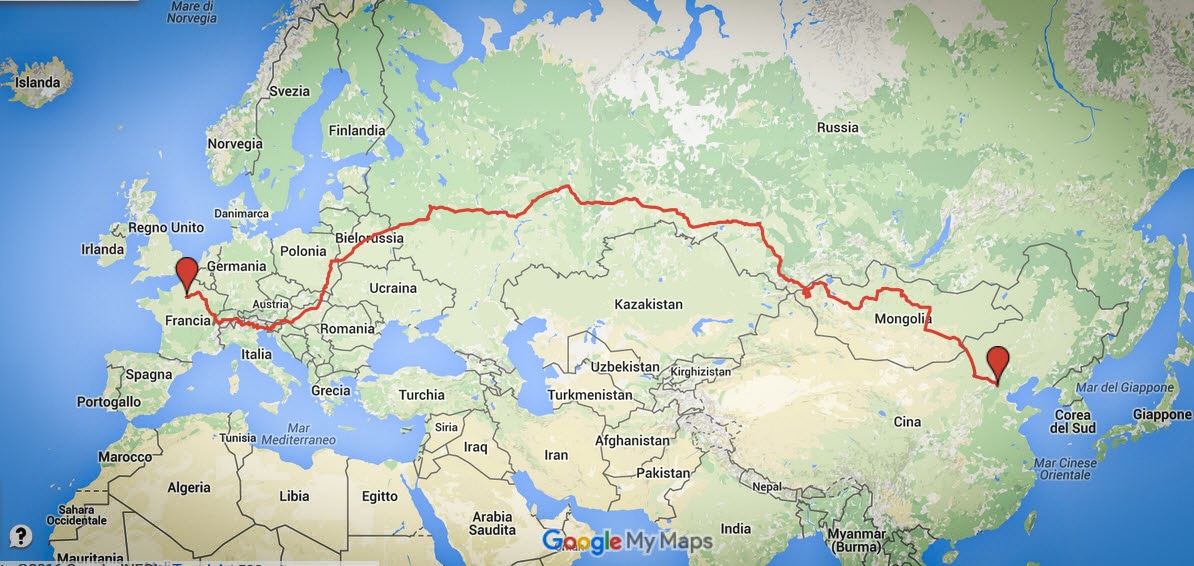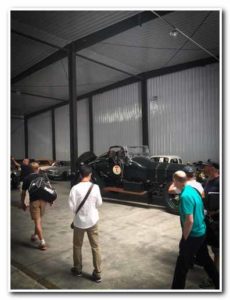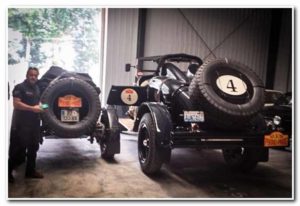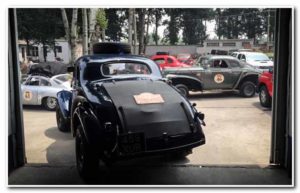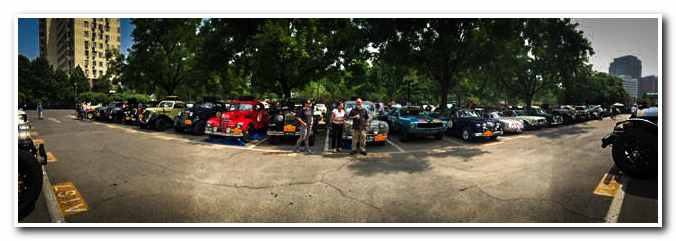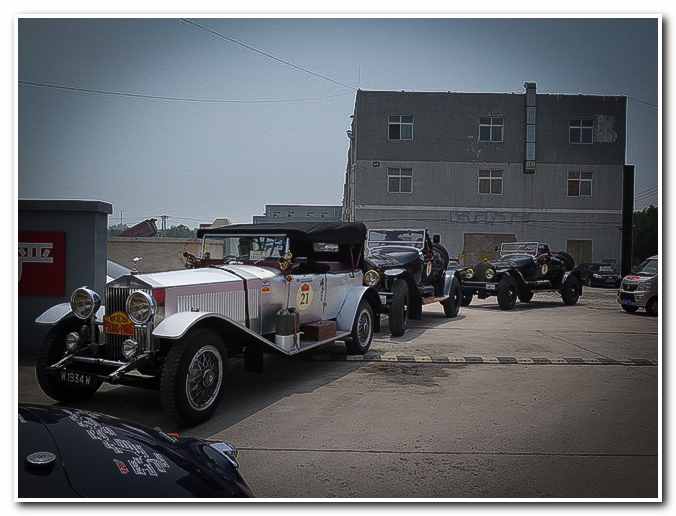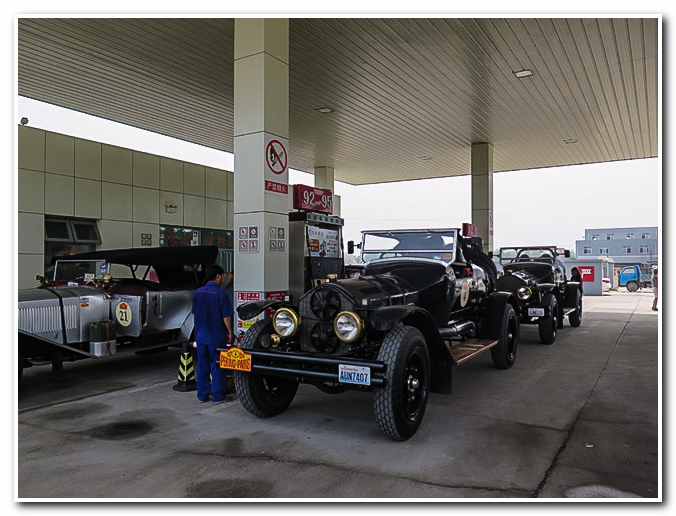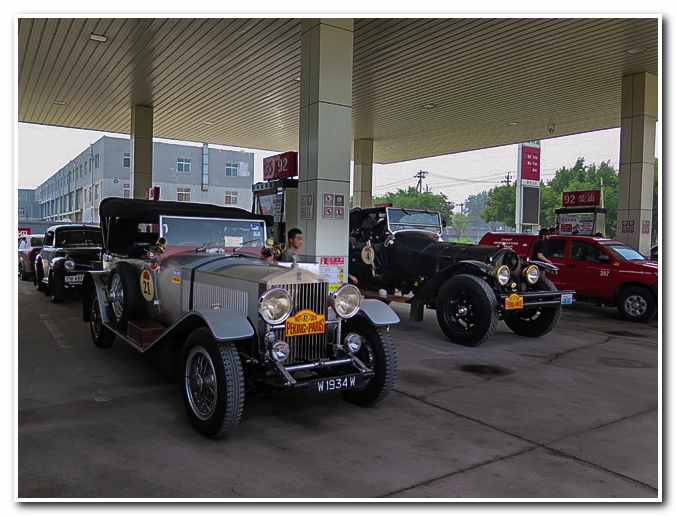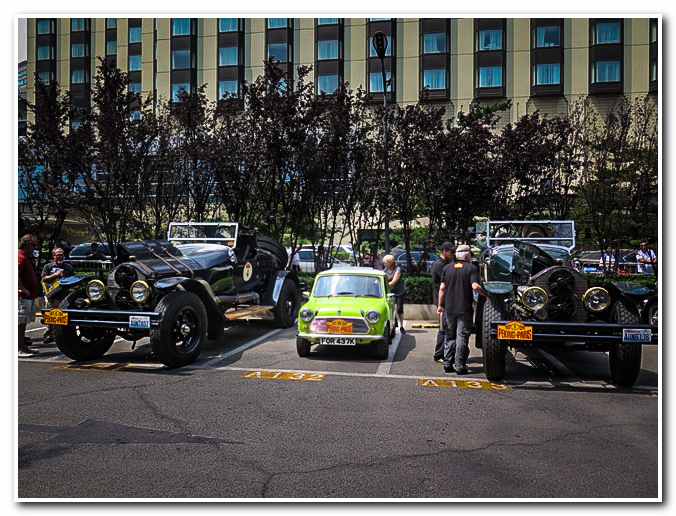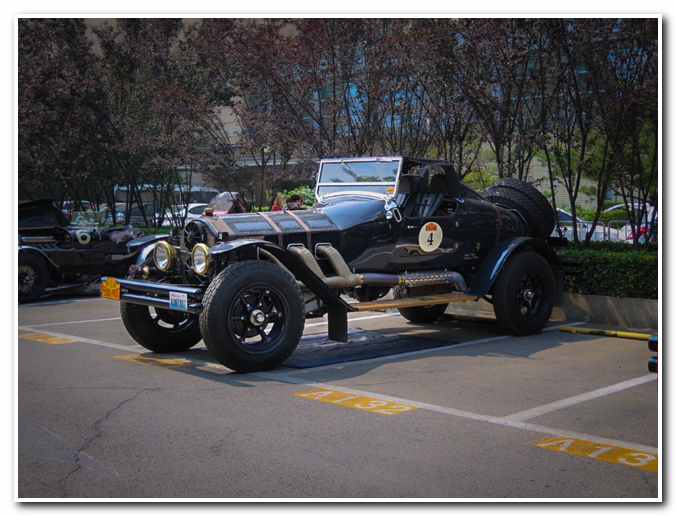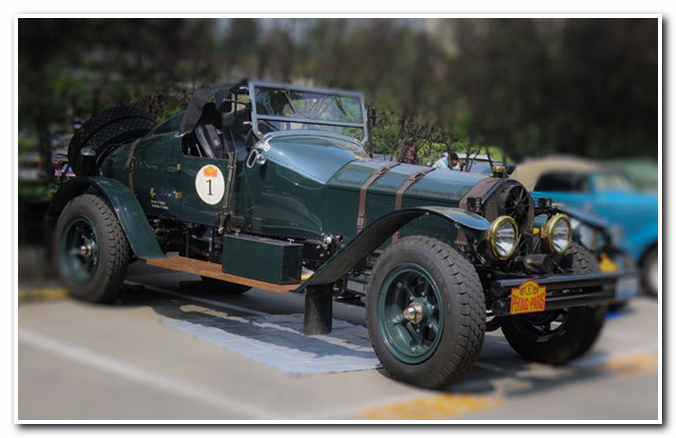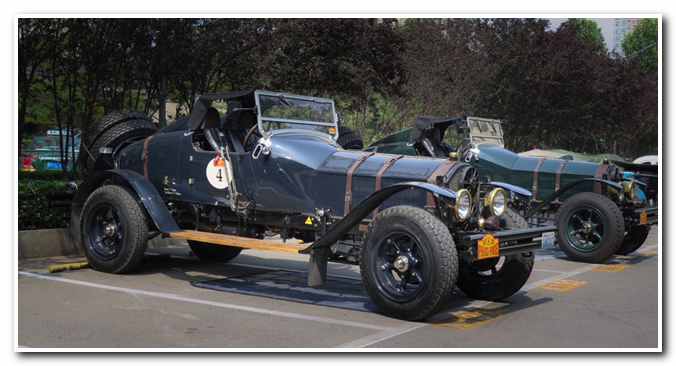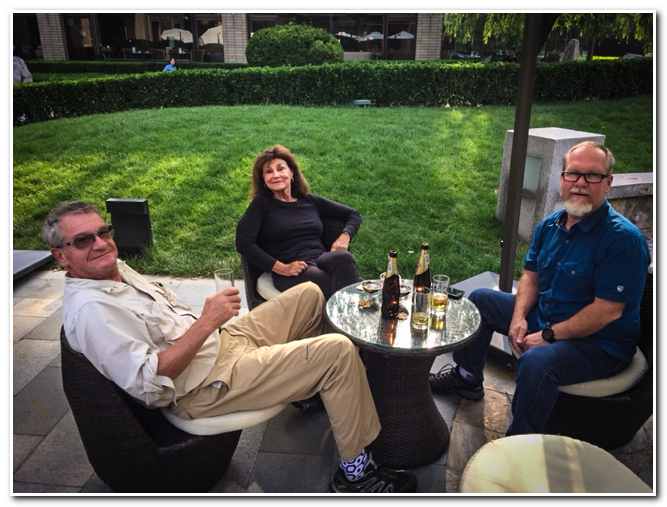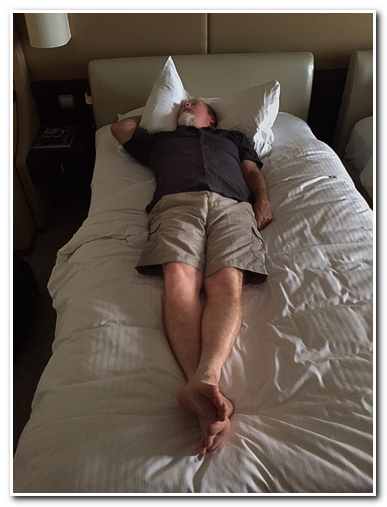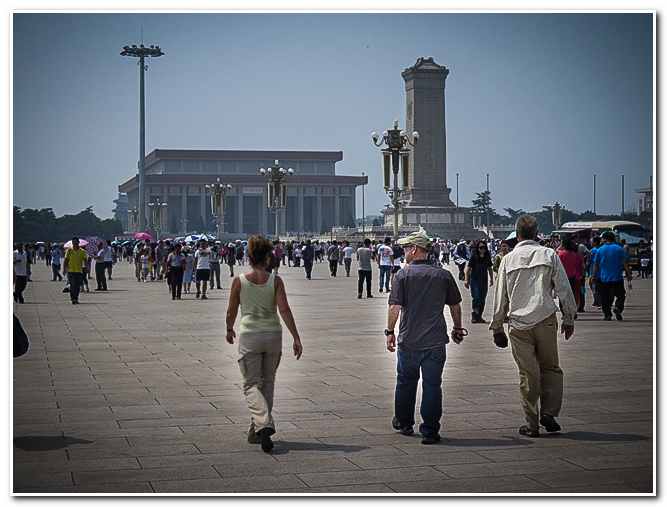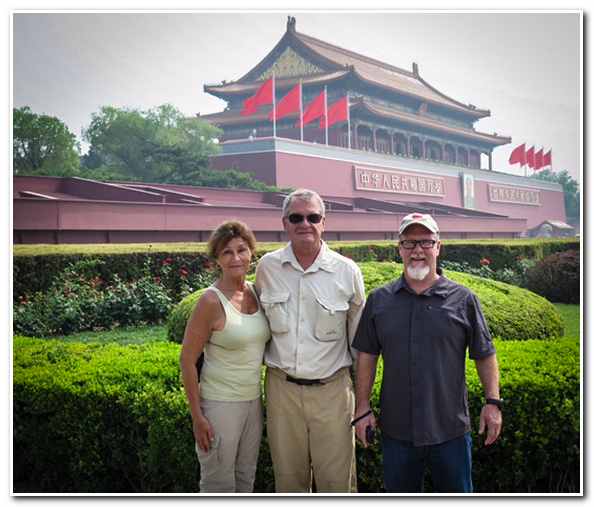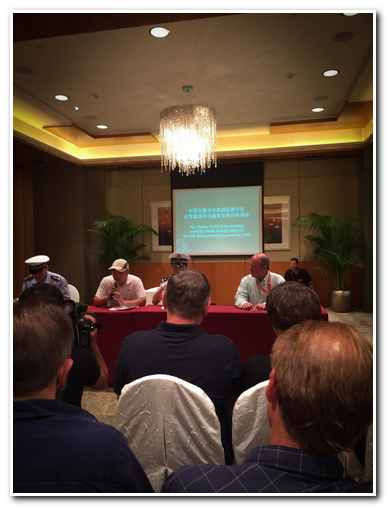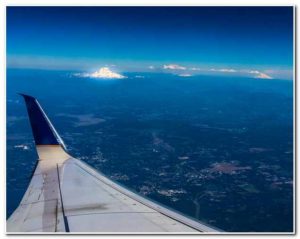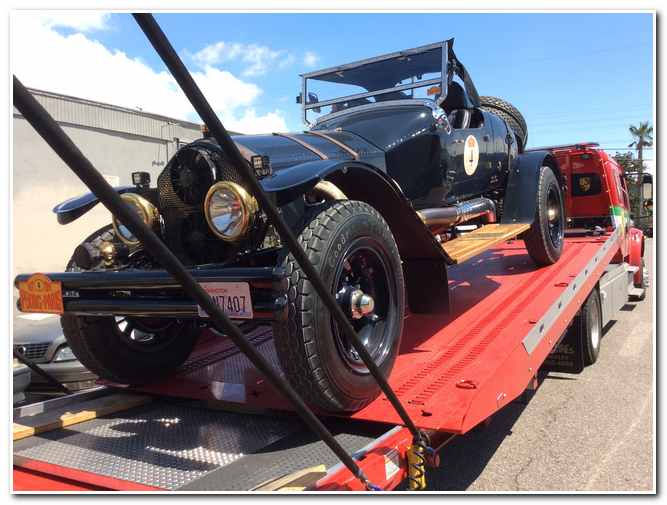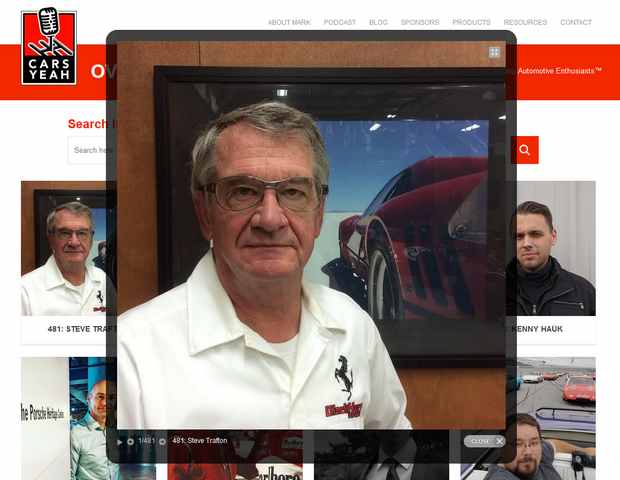Time To Drive Home
Time To Drive Home
A week after our return from our Fall hike in Europe, Katherine an I left for Rangely, Colorado to pick up where we left off on our (ALF or American La France) tour of the western states. Our plan was that my brother Ike would come with us to drive our truck and trailer along behind to act as a safety net in case some major mechanical issue arose. I also convinced Tim Taylor and his wife Judy to meet us in Rangely and tag along for a few days as we drove the ALF through eastern Utah on the way home to Whidbey Island. Tim was the Manager of the Black Horse Racing team when we set the Land Speed Record in 2010 at Bonneville, and the person responsible for the fabrication of the two ALFs in the Black Horse stable.
On Wednesday October 2nd, Katherine and I caught the early ferry boat to the mainland and drove over Snoqualmie Pass. We met Ike in Cle Elem at 7:00 a.m., then drove by Yakima, Pasco, Pendleton, La Grande, Ontario, Boise, Twin Falls, Salt Lake City, and Evanston, Wyoming where we stopped for the night after driving 900 miles. We still had over 200 miles to go, but we were in good position to reach Rangely by noon on the 3rd.
The next morning, we pushed on, past Fort Bridger, and Manila. Then we retraced our route from earlier in the year through Flaming Gorge and Vernal, Utah, and finally through Dinosaur, Colorado and on to Rangely. After a quick lunch at a local Café we drove over to the Rangely Automotive Museum to be reunited with the ALF. At noon, Tim and Judy arrived and Bud gave us all a grand tour of his remarkable collection of vintage cars and motorcycles.
On Thursday October 4th, Tim and I went to work preparing the ALF for her homeward journey while Ike, Katherine and Judy left to explore a nearby arroyo with interesting sandstone features. Almost immediately Tim found the cause of the misfire that developed during the last leg of our trip to Rangely. The electrode between the distributor cap and the rotor had disintegrated so that we were only receiving a very weak charge…and sometimes no charge at all. After a quick trip to the local NAPA store for parts, we were able to fix the distributor cap. A few miles of road-testing confirmed that the ALF was road worthy.
On Friday October 5th, we spent most of the morning doing maintenance on the ALF, checking the brakes, fluid levels, etc. By noon we had the ALF loaded on the trailer and were ready to go. We said our goodbyes to Bud and promised to return next year. We left Rangely that afternoon and headed for Grand Junction. After crossing Douglas Pass, we then took Interstate 80 west across the Utah/Colorado border. We exited the Interstate near Cisco, Utah and then off-loaded the Alf and Katherine and I began our drive along the Colorado River, through Castle Valley to Moab, Utah. Ike drove the truck and Tim and Judy followed as we made our way through the high desert landscape. Castle Valley views included great sandstone mesas and towers reminiscent of an old western movie set. After 40 miles the road entered a canyon and followed the river all the way to Moab. This day had been one of the best “ALF tours” we had ever driven.
On Saturday October 6th, we left early for a tour of Arches Nation Park. After entering the park, the ALF started up the steep road to the high plateau that features the spectacular sandstone natural arches and formations for which the park is famous. We stopped to visit Wall Street, Double Arch, the Windows, Delicate Arch and Landscape Arch on our fifty-mile tour.
On Sunday Oct. 7th, we said good-bye to Tim and Judy, who needed to return to Dallas, and Katherine, Ike and I loaded up the ALF, then drove south to Blanding, Utah. At Blanding we turned west on highway 95 heading toward Lake Powell. After a few miles we pulled over, took the ALF off the trailer, and began our one hundred and seventy-five-mile tour north to Capital Reef National Park and Torrey, Utah. Once again, the drive was through beautiful high desert terrain. sandstone mesas, sweeping lake views and narrow canyons which made this trip well worth the effort. Shortly after passing through Capital Reef came to the town of Torrey. This marked the end of the ALF tour. We loaded the ALF one last time on its trailer and headed for home, certain that we would return next year to further explore more of the American southwest.
Traftons Make Fall Hikes in Europe
The Grand/Grand Traverse
Over the past ten years Katherine and I have undertaken a “Grand Traverse” of Europe. Our goal has been to hike from the headwaters of the Thames River to the Slovenian border. After completing the Thames River Trail in 2010 we then set out from Ostende, Belgium and hiked across Belgium to the intersection of the Belgium, Luxemburg and German borders. Then south along the Luxemburg/German border to France. After that we would hike south across eastern France to Lausanne, Switzerland. From Lausanne our trek continued via a high route across the Swiss Alps to Lichtenstein and on along the mountains of the Swiss/Italian border. Our route then followed the Italian/Austrian border through the Dolomites and Austria’s Leinzer Alps to Plockenpass near the Slovenian border.
As of the beginning of September, 2019 we had completed all but a small segment of our intended route about 150 miles in length, in southern France between St. Maurice sur Moselle, France and Lausanne, Switzerland. For “extra credit” we had also completed a hike around and over Mont Blanc (2010), around the Matterhorn (which I climbed in 1996), and the famous climbers “Haute Route’’ between Chamonix, France and Zermatt, Switzerland (2012).
Since we were nearly at the end of our “Grand Traverse” we decided to expand the project by adding a traverse from Lausanne to Monaco on the Mediterranean, thus turning our traverse into a West/East and North/South” Grand/Grand Traverse” of Europe.
This September Katherine and I set out to complete the first leg of our Lausanne to Monaco hike and to then head north and whittle anyway at the remaining 150 miles of our West/East European traverse.
High Level Route La Chapelle D’Abondance to
Chamonix, France
September 9, Katherine and I flew to Geneva, Switzerland and then took a train to Montreux. After overnighting in Montreux, we took a short train ride to Monthey, Switzerland then hired a car to take us to our starting point at the Hotel Les Cornettes in La Chapelle D’ Abondance (3350’), France.
I should add that in 2014 we had hiked over the mountains from Lake Geneva to our starting point, but persistent rain storms prevented us from going any further.
We started along the road out of town and, in about a half mile turned right at the metal cow sculpture and headed up into the foothills toward the Trebentaz Hut (6102’).
After about three hours, we arrived at this scenic perch high above the Valle D’ Abondance.
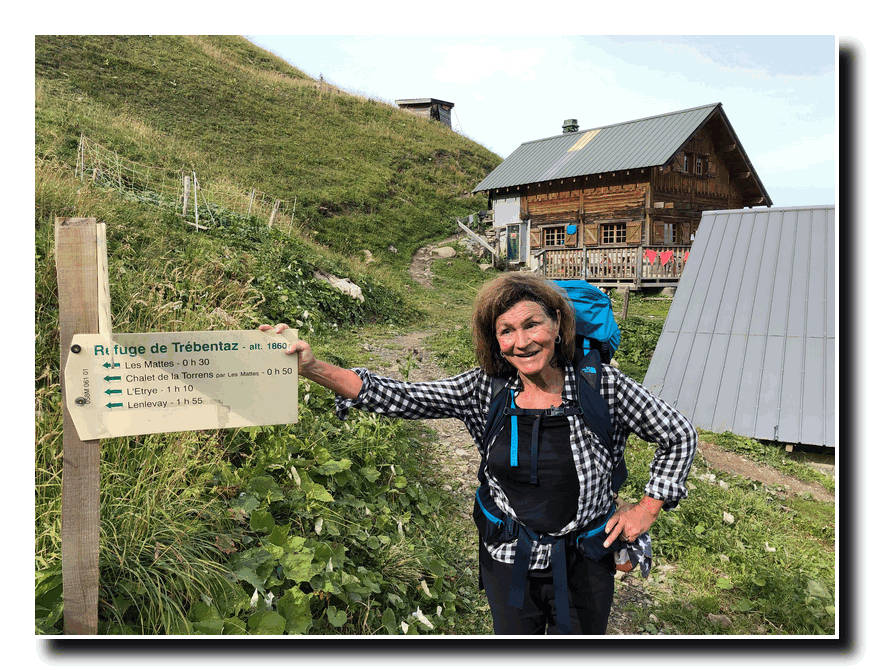
The next morning, we set off from the hut and climbed up and over a pass (7000’), and then down and across a beautiful plateau to the Col de Bassachaux (5833’).
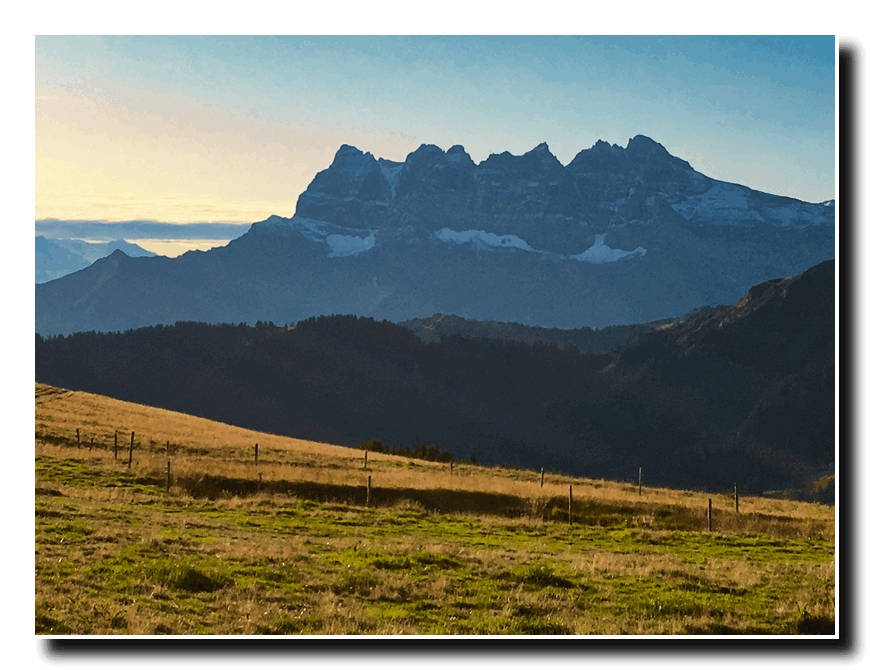
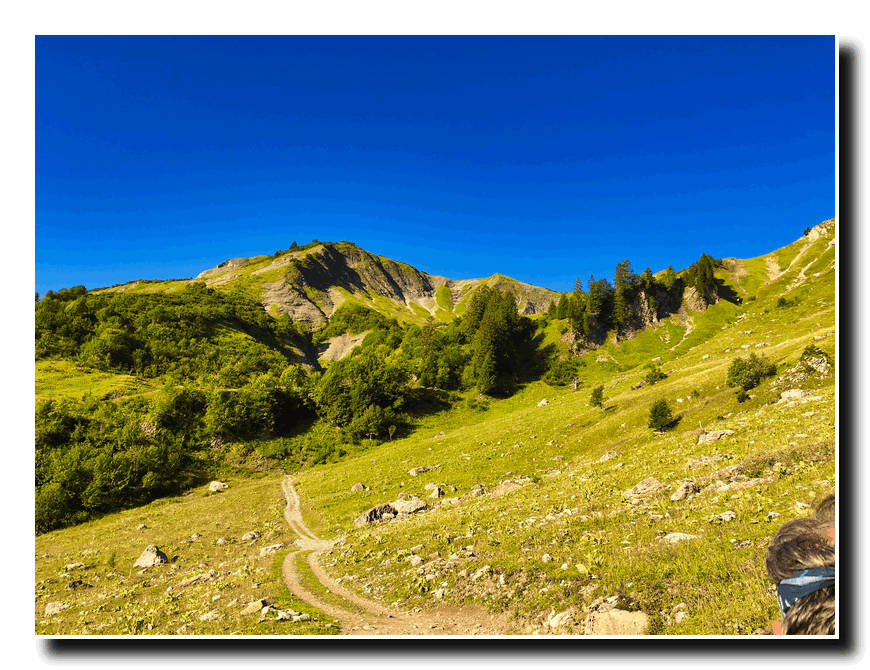
After a short rest we continued across rolling terrain to the Col de Chesey (6535’) on the Swiss border.
From here it was a short hike to our stopping point at the Refuge de Chesery (6470’) where we spent the night.
On the 12th, we left Chesery and hiked up to the Portes de I’Hiver (6877’)…
…and then down once again Chaux Palin (6047’) and across a long rolling plateau…
…and down to a farmhouse at La Poyat (5347’). Here the trail rose sharply up to the Col de Croux…
…and into France once again. Then it was down again to 4660’ before climbing up to the Col de la Golise (5453’). From the Col de la Golise it was a long downhill trudge to the village of Samoens (2306’). This strenuous day had a total ascent of 2200’ and a total descent of 6365”!
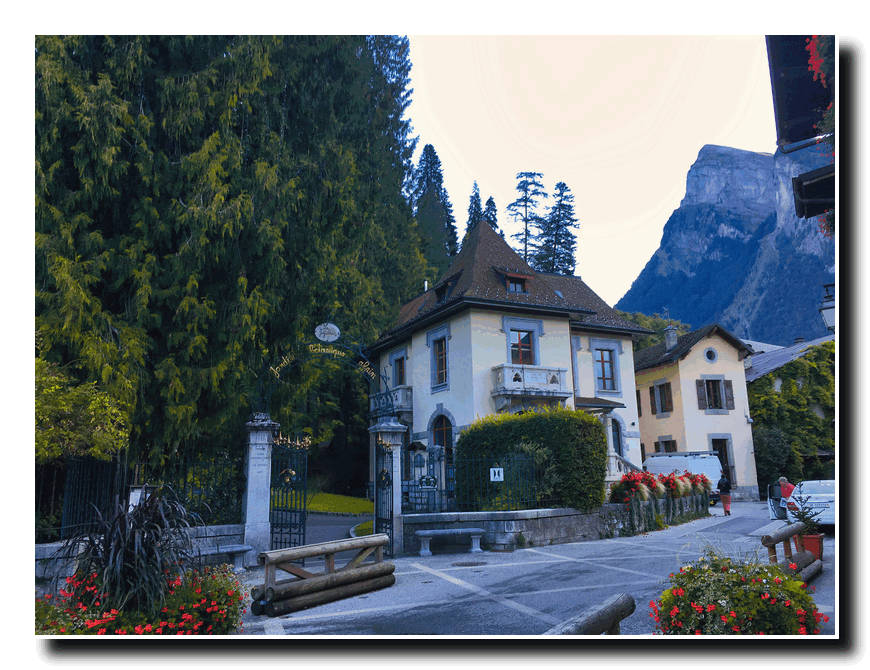
We set out from Samoens at eight the next morning (the 13th) and hiked along a river for about two miles before beginning our hike back up once again. We hiked up the Gorges des Tines, using ladders to climb past several cliffs…
…and on upward to the Chalet de Lignon (3870’) where we had lunch before continuing on up the Collet d’Anterne (5892’).
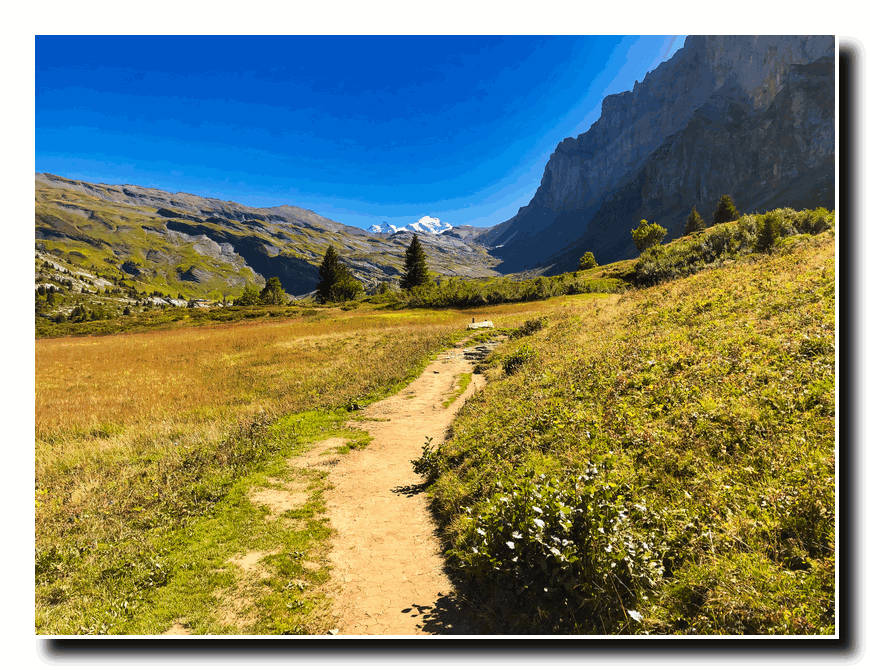
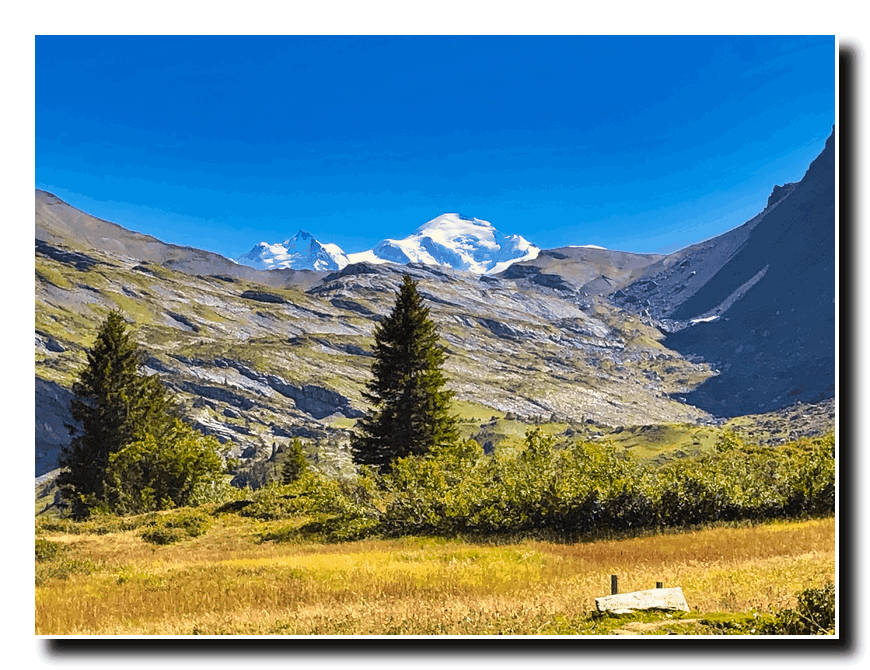
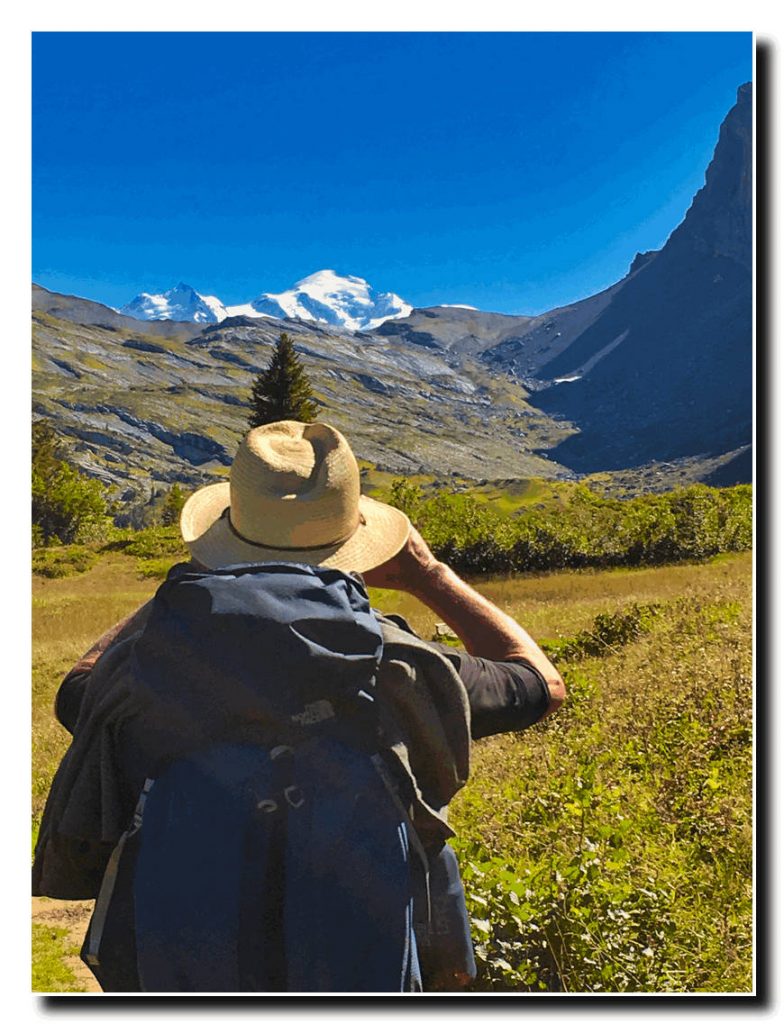
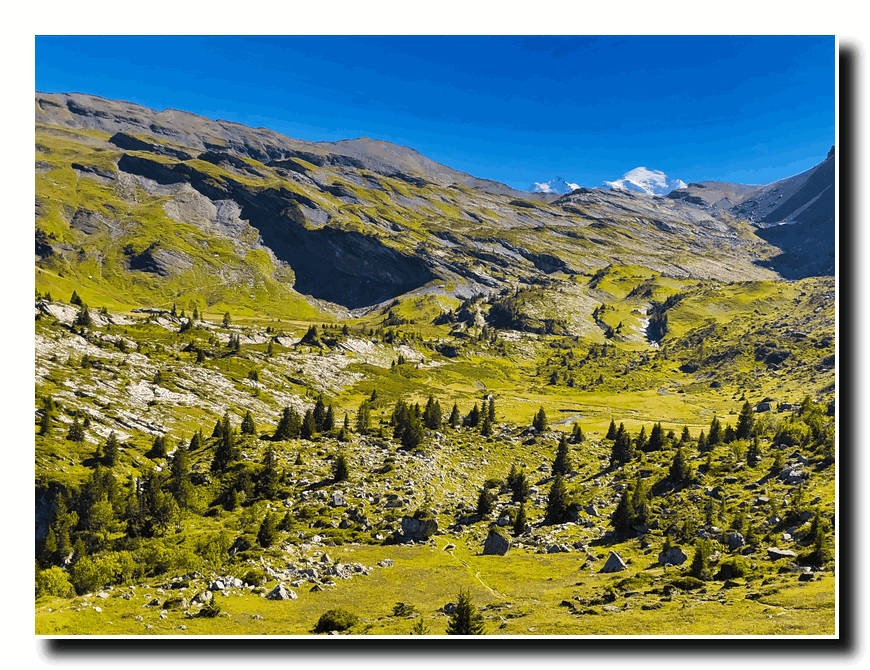
Here we were treated to our first view of Mont Blanc. We had reached another high plateau and it was but a short walk to our stopping point for the night the Chalets d’Anterne (5932’).
On the 14th we continued on and hiked up to the Lac d’Anterne (6750’) and then up to the Col d’Anterne (7405’), a 5100’ ascent from Samoens.
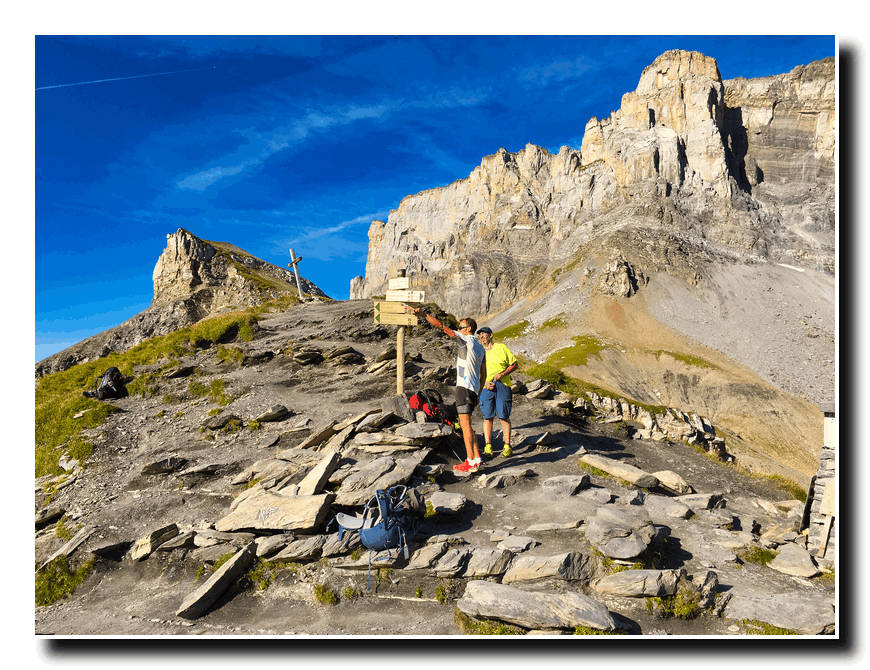
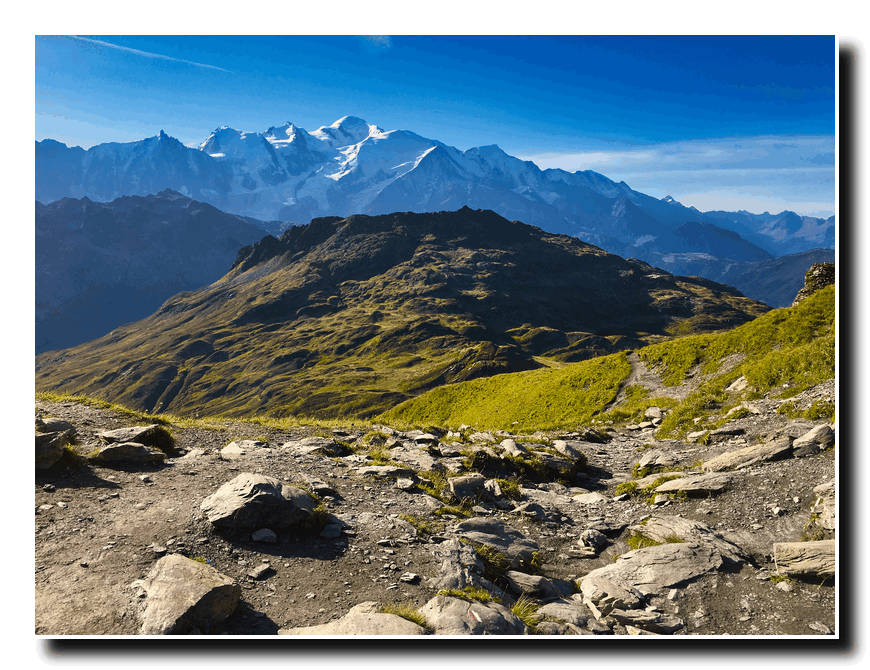
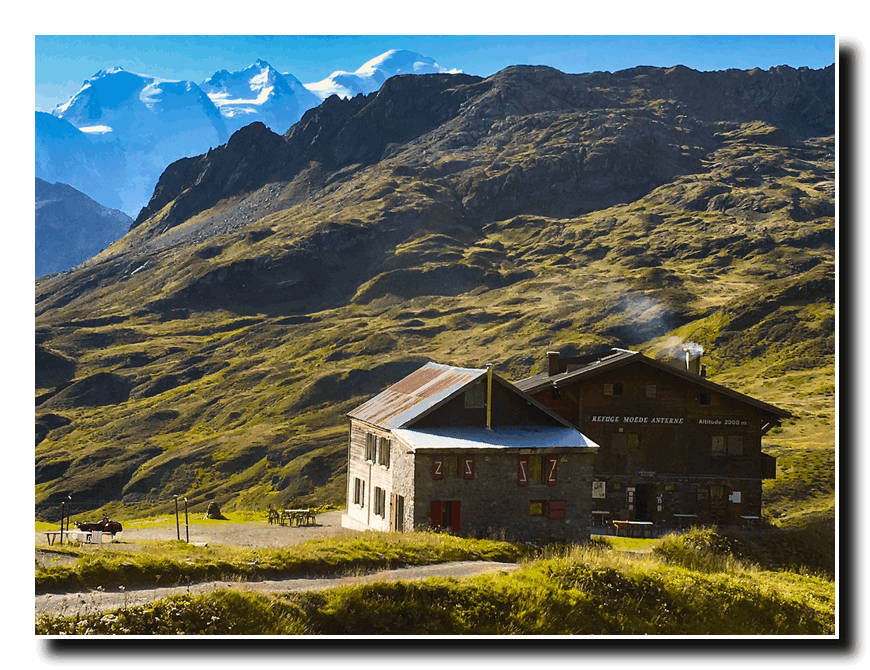
Then it was down again to the Pont d’Arleve (5240’, a bridge across a small river at the bottom of the valley. From here it was a three hour slog up a mountainside to the Col du Brevent (7769’). What a view!
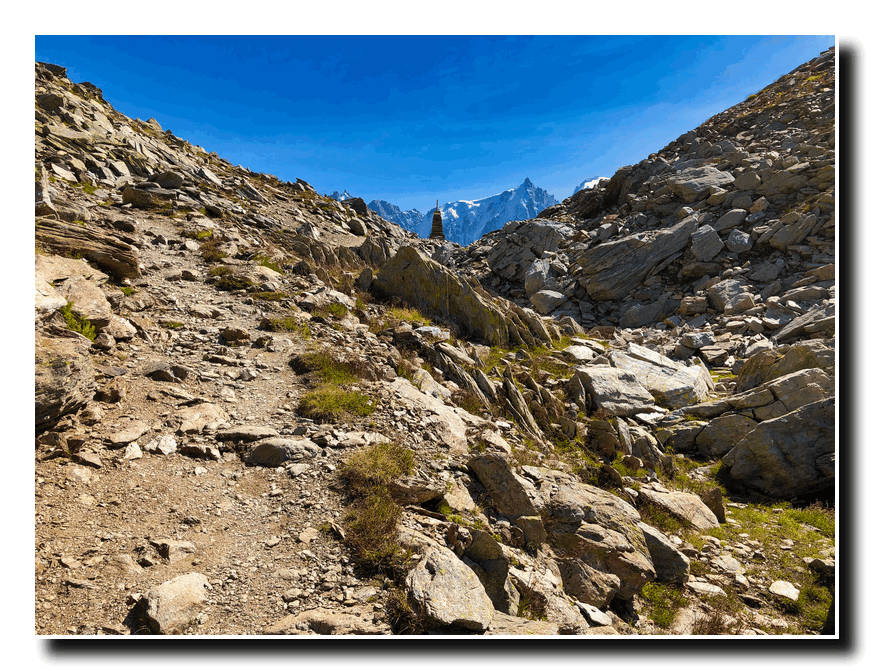
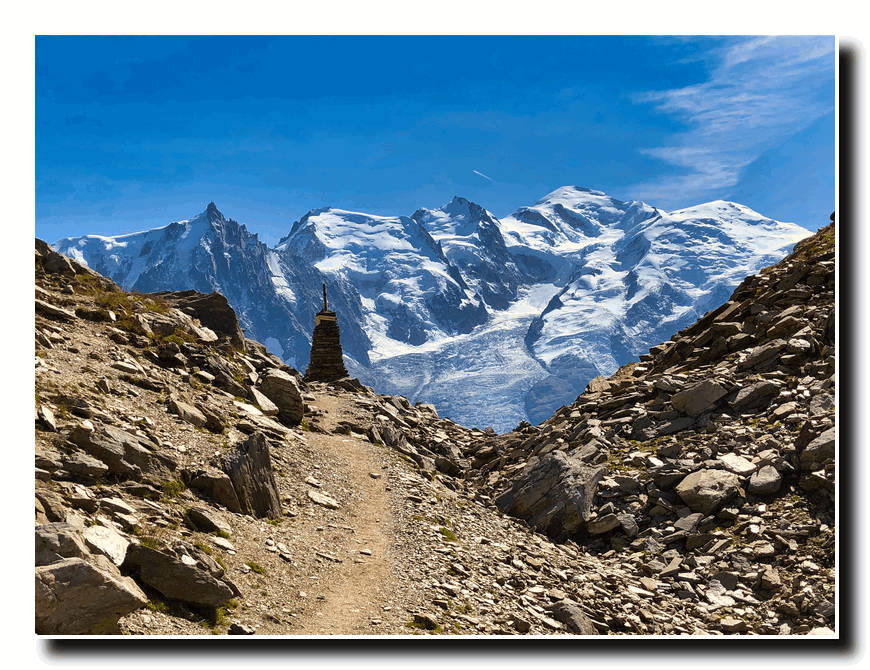
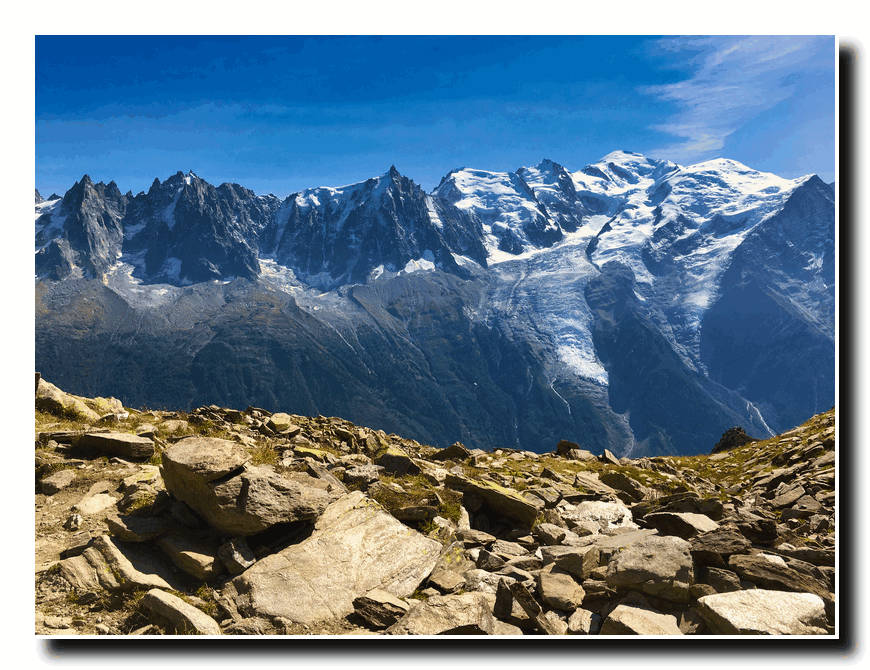
The entire Chamonix Valley lay before us. After a short rest we headed on up the Le Brevent (8284’).
Here we intersected the trail we had taken during circuit of Mount Blanc in 2010. After resting on top of Le Brevent we took the tram down to Chamonix and spent the night before heading north to the St. Maurice sur Moselle.
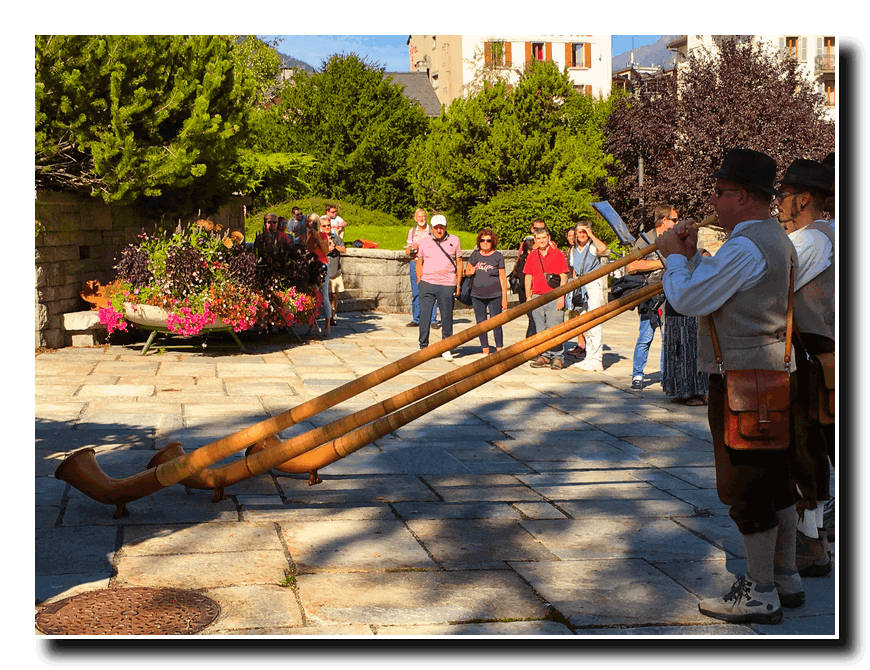
Hike Between St. Maurice sur Moselle, France and
Porrentruy, Switzerland
September 15: After a good night’s rest and some great French cuisine in Chamonix, Katherine and I set off for St. Maurice Moselle, the endpoint of our hike through the Moselle River Valley, about 150 miles north of Lausanne. We traveled by bus from Chamonix back to Geneva, where we caught a train to the beautiful town of Strasbourg, France where we spent the night. The next morning, we traveled by train to Nancy, France and then to the small town of Remiremont, France.
September 17th, we left Remiremont and traveled by bus to our starting point at St. Maurice sur Moselle.
We hiked up a trail which climbed from the Moselle River Valley up to the summit of the Ballon d’Alsace. We took a short rest here and admired the great Bronze Statue of Joan d’ Arc.
From here we hiked a short distance down the road to a statue commemorating the lives of soldiers tasked with disarming land mines during World War II.
Then we followed a trail on down through the forest and along the La Savoureuse River to the town of Lepuix and on to the town of Giromgny, France, where we spent the night.
September 18th, we left Girongny and hiked out of town where we picked up the trail through the foothills and down to the village of Bas-Evette. From there, largely on bike paths, we hiked another ten miles into the city of Belfort, France where we spent the night and planned the last leg of our route to Porrentruy.
September 19th, we left Belfort and hiked on country roads and bike paths east to the small town of Delle, France and then took the train to the town of Porrentruy, Switzerland.
September 20th, we took the train back to Delle and hiked a short distance along the road to the Swiss border at Boncourt, Switzerland in the foothills of the Jara mountains.
From Boncourt we followed trails through foothills and along a river valley to Porrentruy.
We now had only about one hundred miles left to go on the West/East European traverse. Our plan is to complete this last segment of our journey in the Spring of 2020.
Traftons in Peru
High Adventure Begins
.
.
June 6, 2019: Katherine and I flew from Seattle to Dallas, then boarded our flight to Lima which landed in Cusco, Peru. We arrived on the morning of June 6 and spent the day with a walk around Cusco while acclimating to the 11,250-foot elevation of the Andes Mountains.
.
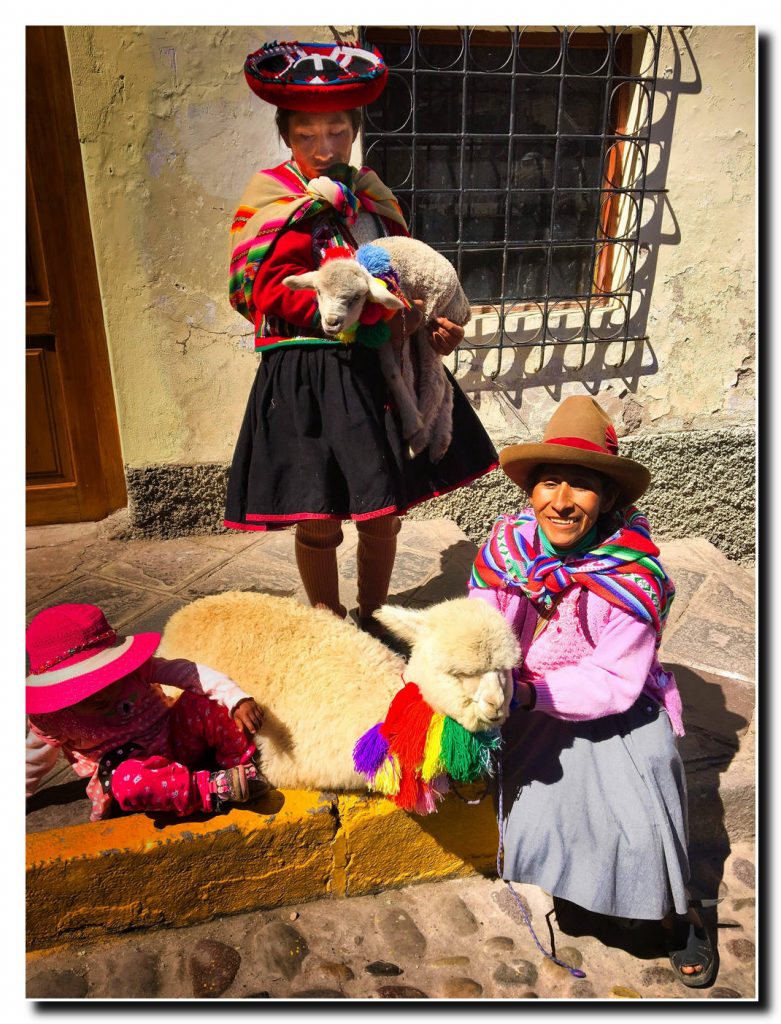
June 7, 2019: We spent this day taking longer walks which included several up and down hill-climbs in town. Then we watched the military parade at the central square celebrating Inti Raymi’rata…or the summer solstice… which actually occurs later in the month.
.
.
(Click image to view large size.)
.
.
June 8, 2019: We moved to our new hotel and met the rest of our hiking group. Afternoon was spent touring the city of Cusco, which included a visit to the Santo Domingo Church built atop the ruins of the Inca Temple Coricancha (Temple of the Sun). In the late afternoon we drove to the top of the hills around the town and walked through the ruins of Sacsayhuaman, a magnificent Inca fortress.
.
June 9, 2019: On this morning, our group boarded a van which would drive us to the starting point of our hike through the Andes. Along the way we stopped at the Inca site of Quillarumiyoc. Then we drove on to Mollepata, a small town where we had lunch before continuing on to Challacancha at 11,900-feet. Here we would start our hike of two and a half miles. There was 800 feet of elevation gain to Soraypampa and our accommodations at the Salkantay Lodge. The lodge is situated at the edge of Soraypampa and is dominated by spectacular views of Humantay Peak (19,412 feet) and Salkantay Peak (20,500 feet).
.
.
June 10, 2019: We started early for a 1,200-foot hike up to a beautiful emerald green Humantay Lake, nestled below the imposing peak of the same name. Once we had explored around the lake we continued up to the top of a knoll (14,000 feet) where a shaman blessed tomorrow’s hike over Salkantay Pass (15,213 feet).
.
.
June 11, 2019: We started early again for our 8 mile hike over Salkantay Pass. Leaving Soraypampa behind, we made a gradual ascent up the valley toward Salkantay Peak. Rounding Humantay, the trail steepened as we switch-backed toward the pass. Since the group was moving a little slowly for Katherine’s and my pace, we moved ahead and arrived at the pass about 20 minutes before the others. The hike to the pass was about four miles and 2523 feet of elevation gain. After a short rest at the pass, we began the 4-mile descent to the Wayra Lodge (12,812 feet) where we spent the night.
.
.
June 12, 2019: Starting at about 9 am we began our 3400-foot descent down from the breathtaking alpine scenery we had enjoyed during the last few days and then disappeared into the cloud forest below. Three hours later we arrived at the Colpa Lodge (9,914 feet), located on a 1,000 promontory above the confluence of three rivers.
.
.
June 13, 2019: Today we continued to descend by hiking down a step-way trail into the Santa Teresa River Valley. After 5 or 6 miles we began to hike past coffee plantations, banana trees and passion fruit orchards. We hiked on for another two or three miles to a big suspension bridge which crossed the Santa Teresa River. We met a van which drove us about 30 miles down valley and then hiked up an old trail to Lucma Lodge. At 7003 feet in altitude, we were now 8,210 feet lower than Salkantay Pass.
.
.
June 14, 2019: After breakfast we set out for climbing up the Inca Trail toward Llactapata Pass (8,974 feet). The 2,000-foot climb seemed easy in the denser air of the lower altitude. After crossing the pass we began our 3,165-foot descent to the Urubamba River in the valley below. On the way down we got our first view of Machu Picchu in the distance, across the valley. As we approached the river, we walked past avocado orchards and bamboo forests until we reached the train station for the ride up to Aguas Calientes, located a short distance from the ruins of Machu Picchu.
.
.
June 15, 2019: After breakfast we caught the bus up Machu Picchu (7292 feet) and spent the whole day exploring. Rediscovered by American Hiram Bingham in 1911 and restored to a great extent during the intervening years, we were able to appreciate the intricate Incan architecture and stonework. We also walked to an Inca drawbridge. Built into a vertical cliff, it also was one of the entrances to Machu Picchu. Another hike was up to Inti Punku (the Sun’s Gateway). That afternoon we toured the various structures and received lectures on the “city” of Machu Picchu itself.
.
.
June 16, 2019: We returned to Machu Picchu where I hiked to the top of Huayna Picchu at 8,835 feet. That is the prominent mountain which is the viewpoint for many pictures of Machu Picchu. While I was climbing, Katherine climbed the much higher Machu Picchu Mountain (10,007 feet).
.
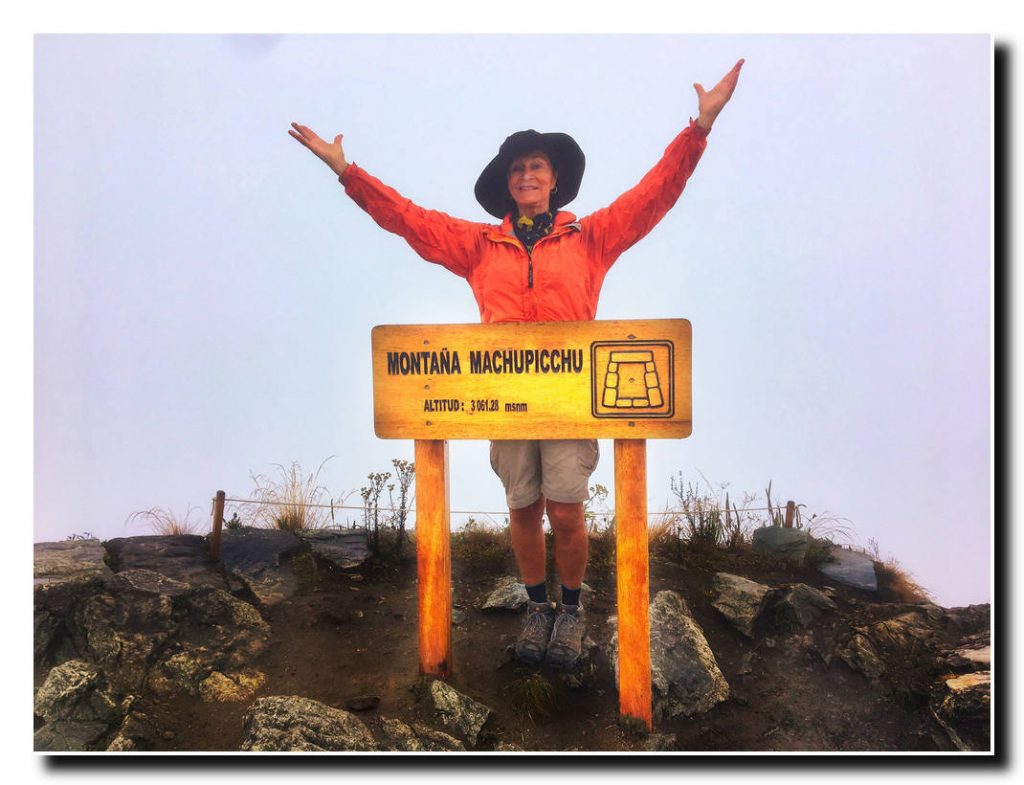
.
June 17, 2019: We returned to Cusco and celebrated our 40 miles of hiking trails with 9800 feet of elevation gain and 15,237 feet elevation loss. This was a spectacular journey!
Traftons in Alaska
Those Traftons were at it again and this post shows a few more photos and some short video clips of their Alaska adventure.
Click on any image to see all of them in larger sizes.
Once Again Twice Another Time
At about 6 PM PDT, this was their progress. You can see exactly where the boys are now by checking their GPS.
Of course, nothing much happens in Alaska or the Yukon, or B.C. You just see an occasional cow by the road, and then you move on.
With typical American originality, one of the boys yells, “Hey!”. No wonder this cow made no motion to acknowledge them. It should be “MOOO”, you know.
They decided to drive ALF #4 for a-ways and then trailer it, even though the 1925 classic speedster gave them no problem. You can just imagine the strange looks they received from an occasional oncoming vehicle, as they drove a very isolated Alcan Highway. “Martha! What was THAT?” Those oncoming cars may have thought they were entering the Twilight Zone.
Anyway, here are some photos that the Alaskan Pony Express just delivered. From Christochina to Fairbanks, to the Yukon and south:


More Later…
Pick Yourself Up and Start Again
Refusing to accept defeat, the Blackhorseracing.com team took the sick 1915 ALF #1 classic speedster all the way back to Seattle (on a trailer) and are immediately returning to Alaska to retrieve ALF #4. This time, they are taking a different route up the Alcan, from Cle Elum, Washington north all the way back to Glennallen, Alaska. Here are photos of some of the crew who participated including Steve and Katherine, Matt, Guillaume, Dwight and Byron.
As of 2:15 PDT, Steve, and Dwight had crossed back into Alaska on their way to Glenallen and ALF #4. Follow along here.
The plan, hatched over a hearty meal, is to drive the ALF #4 part of the way down the Alcan and then trailer it back to Seattle.
Here are a few photos from their journey.
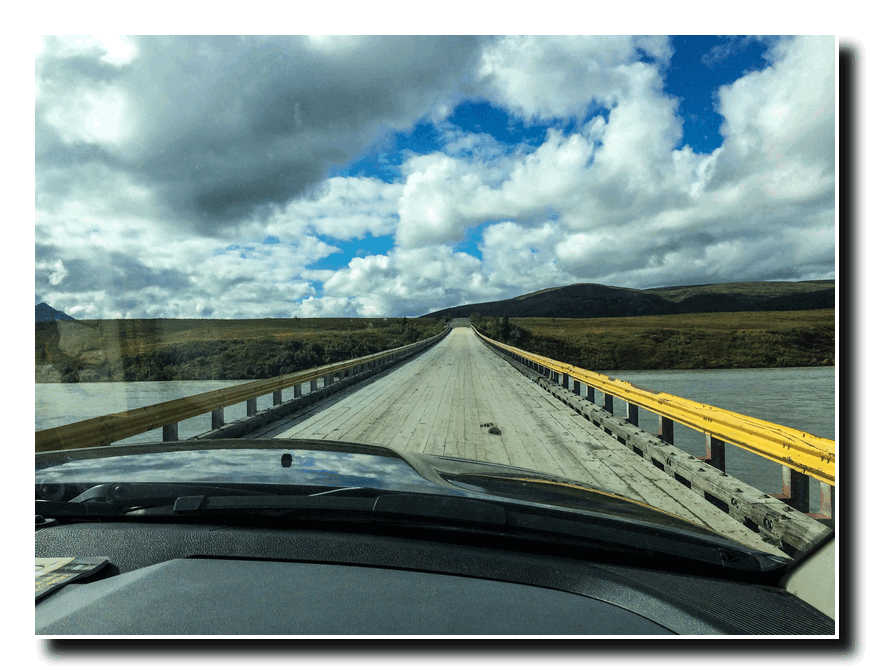
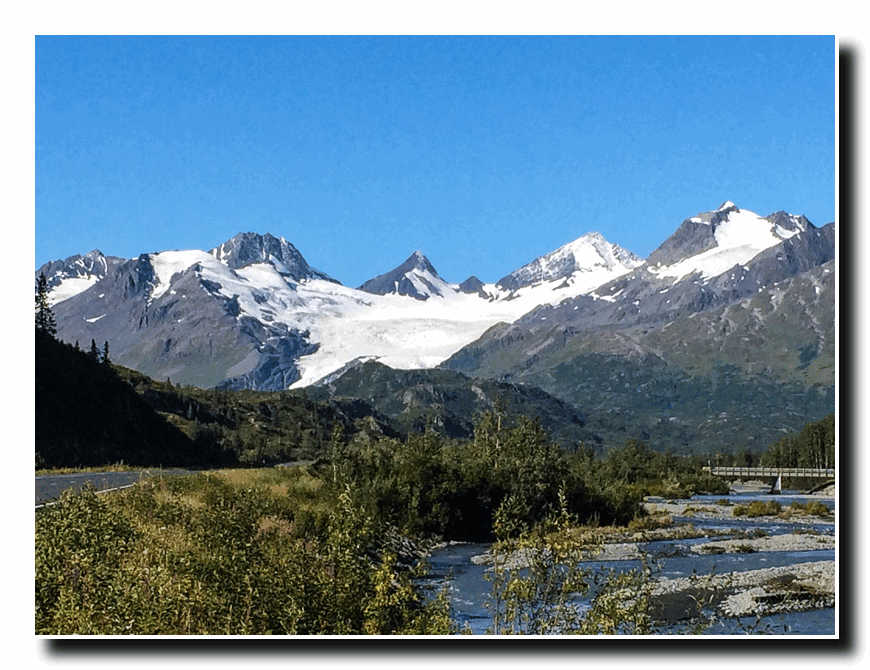
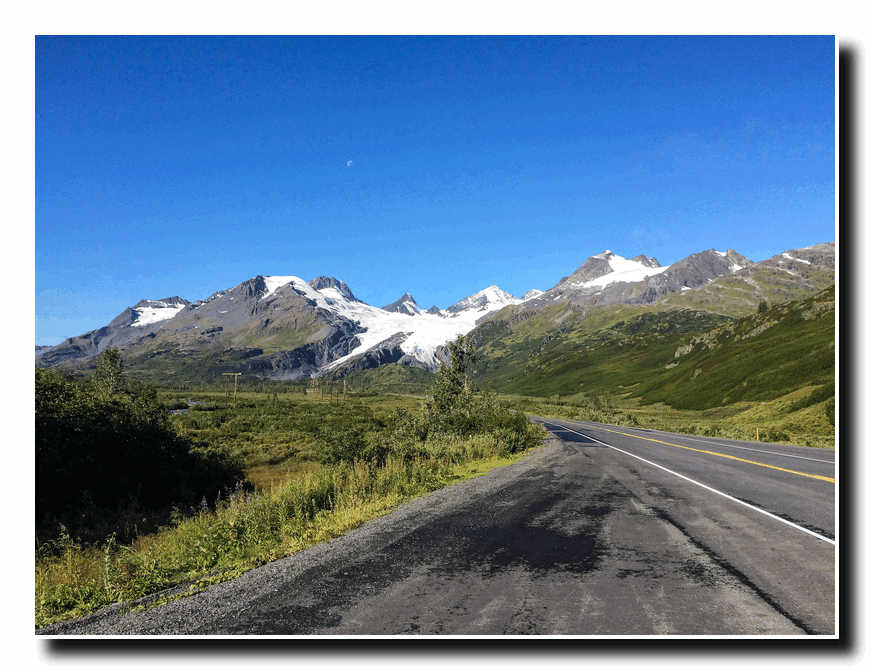


Oh Shucks
Well some mornings you can barely chew through the straps on your straight-jacket. Frustration attacked the Blackhorseracing team as their ALF#1 overheated again and it could not even be coaxed to work for it’s chug down the Alcan Highway. You’d think this car was built in 1915 or something. So here’s the deal: the working ALF #4 was warehoused and left in Glenallen, Alaska, while the ALF#1 is being trailered back to Seattle for a waterboarding torture. The team feels that if they separate the twin classic cars, it’s an appropriate punishment for the difficulty they put the racing team through.

Anyway, the scenery has been lovely, even through clenched teeth. All four team members are riding in the Dodge Ram as they trailer south to Seattle.
As of about 4:30 PM Yukon Time, the crew was stopped temporarily at Watson Lake, Yukon Territory.
Watson Lake is primarily known for its Sign Post Forest…
The dry-mouthed boys paused for an anticipated refreshment and went looking for the appropriate recreation. Unfortunately, they found a recreation center, but it was not exactly what they hoped for.
So they continued south. As of 6:15 PM Pacific Coast Time, they are here:
At Good Hope Lake
Gentlemen, Start Your Engines
After picking up Guillaume Marceau and his father at the Anchorage Airport, and after an extra day of engine tinkering and severe indigestion from ALF #1, a decision was made to trailer that classic-car for a ride back to Seattle. Well, it’s punishment you know. Here is the GPS link for the remaining ALF #4 so you can follow its progress. Steve is driving ALF #4 with Guillaume acting as navigator. The two other fellows will enjoy their views of Alaska in the Dodge Ram with trailer. There may still be downtime repair during the journey, so be forewarned. It’s not as if they are in the middle of nowhere with early 1900 cars you know…..oh…right. Well, it’s not as though they are in the middle of Mongolia you know.
Here is Guillaume trying to solve the overheating problem by feeding ALF #1 a bottle of Pepto Bismol.
But nope.
ALF #1 is much too valuable to become a doorstop (although they threatened it by reminding it of this steam shovel they had seen the day before). So a decision was made to load the sick puppy on the trailer, and drive it back to Seattle.
Brother Byron and Wife Katherine said their goodbyes and winged their way back to civilization as Steve, Dwight, Guillaume and Rick were left to drive south to Seattle along the Alcan highway where traffic signals are just rough guidelines and arrival at your destination is not a foregone conclusion.
Anyway, here are a few photos:
The proposed route for today.
You may want to look at their GPS destination (see the link above), then go over to Google Maps and
Browse the Street View Images to see what they are seeing (as below).
More when there’s more…
Getting Ready to Drive the Alcan
At Whittier, Alaska both American LaFrance vehicles
unload to begin the journey down the Alcan Highway to Seattle
The Traftons (which include Steve, his wife Katherine and two of Steve’s brothers Dwight and Byron) are “LollyGagging” Alaska until other Blackhorseracing Team members (Guillaume Marceau and his father Rick) arrive on Monday. So here is their LollyGag Map:
Since it is considered disgraceful to allow grass to grow beneath the feet of any Trafton, the four travelers drove north from Anchorage to explore Alaska. They started on Thursday by temporarily shedding the two ALFs at an airport hangar in Anchorage. They had to mark time until their team would land-launch toward Seattle on Tuesday. So why not head toward the Arctic Circle like any average person would do? Through noon on Saturday (August 25), they drove 1150 miles. Staying the first night at Healy, then driving to Manley Hot Springs, reversing direction to touch base at the Arctic Circle and then going beddy-bye at Fairbanks on Friday night.
It just so happens that Katherine has a connection to Manley Hot Springs.
This is 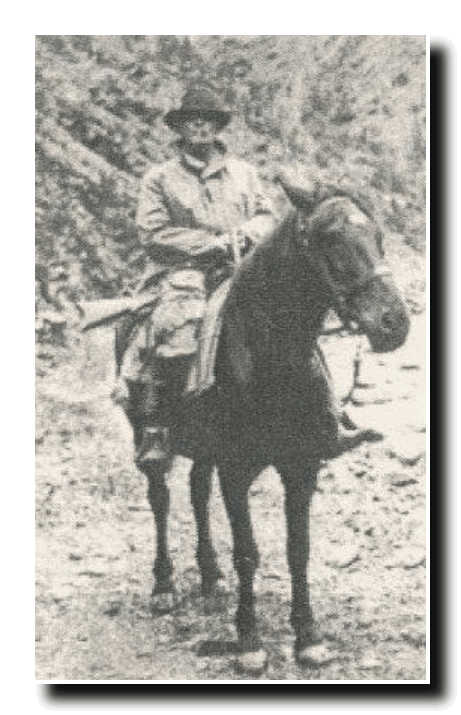
.
.
.
.
“Married at 25, my grandfather’s young bride (age 19) eventually joined her husband at Manley Hot Springs by traveling alone from Seattle by boat, then railway, then barge and overland stage in 1914. While there she worked for his uncle Frank Manley who had established a gold mining camp.
.
.
.
.
.
My grandfather’s job was to carry the saddlebags of gold on horseback over the Chilkoot Pass down to the boats headed to Seattle. He used to tell us the story of how he met a group of men en route who offered him a drink by their campfire. They had spiked the drink in hopes that they could steal his saddlebags! Fortunately, my grandad recognized his impairment and jumped off the horse to run alongside and sweat it out!
He managed to prevent the robbery!
My grandparents left camp on a dogsled to head for Fairbanks on 28 November 1914. Never made it to the hospital! My dad was born on the dogsled, in the snow! Needless to say, he was an only child!
Frank Manley was quite a character. Left Texas with some reputation. Established a better one in Alaska as “having taken more gold out of Alaska than any other single individual”. He then moved on to California and discovered oil in Bakersfield.”
But hey, the Arctic Circle still waits. So the Trafton’s backtracked their route, traveled across the Yukon River and then stopped at the exact location of the Arctic Circle for a tourist shot.
Steve checked-off another bucket list item by standing next to the Alaska Pipeline.
Then all four Trafton’s headed for sleep in Fairbanks.
As of noontime on Saturday, they headed south through Delta Junction and the Alaska Range. And here’s what they saw:
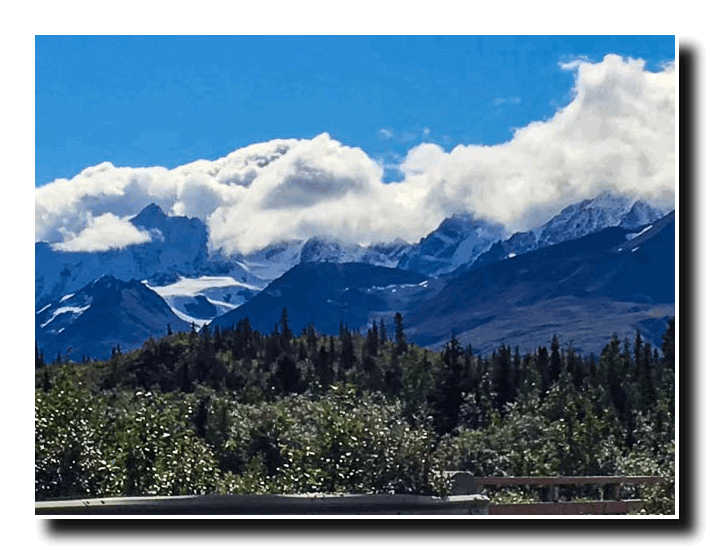
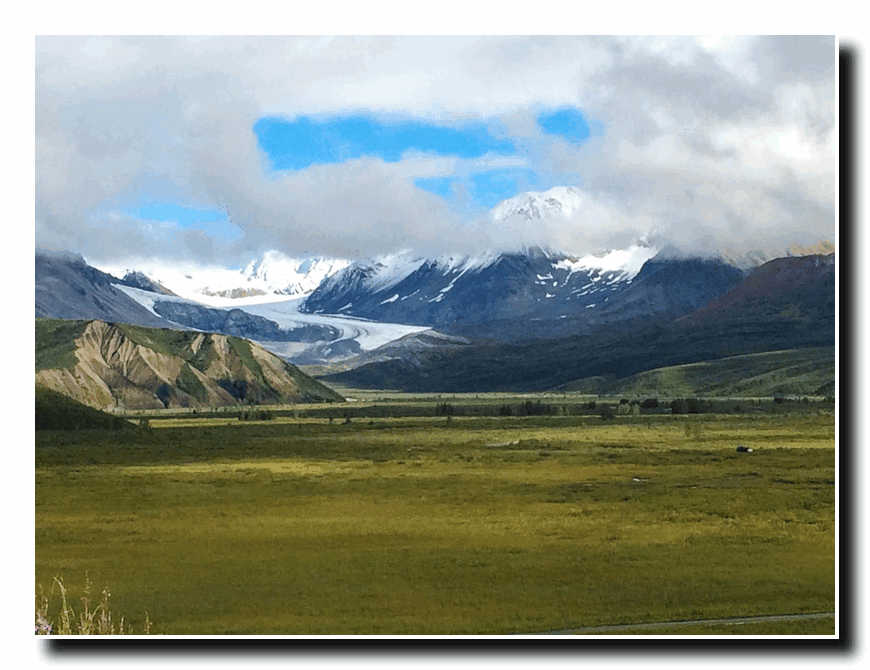
This is not fair. More tomorrow…
Inside Passage and ALF Arrival
From the Inside Passage and ports of Ketchikan and Juneau, we have received word that blue skies and great weather accompanied the Alaska ferry on its winding way north. (At least the Trafton Crew has escaped the smoky skies of the northwest.)
The ferry has now docked at Whittier and both ALFs vehicles (American LaFrance) have disembarked. Click on the GPS live links below to follow the touring progress of both ALFs (displaying numbers and 1 and 4) through Alaska:
.
Here are a few photos from the ferry ride through the Inland Passage showing the harbors at Ketchikan and Juneau. Then pictures showing a personal tour of the ferry’s diesel engines, to the 56 mile drive up to Anchorage from the port at Whittier, and finally parking to wait for other team members arrival by air on Tuesday, August 28th.
North to Alaska With Both Alfs
Both the 1915 and 1921 American LaFrance Speedsters are now being ferried to Alaska for an adventurous driving tour back to Seattle!
.
.
.
.
.
.
.
Before the trip, 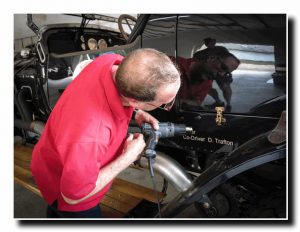
The ferry ride started from Bellingham, Washington and will disembark in several days at Whittier, Alaska.
We will follow that journey with live GPS, video and photos from the adventure. So watch this space!
The Lost Franklin Expedition
The Trafton Expedition is featured this month in Visions of the North blog.
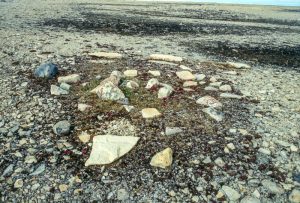
While searching out the 1845 lost expedition of Sir John Franklin, Trafton and his team discovered not only Franklin’s campsite, but a 100 year old note, left by another search party.
Read more about Trafton’s discovery in Russell Potter’s blog titled Visions of the North. Potter is Professor of English and Media Studies at Rhode Island College.
And read the entire story in Trafton’s latest book called At The Edge;
Running At The Edge
The New Book is finally here! Whew.
Here is an example of how an otherwise normal Steve Trafton has lived his life while pushing extremes. It’s an exuberant and diverse read about how living on Easy Street may become your own blind alley. Being absent from life is not what this guy is famous for. Instead, he says that taking risks and being restless in your field of interest is a road map to a fulfilled life.
Stephen Trafton is not really your average guy though. During his lifetime he has:
- survived a massive avalanche,
- set a World Speed Record at the Bonneville Salt Flats,
- pursued what became a landmark U.S. Supreme Court decision that resulted in one of the largest monetary judgments against the U.S. Government,
- climbed 600 of the world’s mountains while recording 32 first ascents,
- searched and found remnants from the lost Sir John Franklin Arctic expedition of 1845.
Of course he also:
- led more than 200 mountain rescues,
- trekked the width of the United States,
- scaled each state’s high point,
- and attempted the 8500 mile Peking to Paris Motor Challenge in a 1915 speedster.
What makes this achievement-oriented man tick? Well, there’s a method to his madness and it’s revealed in his book called At The Edge: A Life in Search of Challenge.
This former CEO of Glendale Federal Bank (now CitiBank) shows how you can push human extremes. Trafton first discovered his passion for the outdoors at the age of 12 when he scanned the Olympic Mountain Range from a perch thousands of feet above his family’s campsite. He had only left for a short walk, but ended up climbing Boulder Peak to the chagrin of his worried parents. Little did they know that this solitary adventure would spark a future life at the edge.
From retrieving the bodies of climbers caught in devastating avalanches,
-to roaming the remote Arctic in a dozen journeys.
From surviving hurricane force winds while trapped in a mountainside tent,
-to reaching pristine summits of unclimbed peaks.
These are events that shaped the life of an American adventurer, driven to do things that few people have tried.
With color photographs that help document his many excursions, escape into the mind of a true explorer who thrives on the next adventure.
You can read excerpts as well as see extra photos (starting with Baffin Island 1978) that were not published in the book. See the New Book tab above for more.
ALF Tours Southwest Montana
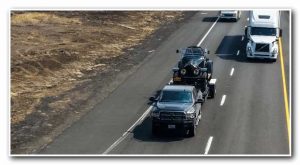
The 1915 American LaFrance Speedster was driven by Steve and Katherine Trafton to Jackson Hole, Wyoming where they started the tour.
.
.
.
.
.
Everywhere they went, the ALF became a surprising center of attention
to the many tourists who had only expected to see wildlife.
The Grand Tetons provided a magnificent backdrop,
even though smoke occasionally intruded.
A welcome rain came on just one day
and did not affect the drive north to Yellowstone Park.
It was across the park and up the Bear Tooth Highway
to the 11000 foot summit for incredible views.
Then it was time to trailer the ALF and drive on to
Earthquake Lake, Beaverhead Rock, Three Forks and its museum,
Ennis and over the hill to Virginia City.
It was on to the Big Hole Basin and
isolation near Wisdom, Montana.
While jumping off the trailer Steve broke his foot in two places.
But after it was attended to in Anaconda,
Steve was back to the more serious business of touring for Blackhorseracing.com.
Time to head back to Washington State,
so Katherine helped load up the ALF to head back.
Pretty good trip. Yes it was.
July 4th Parade on Whidbey Island
Maxwelton’s July 4th Parade on Whidbey Island was a typical small town affair. As a matter of fact, Maxwelton doesn’t really have a town. But nevertheless, a fun time was had.
July 4th, 2017 was as good an excuse as any for the ALF and the Black Horse Racing Team. Here are a few photos from that day, some contributed by David Welton of WhidbeyLife Magazine.
.
See some of the photos we took below. Click on any one to see it in close-up.
.
.
.
ALF Wins All Wheels Weekend
.
A small central Washington parade and Combine Demolition Derby sounded oddly interesting. So Steve and Katherine Trafton took their 1915 American LaFrance (ALF) vehicle east across the mountain highway to Lind, Washington.
.
.
.
Later, touring Washington’s Palouse country, they stopped in at Dayton for the All Wheels Weekend and surprisingly won the highest award. See the photos below.
Click Photos to Enlarge the Collages
.
ALF at Classic Auto Show in LA
.
.
The Classic Auto Show in Los Angeles played host to one of our two ALF (American LaFrance) vehicles on January 27-29, 2017. Some of the Black Horse Racing Team was in attendance to answer questions put to them by attendees. Steve Trafton was also interviewed for the podcast at HorsePower Online. (The podcast is also available online for both the iPhone and Android.)
.
.
.
.
.
.
See some of the photographs from that event in our Gallery.
.(Click to view in close-up.)
Retrospective
From Byron Trafton:
Black Horse Racing’s Peking to Paris Rally ended in Mongolia. Our #1 car (Revenant) lost the water pump in the uplands of Inner Mongolia. Our #4 car (Liver Eater) pushed on to the Gobi Desert on her way to Ulaan Bataar where the engine had a profound event – blowing a hole in the engine-block and oil sump. Great adventure nonetheless, in great old cars.
(Below) The Liver Eater and crew (Tim Taylor – Driver/Ike Trafton- Navigator) at the race start next to the Great Wall of China.
The #1 car (Revenant) alongside the road in Inner Mongolia with a broken water pump.
The Game is on. Crossing the Gobi Desert in Mongolia.
Late day showers in the Gobi while headed to Ulaan Baatar.
Later the sunset on a lonely road hundreds of kilometers in the middle of nowhere.
After 40 hours with no sleep, the Liver Eater crew camps along the route for several hours of rest.
Game over – a connecting rod exits the block and oil pan.
Liver Eater rides into Ulaan Baatar for shipping home.
The Revenant, while repairable is also headed home to avoid destroying a second engine. Black Horse Racing only has one spare engine left, so the goal is to husband resources.
CURRENT STATUS:
BOTH cars have been put in containers where they will travel by train to Beijing and then shipped home.
Steve, Katherine & Ike Trafton will return from Ulaan Baatar to Seoul and then on to Seattle Friday afternoon June 17, 2016 at 12:20pm (PDT) on Korean Airlines flight #19.
Tim Taylor will fly home via Hong Kong to Dallas.
Ulaan Baatar
What a Place To Be Stranded! Ulaanbaatar
Here is basic information to help you follow:
.
- Today’s Race begins at about 0700 Mongolian Daylight Time, or 3:00 PM Pacific Daylight Time. But the two Black Horse Race vehicles left the main crowd of vehicles to fix some major mechanical issues here instead.
- At about 3:00 PM PDT, you can follow the live GPS signals from the start of the race each day and then watch as the signals move progressively along the mapped route. See this link.
- For more comprehensive directions or to follow one of the other 115 specific vehicles, see this link from our previous blog post.
- To view a map of the Peking to Paris Endurance Race progress with daily route updates, go here.
- Local Time Ulaanbaatar, Mongolia is 16 hours and one day ahead of Pacific Daylight Time (PDT).
- You can be reminded of regular web site updates when a posting appears on our Facebook page.
Here is Katherine Trafton’s diary of what happened on the previous day June 13, 2016:
But for only 4 hours when we noticed steam emerging from the engine. Water pump failure! As it was approaching 2000 hours with 2 more hours to get to the hotel, Steve sent Tim Taylor and Ike Trafton off and we awaited a tow truck. At 0230 the tow truck arrived as did a torrential rain storm. Steve managed to maneuver the #1 ALF onto the tow, but there was no way it could haul us. We were too heavy and long.
It’s now 0558, still pouring rain and the second tow truck has just pulled up. Forget the hotel room and a shower, we will head straight for the Mongolian border, procure another tow truck to take us to Ulaan Baatar. We have one day for Tim to hopefully get us back on track!
Here is Ike Trafton’s Update covering the following day:
After a long, uncertain night in the Chinese uplands, Steve, Katherine, and the broken #1 car “Revenant” were picked up. They arrived at the border just in time to see the #4 car “Liver Eater” and her crew before crossing into Mongolia. Steve and Katherine had a far more arduous crossing than Tim and Ike – but that story will be told later.
For now, the Liver Eater and crew crossed after four hours of courteous, but officious, Chinese and Mongolian processing. And then we were racing across the Gobi Desert.
Mongolian roads held some challenges…and sites! The Gobi landscape and skies however combined to be beautiful to drive across.
As the sunset, the massive potholes in an otherwise high speed road resulted in the Liver Eater’s air seats getting a good workout.
Finally, after one massive pothole put too much slack in the steering wheel, we decided to pull off in the desert and call it a night. Hiding off the road to avoid crowds the Liver Eater and crew settled down for their first sleep in 40 hours.
Liver Eater was churning along smoothly all day, giving Tim and Ike confidence that Black Horse Racing would get the #1 Revenant repaired and have both cars back on their way to Paris.
The next morning…
After six hours sleep, and steering adjustments, the Liver Eater was back on the road.
Running smoothly at sunrise, her crew was busy – driving and taking selfies in the mirror.
We even had breakfast from the snacks we got during a previous fuel stop.
We were flying to Ulaan Baatar, the Gobi giving way to upland grassland, when…
BOOM! Tim turns to Ike and says, “we’re finished.” 100 kilometers from our destination and…
The connecting rod came through the engine block and oil pan.
The rod is still there. Initial forensics according to Tim is the crank shaft still looks good.
So, while we wait for the recovery crew in the beautiful Mongolian countryside, the Liver Eater’s race is over – for this year.
More messages when they arrive…
And They’re Off!
Day One. The Race is Underway.
Here is some basic information to help you follow along:
- Today’s Race begins for the Trafton vehicle #1 (named “Revenant”) at 0700 China Standard Time, or 4:00 PM Pacific Daylight Time.
- You can follow the live visual progress of the car(s) at this link:
- For more comprehensive directions to follow a specific car, see this link from our previous blog post.
- To see a map of the Endurance Race progress to date, go here.
- Local China Time (the country has only one time zone) is 15 hours and one day ahead of Pacific Daylight Time.
- Weather Forecast for today’s race at Datong, China:
Hi: 94°F / 34°C
Lo: 69°F / 21°C
Here is the route they followed on their first day of travel:
Katherine Trafton emails:
So happy you are following us! Car #1 and #4 are traveling together. We need to because we cannot travel the speeds of the other cars. We have to watch our temps. We climbed to 220 degrees often today. I could have brewed tea with the water bottles that we stored in the floorboards.
Our challenge is to follow the map correctly which we have done very well, and to try to have no mechanical issues. That requires us to not exceed 40 mph.
We had a very exciting day today! The Great Wall was spectacular. Weather was warm. Heavy truck traffic during two of the legs. Up at 0330, breakfast at 0500, in the car at 0530 to get to the start line by 0730.
No stop for lunch. Worked on car maintenance (tire pressure spark plug checks, etc) till 2030, dinner, shower and bed! We are car # 1 tomorrow with 0700 departure.
Katherine
.
.
And here is Ike Trafton’s daily update:
0300 began our prep this morning; we removed the header wrap and we mounted electric fans on the “Revenant” radiator (#1 car) to enhance cooling.
.
.
.
.
.
.
Steve and Katherine would start first and have the honors of the big “photo” start of the rally.
Katherine, as usual was a hit with the dragon dancers who entertained before the start.
While Steve and Katherine are the beauty team in the #1 car, Tim and Ike are the support crew in the “Liver Eater”, car #4. We provide the car management and navigation services when required, which isn’t too often.
Then, after a quick 0500 breakfast, we hit the road for the start from the Great Wall.
Of course the beauty team has the gas station staffs begging for photos; in fact the hardest part of the trip thus far is the hundreds of Chinese drivers trying to take photos of the two cars. We’ve even had them race ahead and walk out on the expressways to get a photo.
Of course the three hole, coed restrooms at the three gas stops we made today all varied in amenities.
After 12 hours of driving, we arrived in Datong and began our preventive maintenance checks. The first 450 kilometers are behind us, and we have confidence that both American LaFrances are up to the challenge so far.
(Click to see individual photos.)
One question still remains from the day however – did Steve really hit that sheep or not?
Of course, Datong, China has some great things to see, but if you are in a race, you probably don’t have time. Shucks.
.
.
Here is the full map of Team Black Horse journey. It’s a long ways to go yet…
Carabunga! The Vehicles Arrived Intact!
Time to Go See the Cars. Oh Goodie!
Ike Trafton writes from Beijing:
After collecting our Chinese driver’s licenses this morning – and this is Tim Taylor’s shown here on the right (the name says so; just because the picture doesn’t) – we headed to the warehouse to pick up the cars.
As you can see, the mad dash to get in the cars and on our way, was somewhat slowed by the number of other entrants admiring the “Revenant” – our car #1.
Car #4, the “Liver Eater” was parked next to the third American LaFrance entry from Austria, known as “The Beast” from its previous successful Peking to Paris Rally in 2013.
After checking for fluids and leaks, there was a mad scramble to get to the gas station.
.
The two hour drive back through Beijing saw a number of cars overheating, have starter issues, and other assorted challenges. The ALF’s took a couple of breaks on the way to the hotel simply to ensure our water temps were managed well on the 90 degree day. Every time we stopped, traffic backed up as the local citizens slowed to take pictures, honk, and generally marvel at the ALFs.
The drive also presented us with our first chance to navigate via the rally tulip book directions. We had no issues, and even recognized when the directions were incorrect by 1 kilometer as we neared the hotel.
.
After arriving without issue at the hotel the ALFs again were scrutinized by the competition as unbelievable pieces of work. Some other rally entries parked across from the “Revenant” and “Liver Eater” at the hotel lot were impressive by their character or their design for speed.
Tonight we are on our way to a cocktail reception, and tomorrow our cars are inspected, as we begin our last prep day in Beijing before the start of the endurance rally.
From Team Black Horse Racing in Beijing, all is well.
Beijing Arrival
On June 7, the team left San Francisco for Beijing at 11:34a PDT.
Ike Trafton writes:
The United 747 flight was eleven hours, smooth and uneventful. There was clear weather across Manchuria and northern China, until we started our decent into the smog of Beijing. It reminds us of LA smog in the 70s.
We were met by a facilitator who insisted on helping to carry the clutch plate bag….
After the hour drive from the airport, we arrived at the Shangri-la Hotel near the Beijing Zoo.
Then, after scoping out the competition in the lobby (who also arrived early), we held a strategy session in the outdoor bar with a few bottles of Tsingtao.
We did a training hike down to a local park – not unlike Central Park or Green Lake in Seattle. This resulted in a possible next project for Black Horse Racing of crossing the Bering Strait in a giant ducky…fortunately Steve couldn’t find the owner, so this idea died…for now.
Meanwhile Tim was back in the room with visions of clutch plates dancing in his head…
…maybe he just had too many squid chips.
This evening we get our Chinese drivers licenses; but until then, we did a bit of exploring down in the Forbidden City,
…and in Tianimen Square looking for those elusive tanks.
The surprise of our explorations was that Katherine was a minor celebrity with the local girls wanting their pictures taken with her.
Katherine was quick on the pick-up with the “V” sign and the occidental grin.
A Chinese Police Briefing was attended by all rally participants, where we learned: red means stop; green means go; and don’t drink and drive. Our reward for listening attentively is our Chinese Driver’s Licenses. So much for today’s activities.
We had an interesting conversation with the driver of Car #5 – Max from Australia. He drove the 2010 Peking to Paris and indicated eight cars never made it out of China – except on the back of flat bed trucks. Apparently vehicle prep and testing are the early downfall of many starters.
From your Black Horse Racing Team, all’s well.
(Our Facebook page is @blackhorseracingusa. See https://www.facebook.com/blackhorseracingusa)
Winging West To China
Just before they board a flight from San Francisco to Beijing, China on the morning of June 7, 2016, Dwight Trafton sent this update:
Flew from SEA to SFO in clear weather seeing all the cascade volcanoes on the way: Rainier, Adams, St. Helens, Hood, Jefferson, Three Sisters, Shasta, and Lassen Peak.
The only glitch was that the aircraft slammed on its brakes and squealed its tires while taxiing away from the gate – a ground vehicle had apparently violated rules of the road and cut in front of it. But following that “brake check”, all was well.
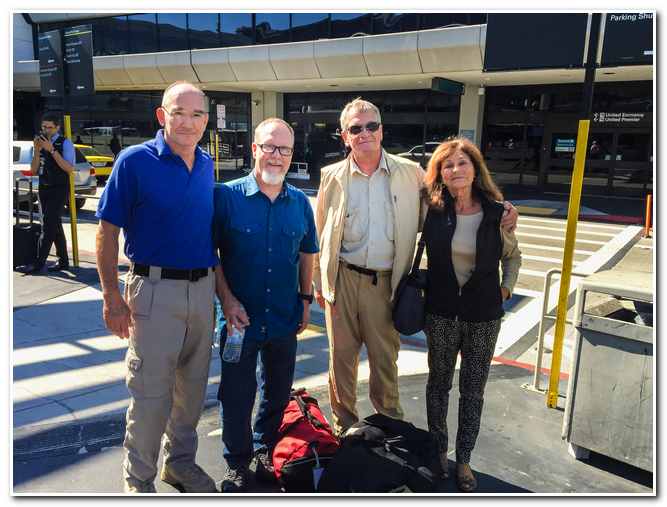
Team assembles together to start the journey. Dwight Trafton, Tim Taylor, Steve Trafton, Katherine Trafton
Team Black Horse all linked up at the San Francisco airport. Following a good steak dinner and restful night at the Airport Marriott, we are up and ready to head to the airport for an 11:00 AM departure to Beijing (12.5 hour flight).
The four member team will stay at the Shangri La Hotel in Beijing and assemble with the other drivers for the rally which begins on June 12th. They said they would be sleeping in used tents and eating watery-gruel. Oh sure…
Visit our page on Facebook @blackhorseracingusa to be notified of regular updates. (https://www.facebook.com/blackhorseracingusa)
Traftons Leave for Peking to Paris Rally
The 9000 mile Peking to Paris Endurance Race is nearing its start date of June 12th! Katherine and Steve Trafton are meeting with brother Dwight Trafton and crew Chief Tim Taylor in San Francisco for the flight to Beijing, China. From there they will drive their two vintage American LaFrance speedsters across the Asian and European continents together with 120 other rally vehicles. See the full route below (click to make it larger):
Their travels will take them through China, Mongolia, Russia, Belorussia, Poland, Slovakia, Hungary, Slovenia, Italy, Switzerland and France. It’s a long Sunday drive of 36 days.
Check back at this site to follow their progress. We expect to have almost daily updates of their trip, with dialog and photos provided by Dwight Trafton. Some locations, of course, have hardly heard of the Internet, so transmission may be somewhat sporadic.
For more background information on the retrofitting of two vintage ALF speedsters for this race, see our previous pages at this site. And for more information on this race, go to the official Endurance Rally Association web site.
Peking to Paris Details
Although some of the Peking to Paris race details are more fully explained on the web site of The Endurance Rally Association, here are the facts about the two vehicle entries from The Black Horse Racing Team and Steve Trafton.
.
.
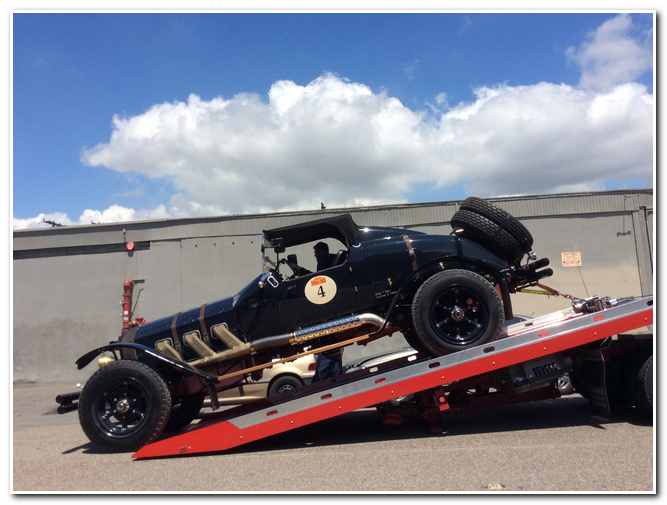
.
.
.
What is the schedule for the Peking to Paris Motor Challenge?
The cars start 1 minute apart. Since Trafton’s vehicles are numbered 1 and 4, they will start the race only 4-5 minutes apart. The route they follow is by map given at the beginning of the race and by GPS in Mongolia.
What other kinds of vehicles are entered?
Why are certain cars favored over others?
How did you decide on this race and why did you choose to move ahead?
As in other rallies, there are timed legs in the race. The winner overall is the car with the least deductions for the timed event.
There are some preparations for mechanical problems, but if a car breaks down in Mongolia it can ruin your day.
The Black Horse Racing Team made a few last minute changes to the two rebuilt American La France Speedsters. They now have cables to easily connect both cars’ batteries together. Why? In case one car needs a jump they can now charge one car without removing the floor and accessing the battery box of the other. They also installed a number of inverters to recharge the cell phones, laptops and camera batteries. Modernity intrudes.
And there were a few creature comforts installed to benefit the occupants who will need to drive 10-12 hours per day in order to complete the 300-400 mile legs.
Although the trip runs about 36 days there are three or four rest days, when drivers can work on their cars or take a rest from driving. There is accommodation in hotels in the larger cities. But what about remote areas?
Although most of the route does not have to contend with security issues, the group is encouraged to stay close to the others when traveling through unknown or potentially unfriendly territory. China, Mongolia, Russia and Siberia are generally safe. Belarus does not have the same negative issues of the Ukraine (and the political situation has changed this years’ route). Driving the larger cities will be more closely monitored. But what about protection from the weather?
We will follow Steve and Katherine, Tim and Dwight’s daily progress and post regular Blog Updates of the journey. Dwight (Ike) Trafton is providing team-updates through email…i.e. when he can access a server. But there are some remote areas that are simply without communication. In Mongolia and Eastern Siberia especially, “broadband” is not a common word. But each car carries a satellite telephone, so in theory an emergency phone-call could be made from any point. If only Marco Polo had known about satellite phones at the time, he could have called ahead for pizza.
Most of the gasoline is trucked in along the route and costs about $6 to $8 per gallon. For vehicles that get 3.5 MPG, have 130 horse power, 1000 pounds of torque, and a weight of 8200 lbs each, this amounts to a lotta fuel.
ALF Leaves for China
The second rebuilt American La France (ALF) speedster was recently tested north of Seattle and made ready for transport to China. The upcoming Peking to Paris Motor Challenge takes place from June 12th to July 17th 2016. Shown below you’ll see the Number One vehicle in that race, driven by Steve Trafton and his wife Katherine. This rebuilt car will travel overland for 9000 miles with another 119 vehicles registered for that road rally. One of two virtually identical speedsters in the BlackHorseRacing team to make the overland journey, both were rebuilt from old fire engine chassis. The other model will be piloted by Trafton’s crew chief Tim Taylor, with Steve’s brother Dwight as the backup driver.
Here, Steve loads ALF#1 into the truck that will carry it to San Diego where it then will be loaded on a ship for China.
(Select first image to see them in closeup.)
Steve Trafton Interview
Mark Greene recently did a comprehensive audio interview with Steve Trafton on Mark’s 5-day a week podcast for www.CarsYeah.com. The interview covered Steve’s many extreme life-adventures, his land speed record, plus his business career and interest in cars. If you’d like to hear what he had to say, follow this link.
Off To California For Road Testing
Watch these short video clips as Steve Trafton describes the vehicle that he is road testing before the Peking to Paris Motor Challenge Race in the summer of 2016.
Other questions are answered in audio clips below.
What do you expect to learn from this road test?
Why do you have two separate vehicles?
What’s the progress on the second one?
You mentioned both your brother Byron and your wife Katherine being with you for road testing.
Were there problems that you did not anticipate?
Are there major parts that you have fabricated yourself?
Give me the general specifications for the vehicles.
What has happened in this road test that you didn’t expect ?
On the next blog, more questions will be answered about why the Peking to Paris Motor Challenge was chosen.



